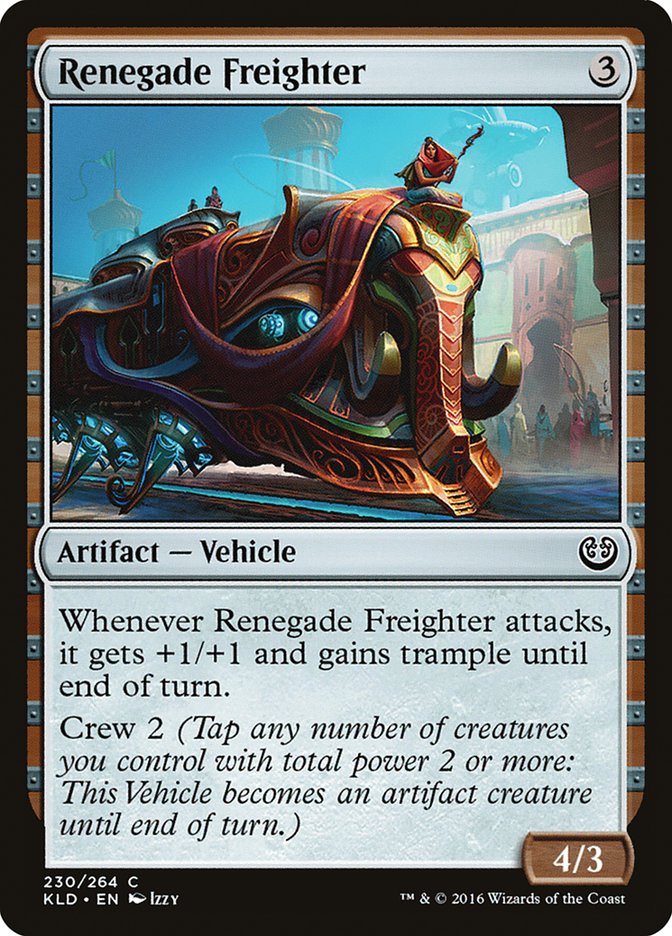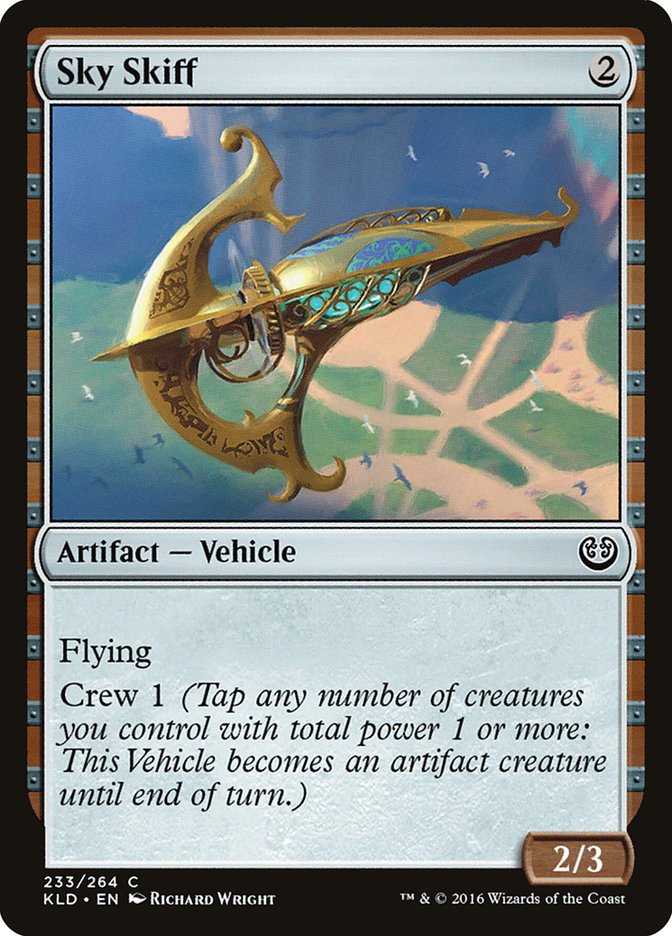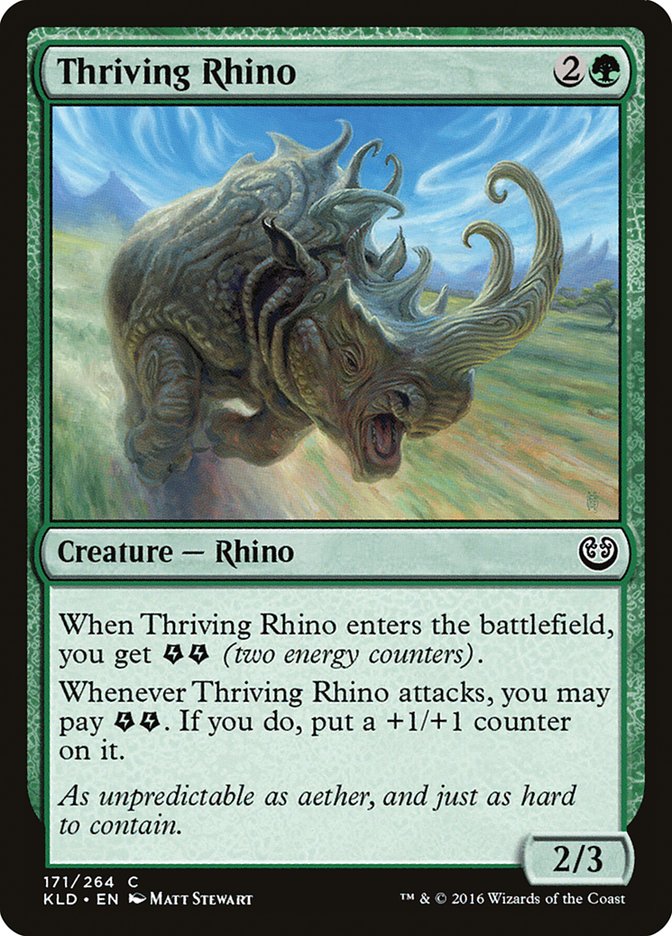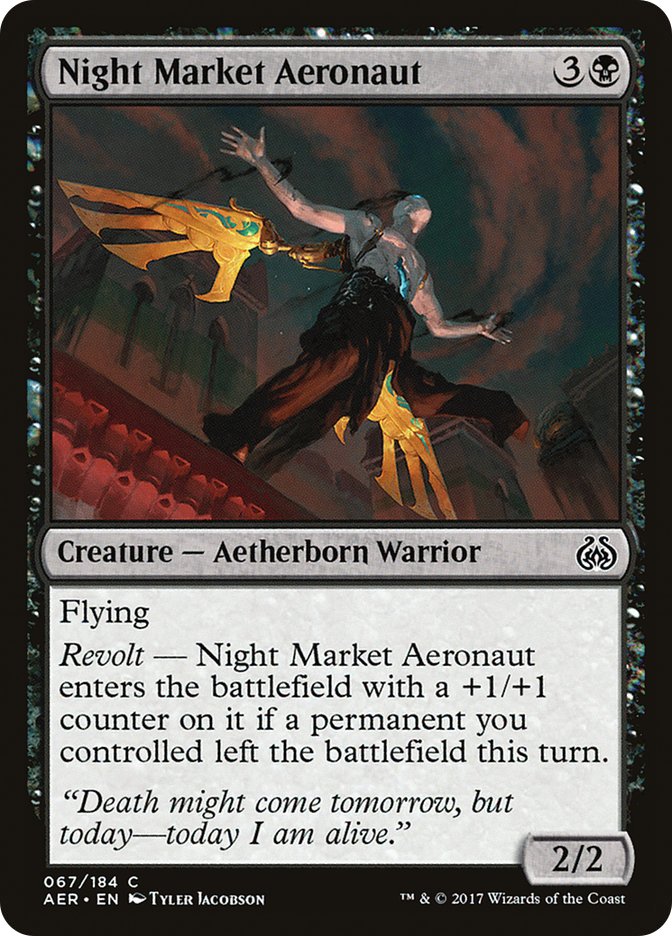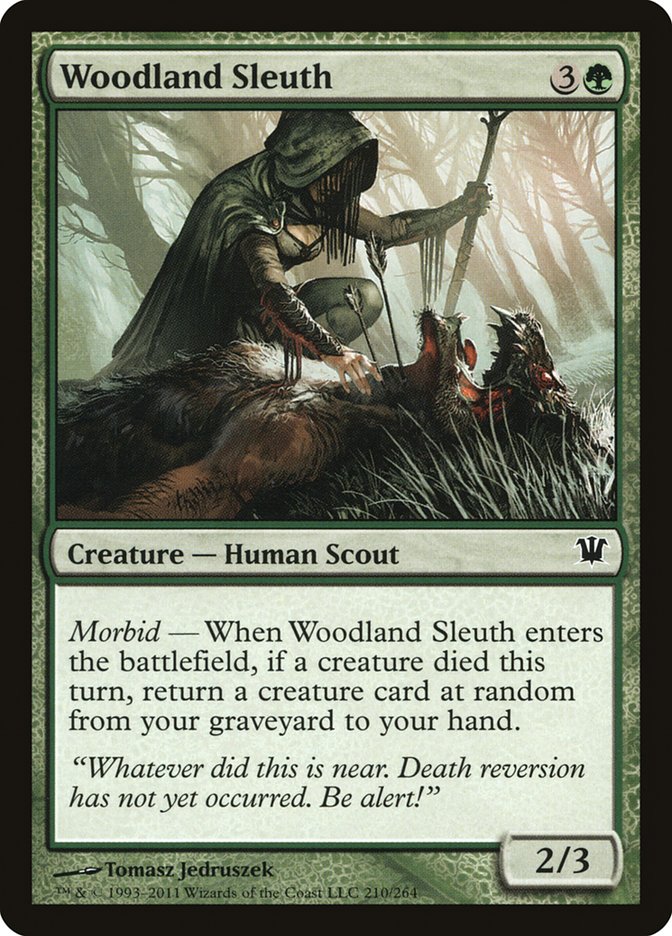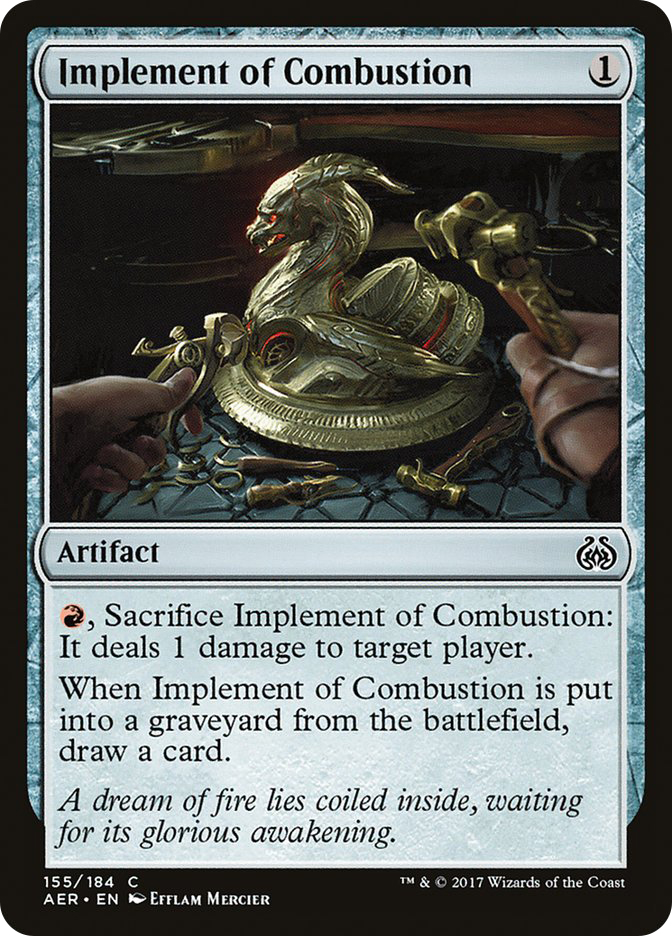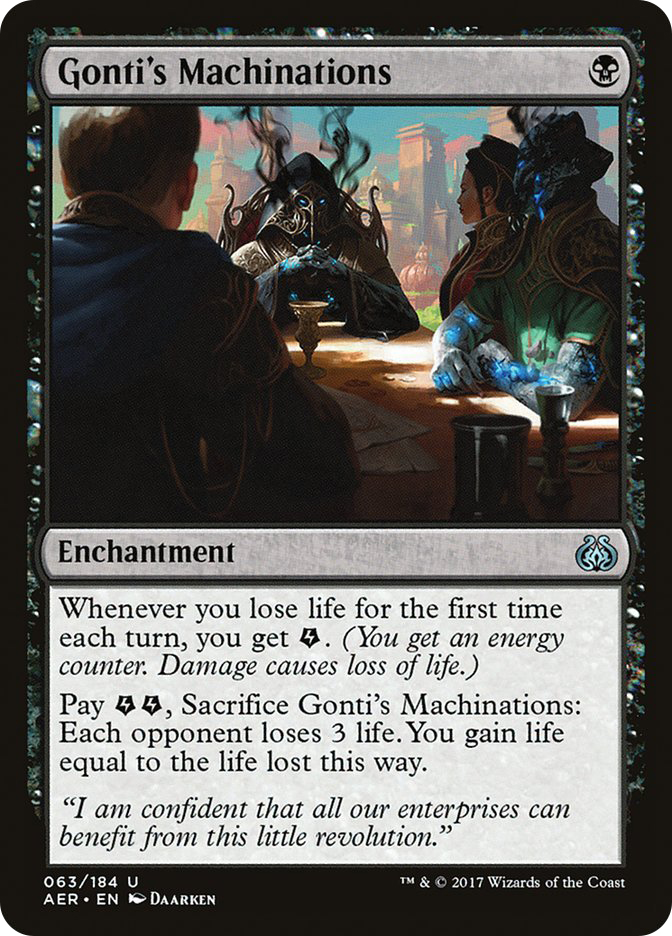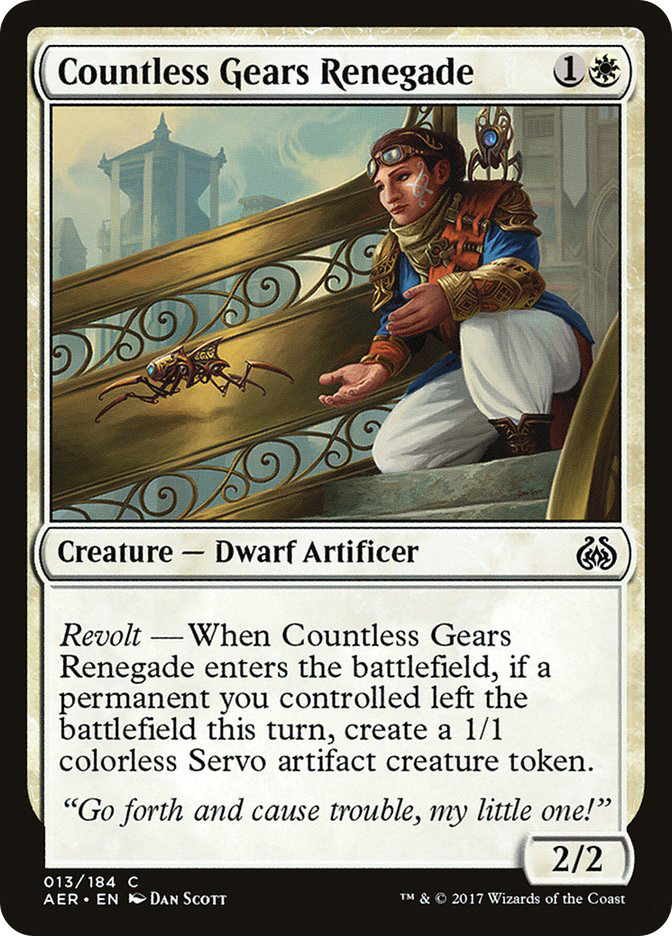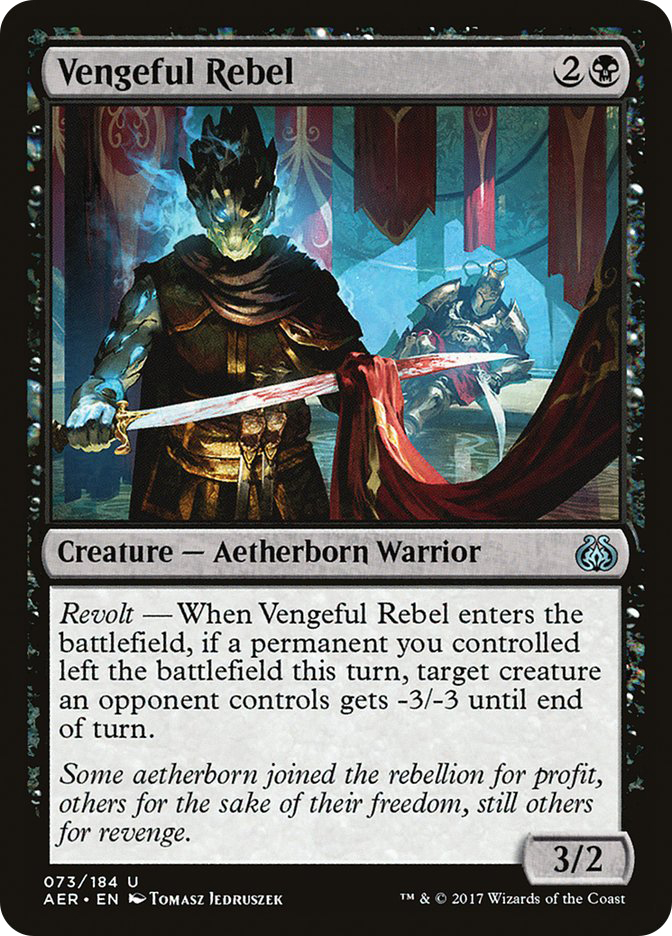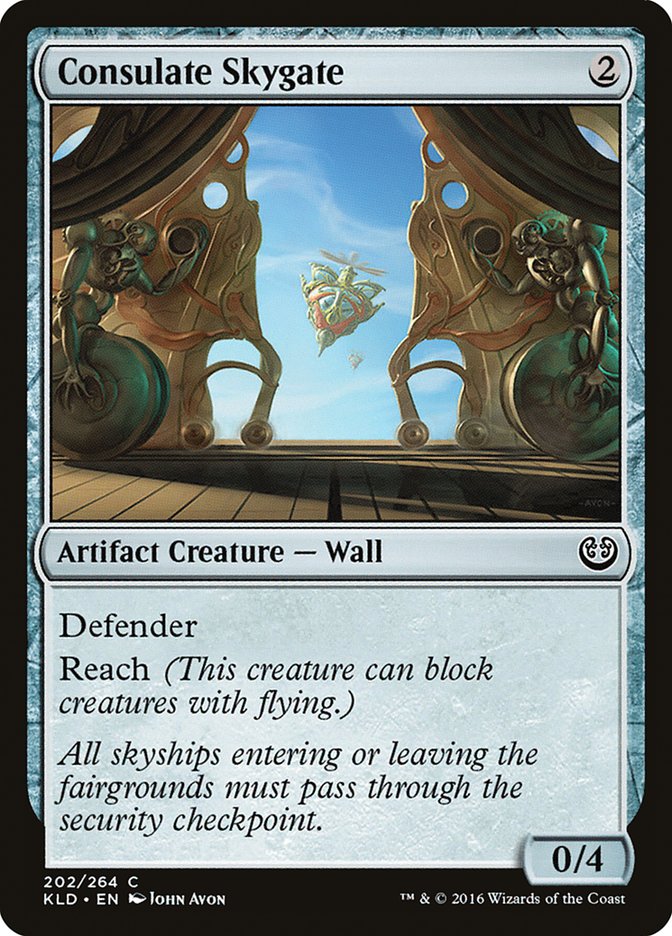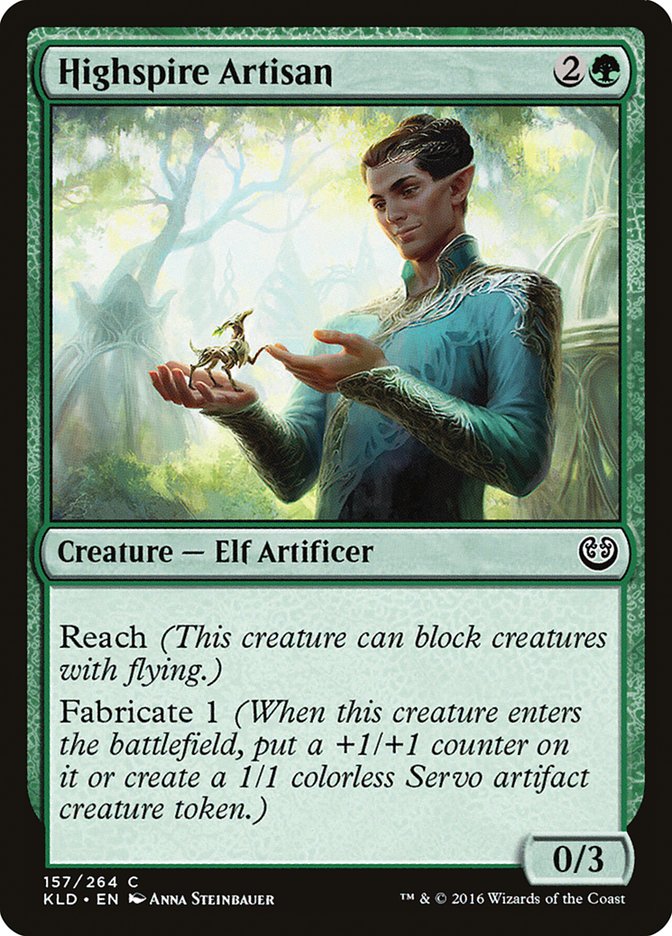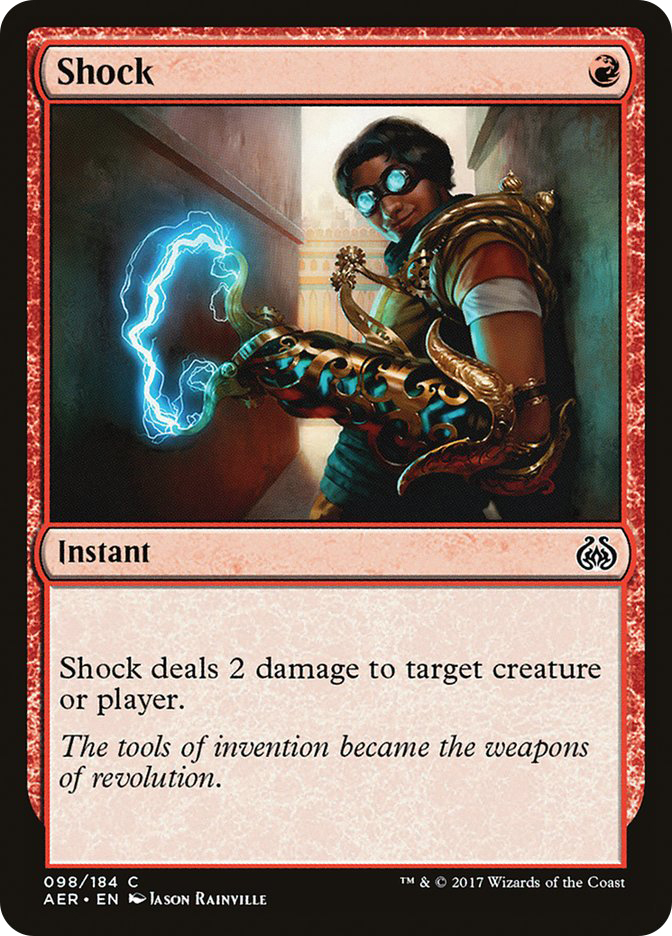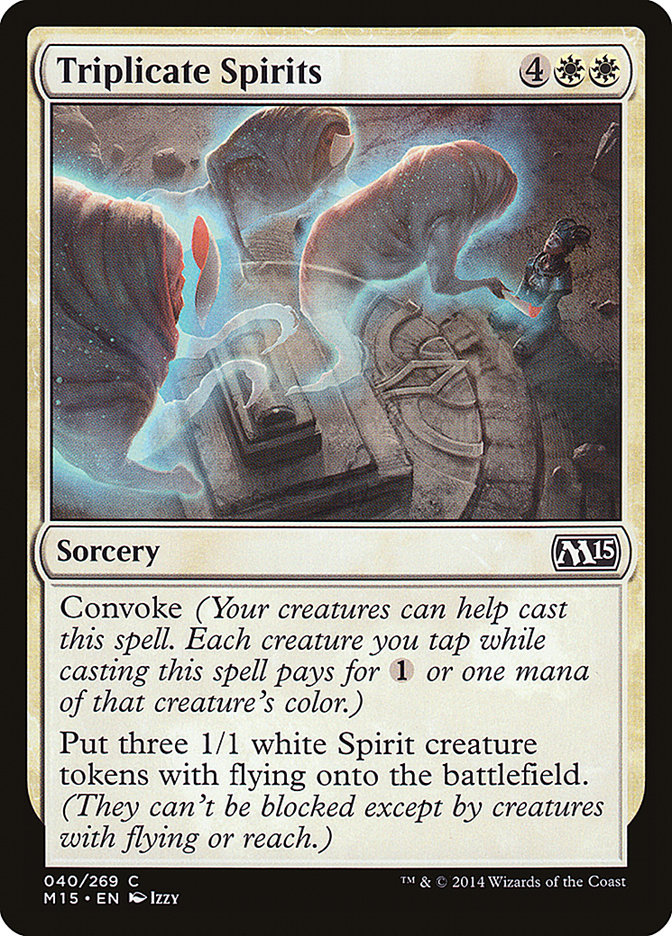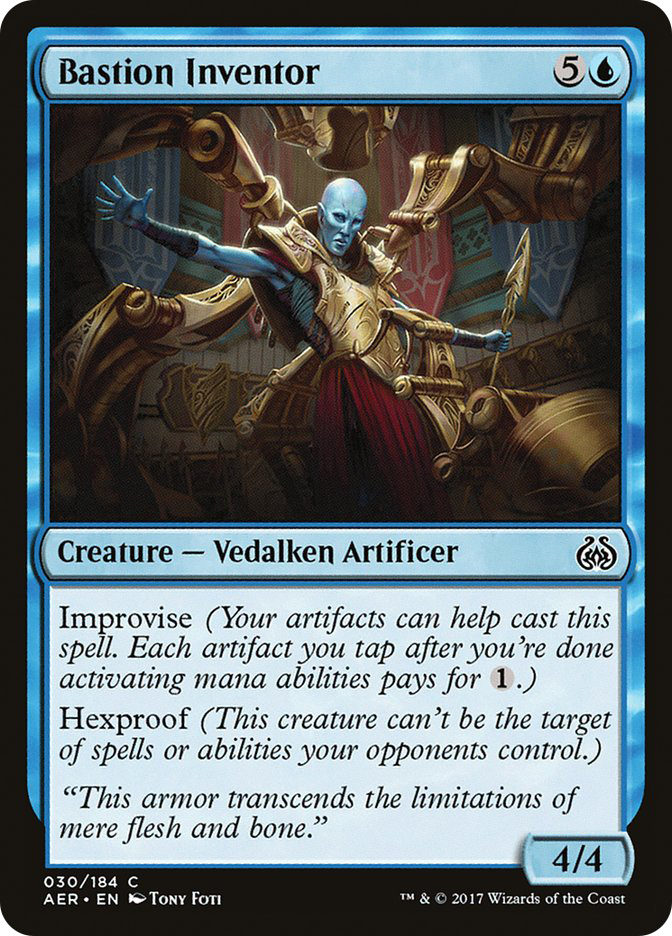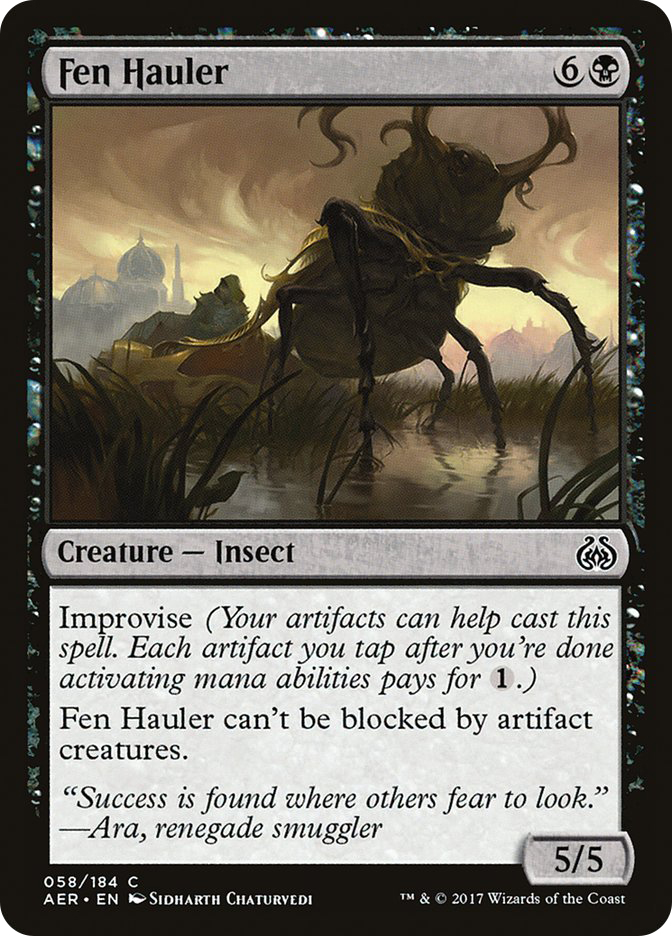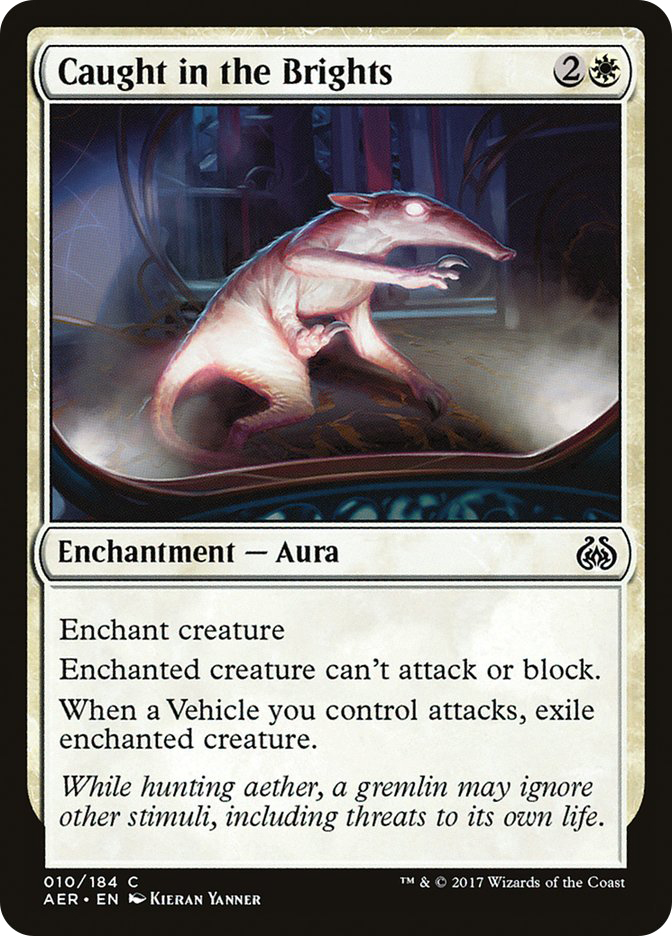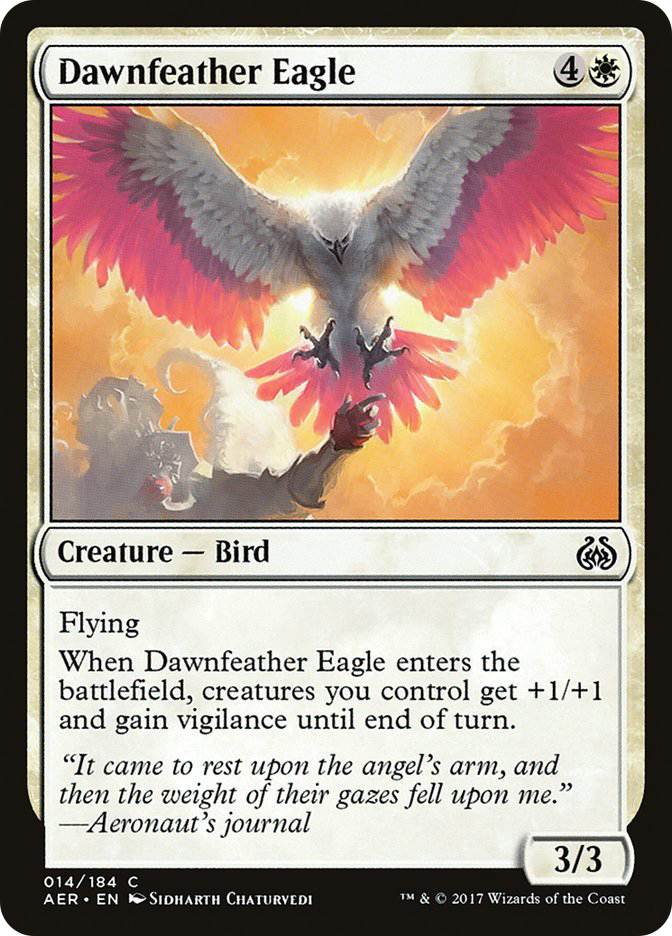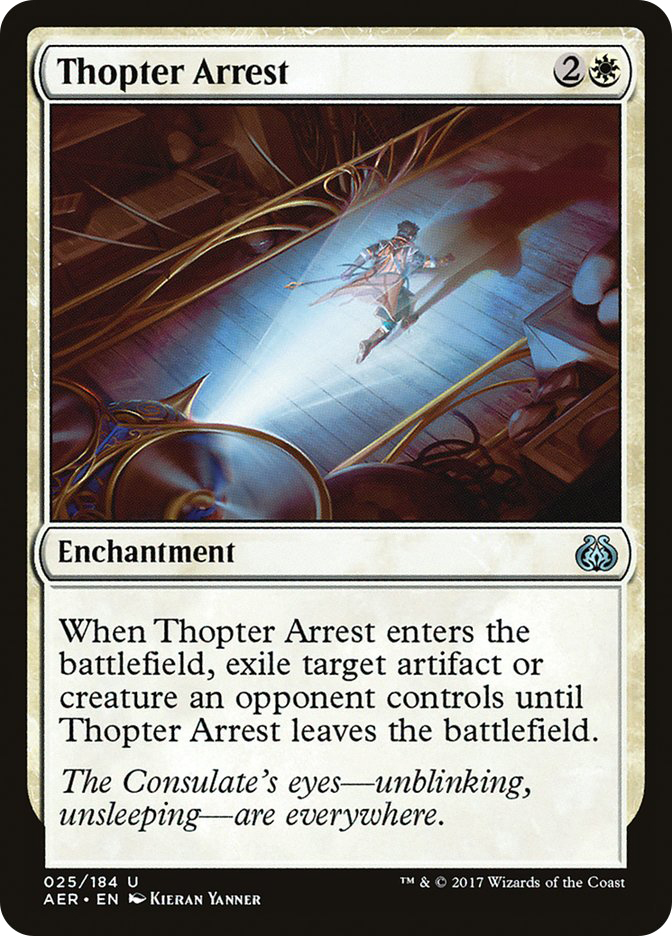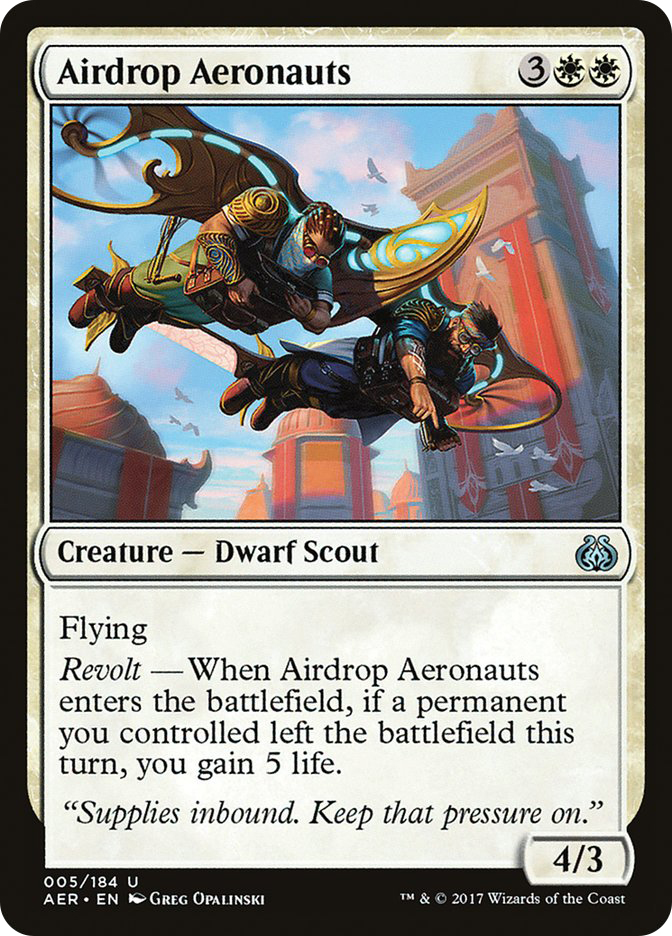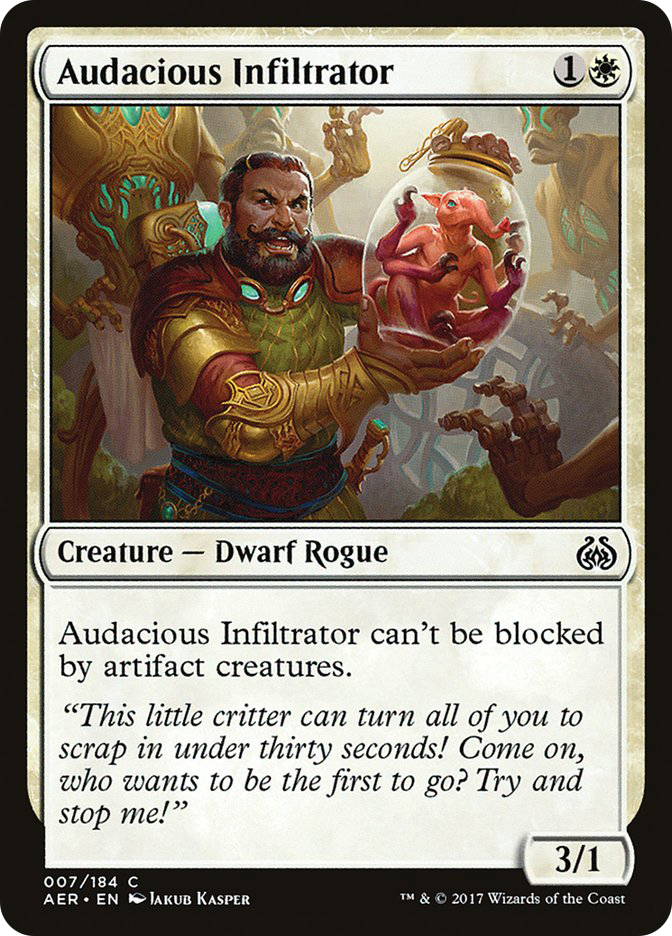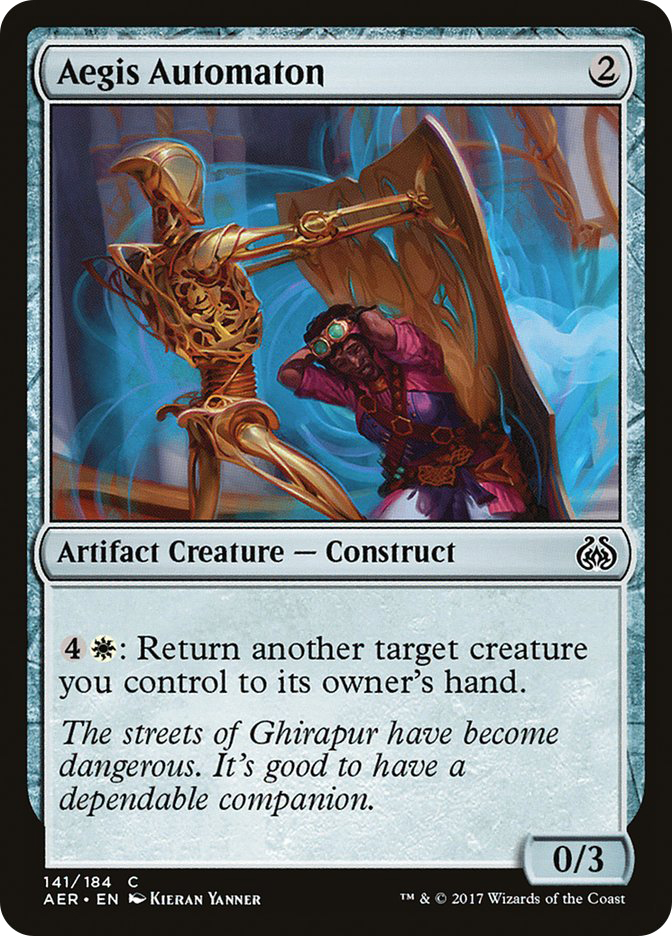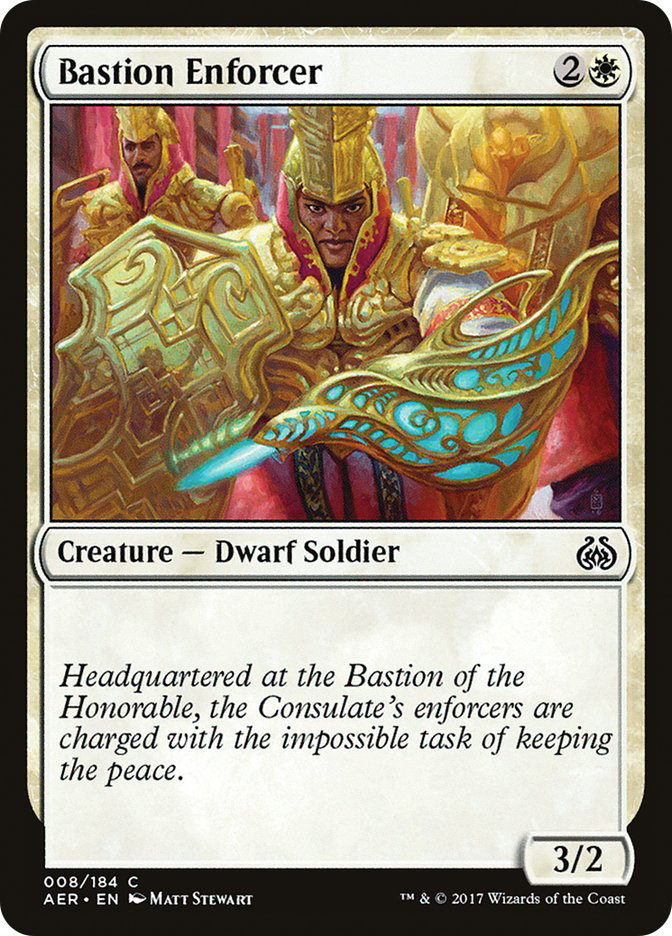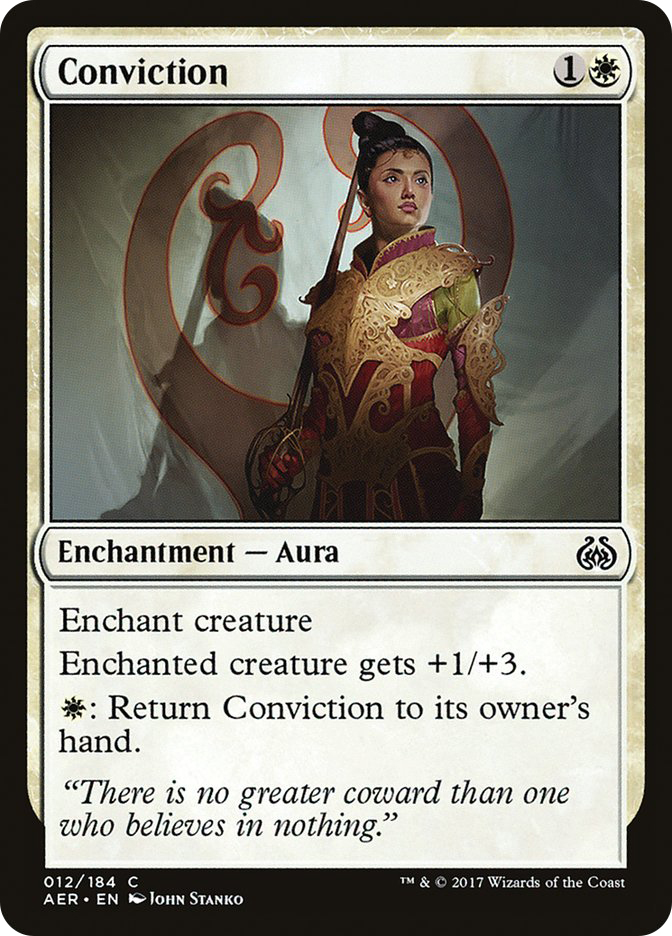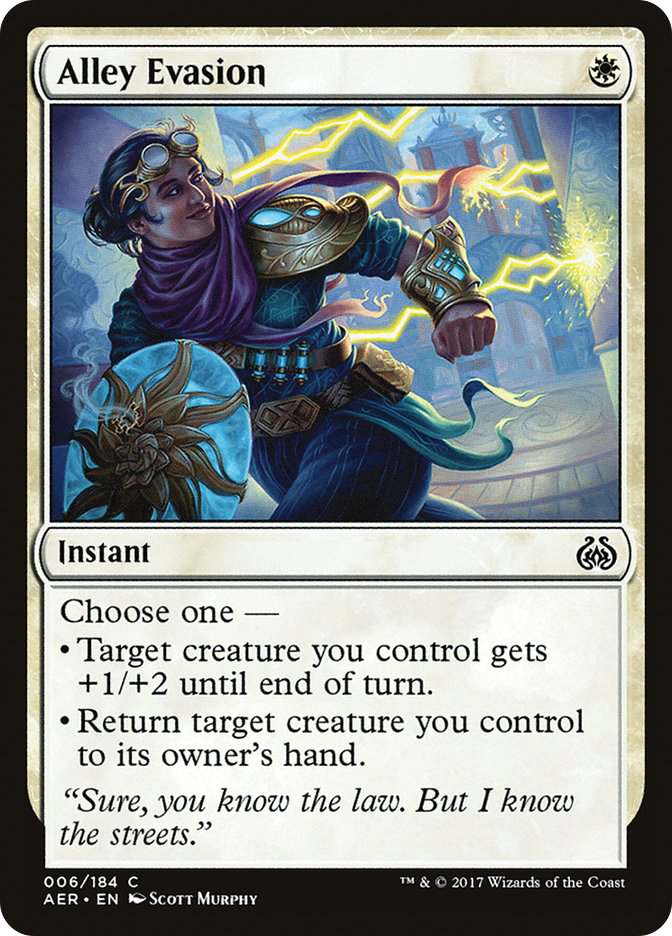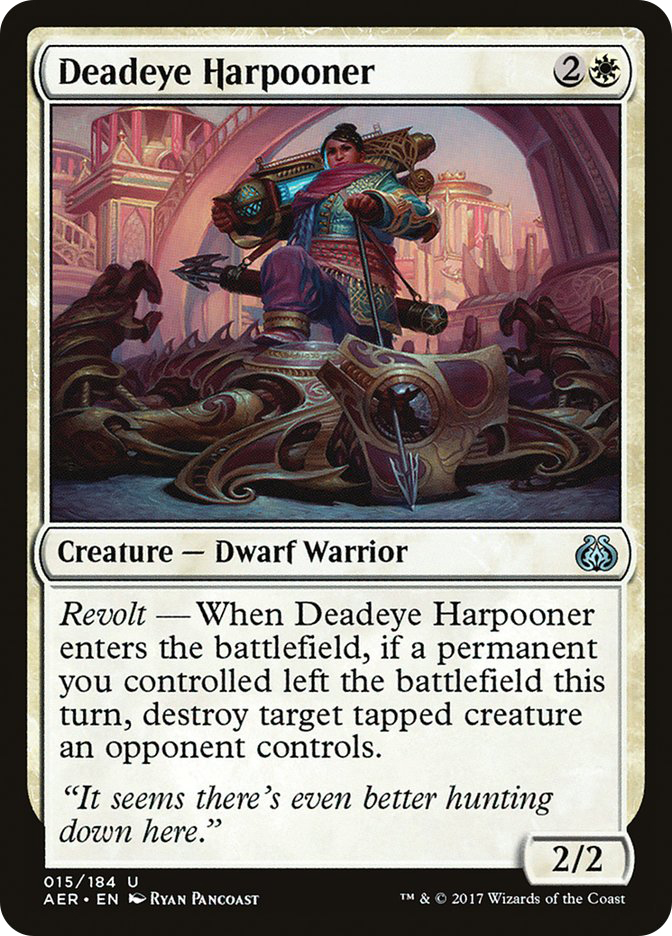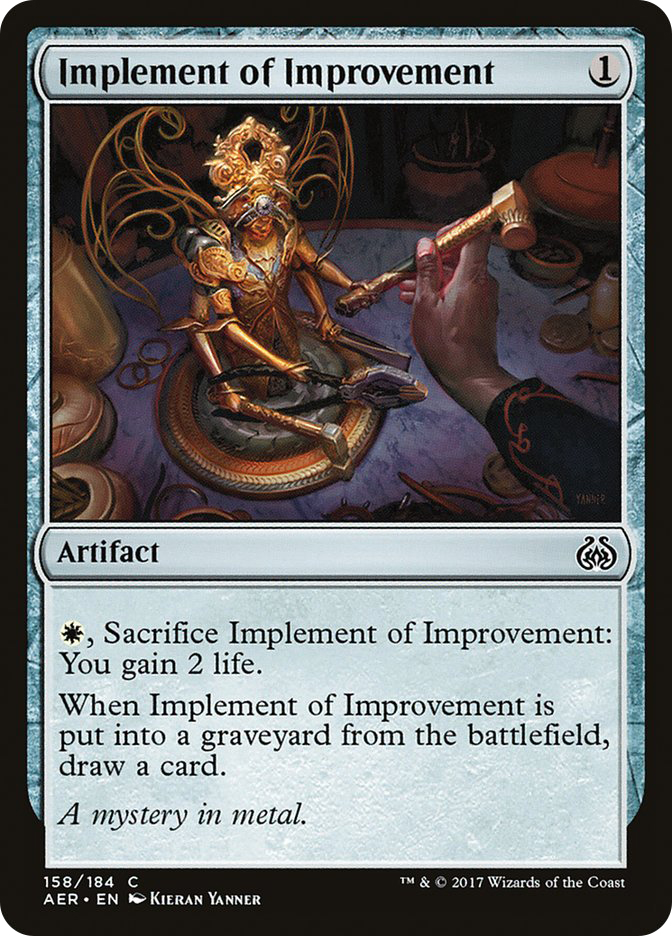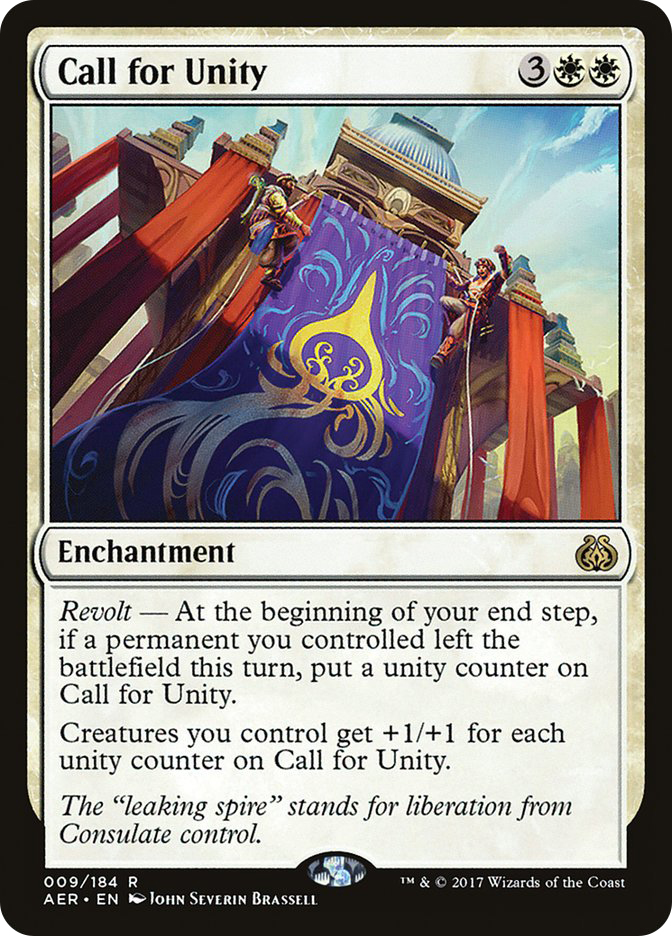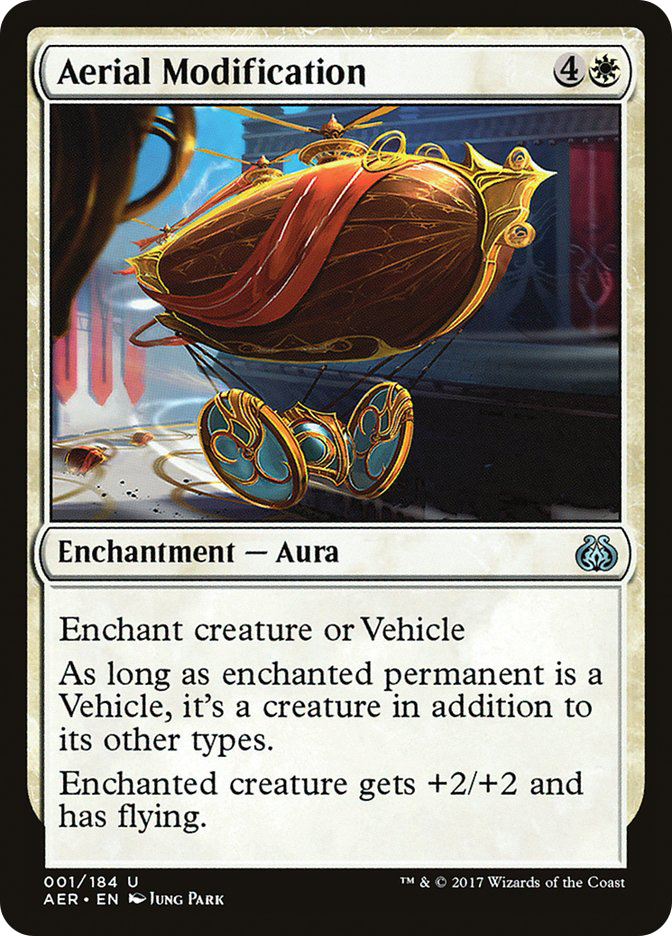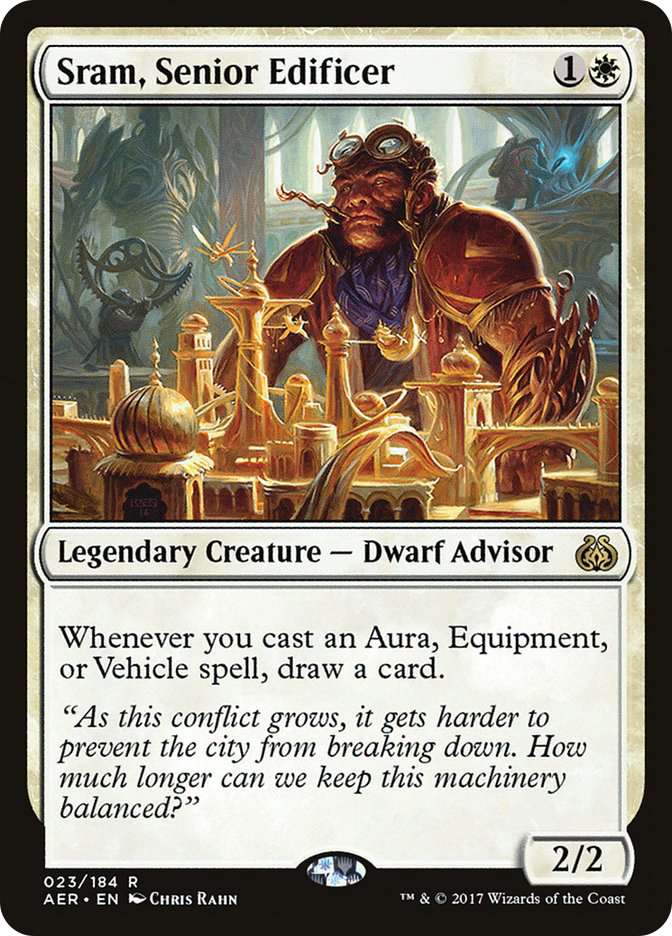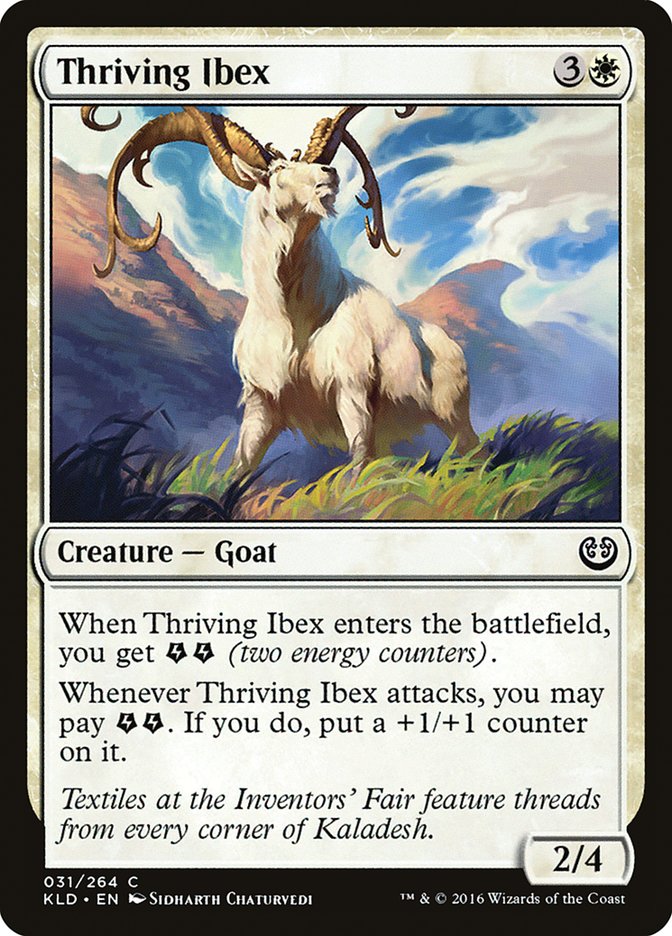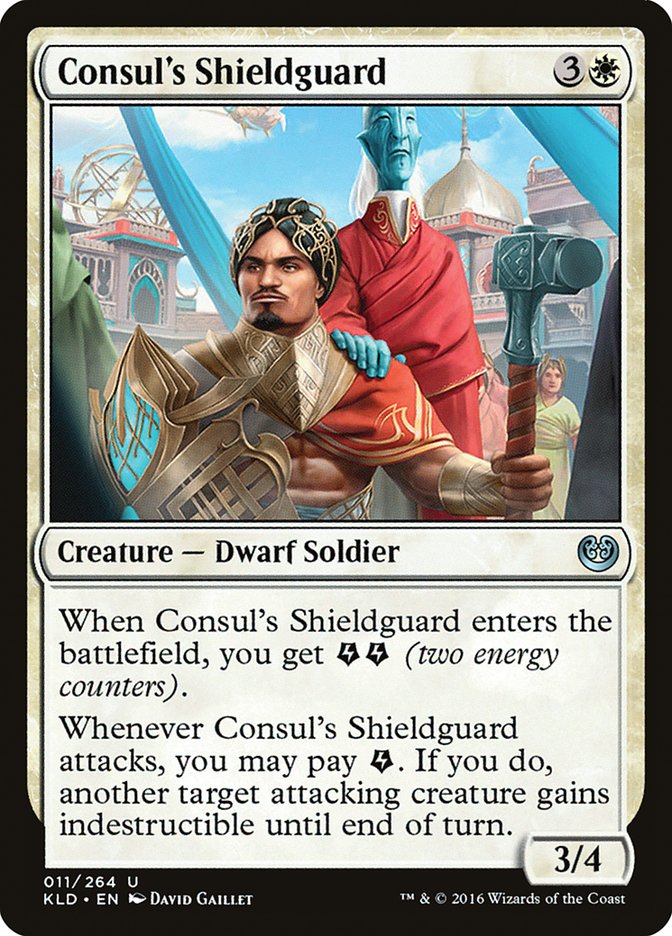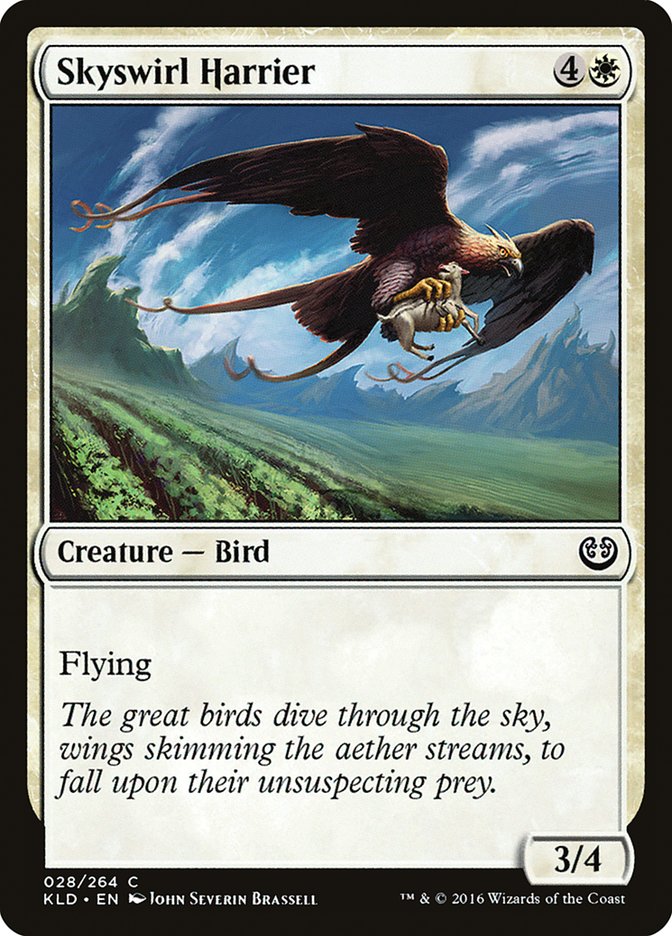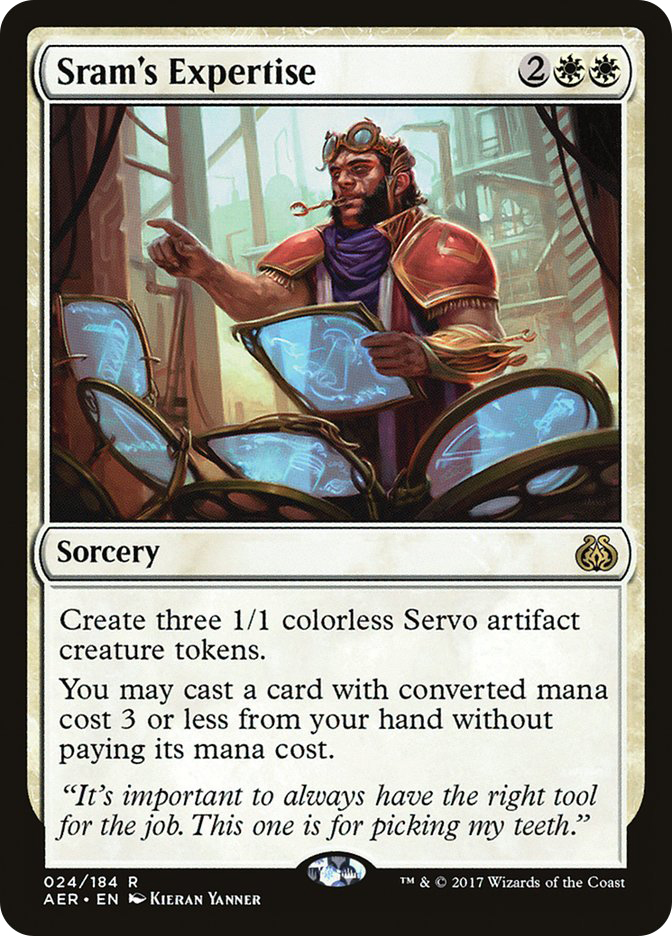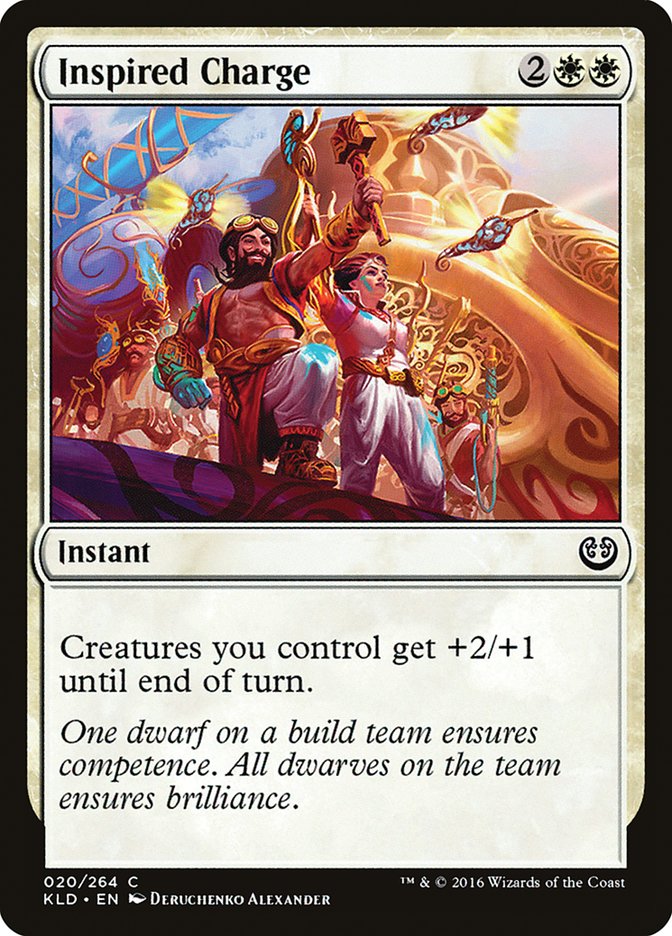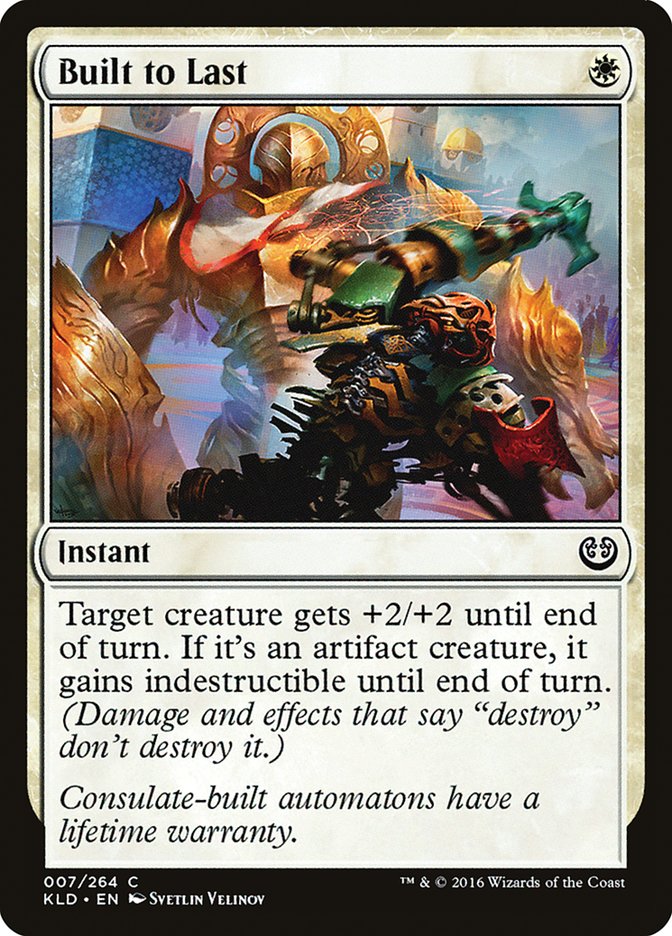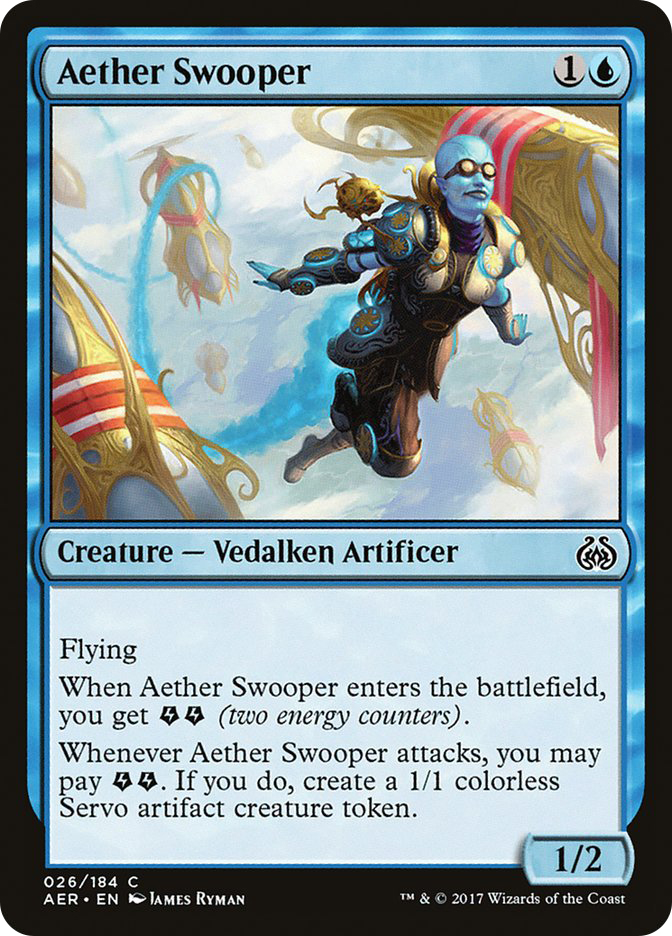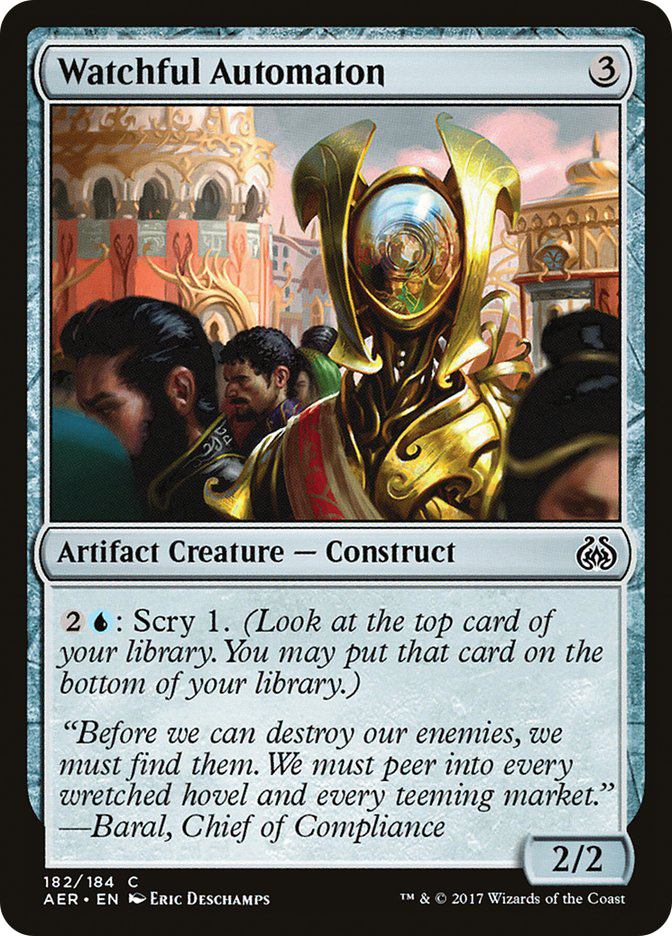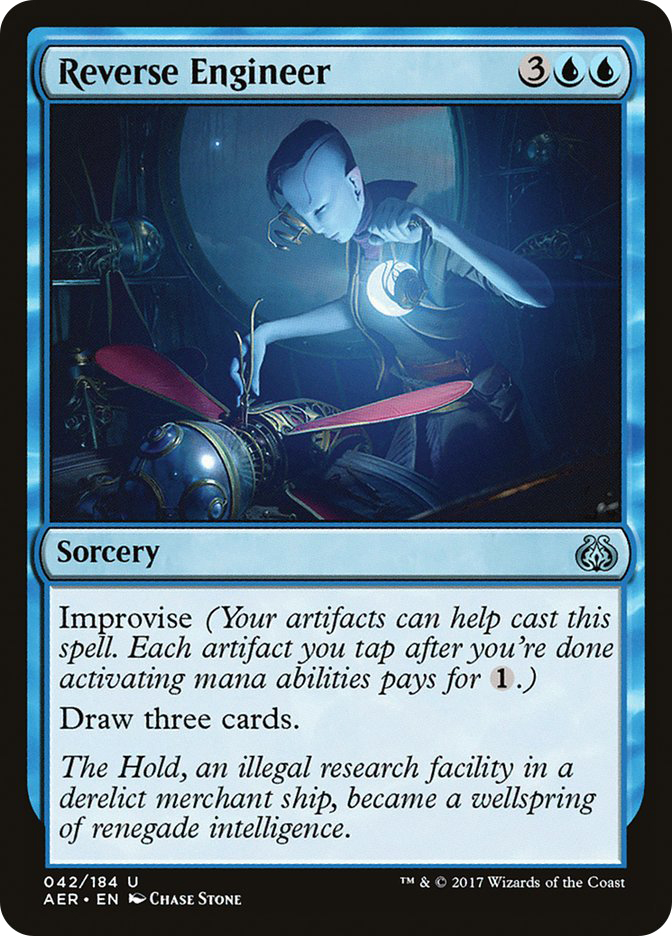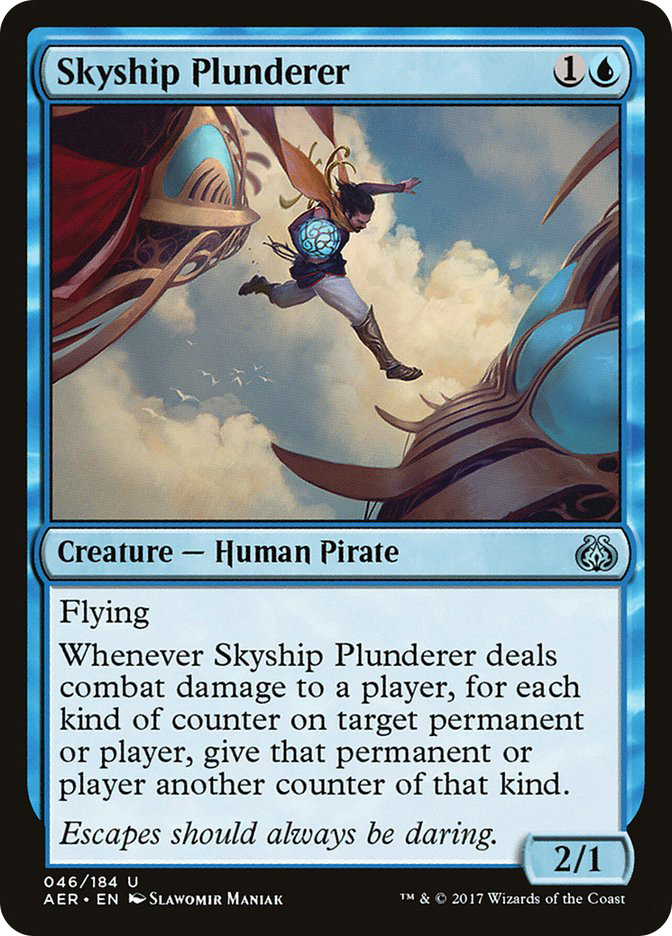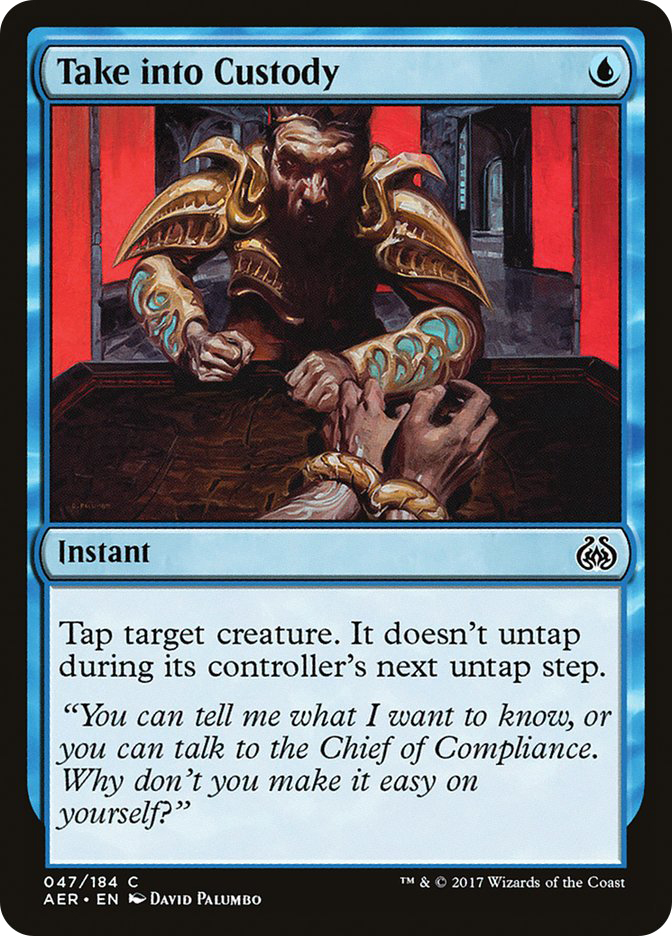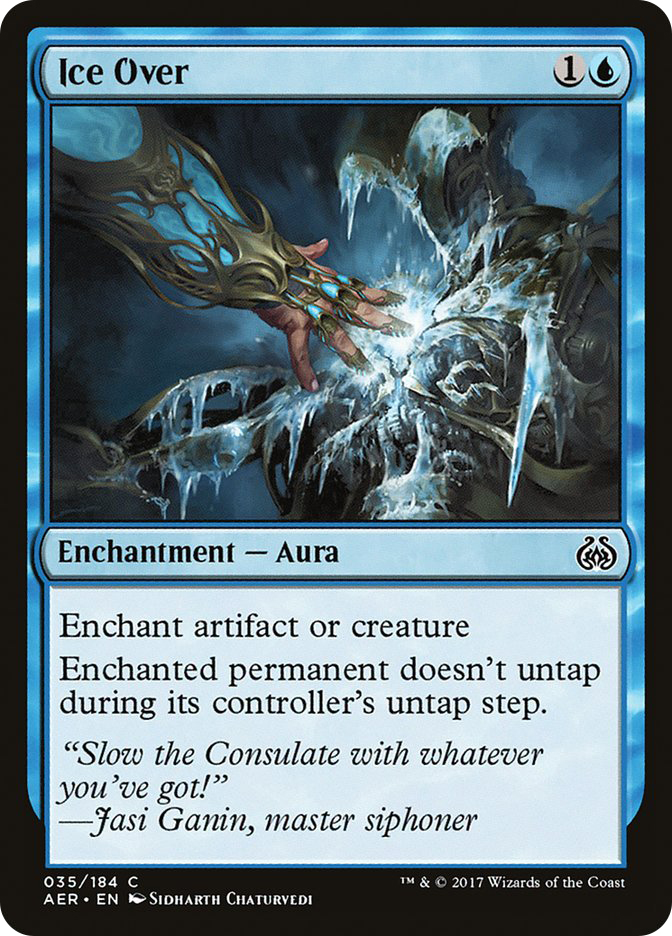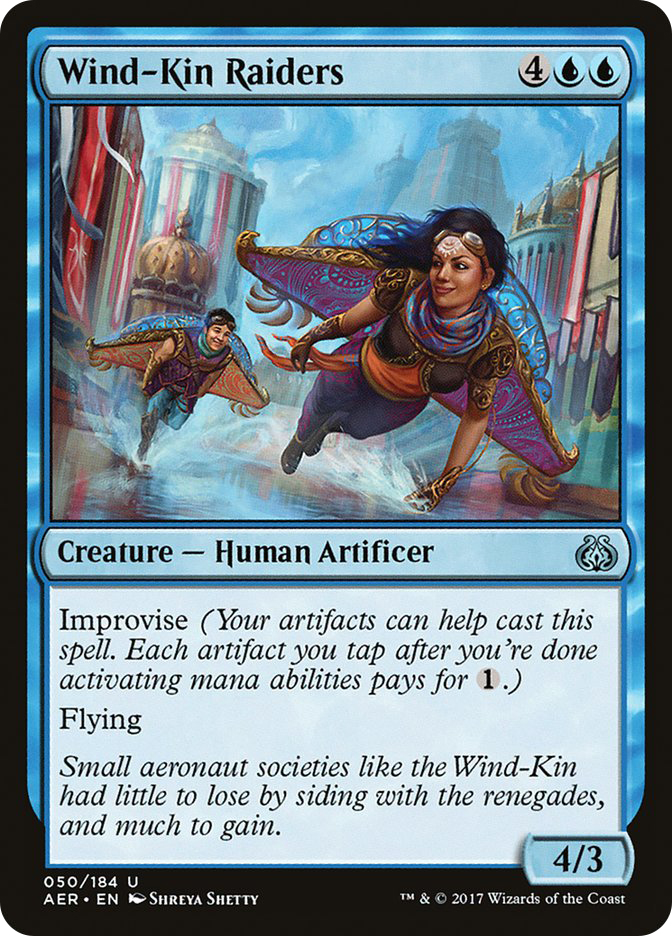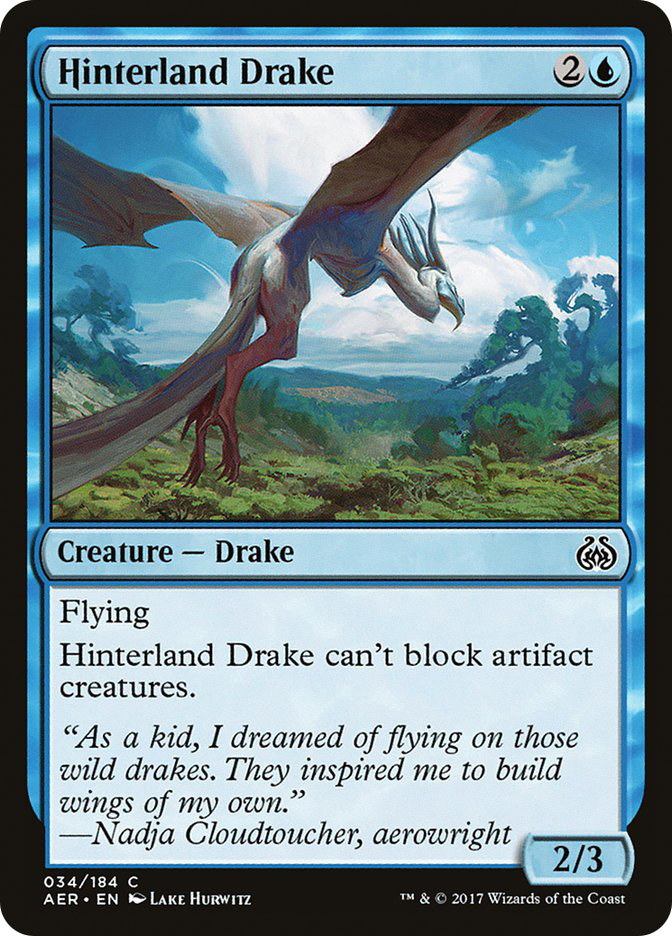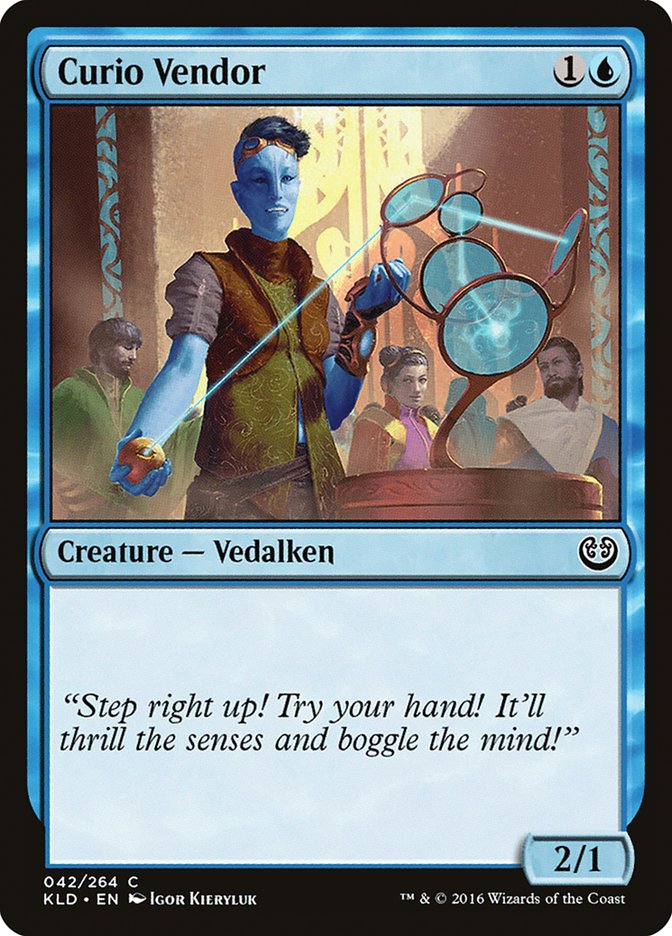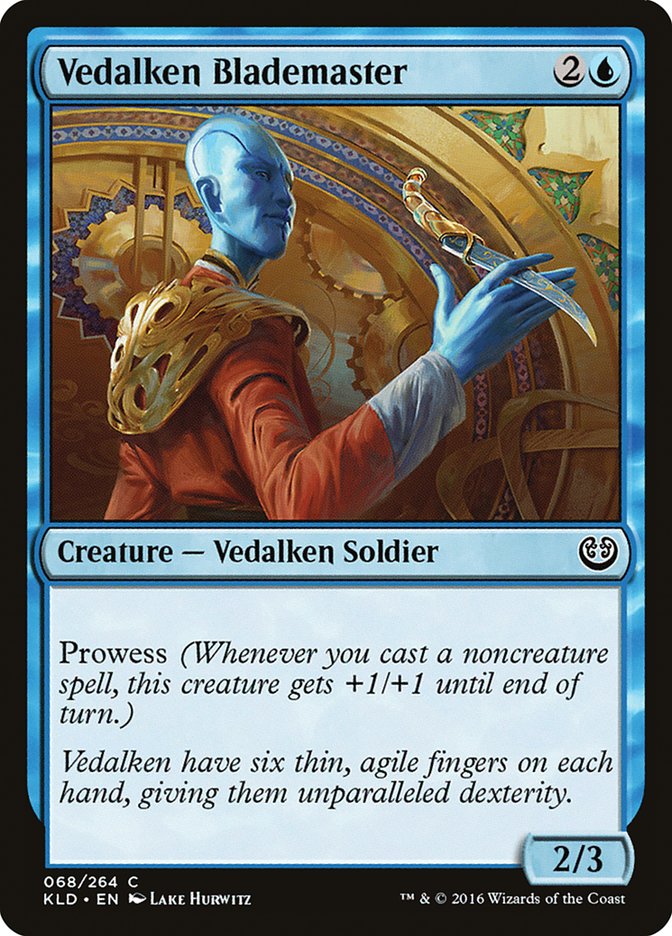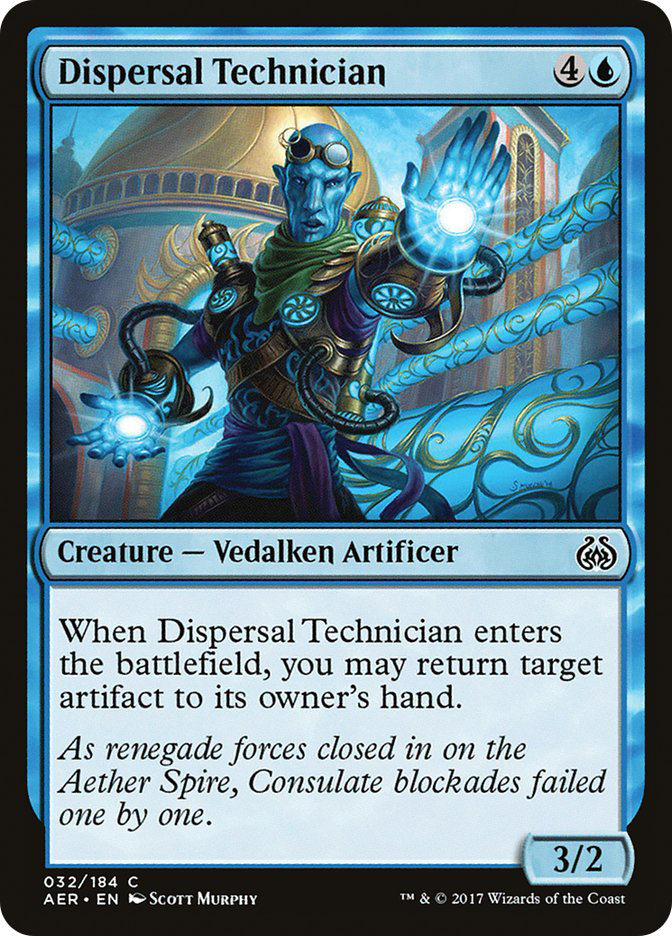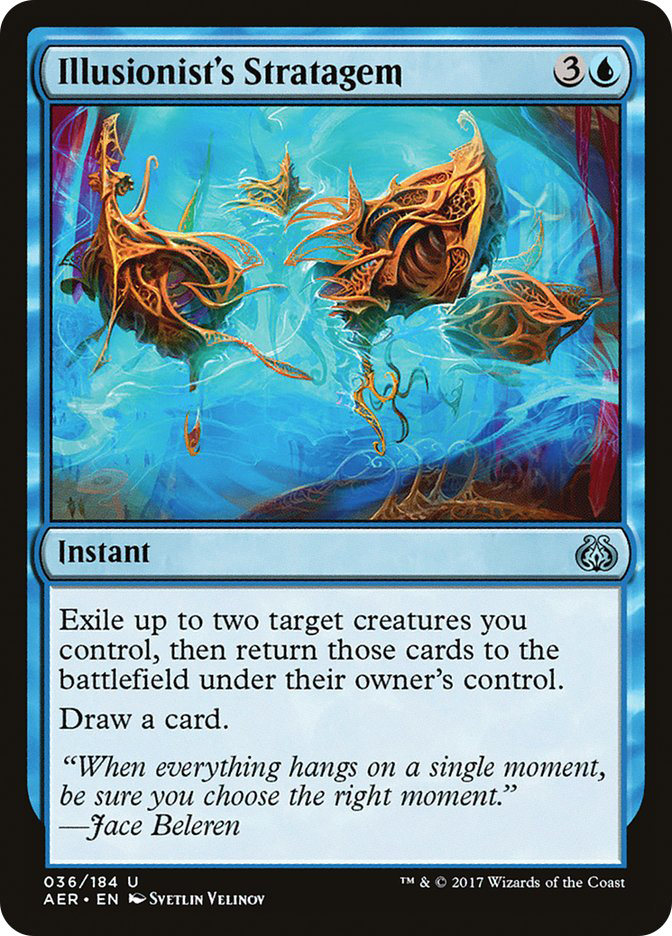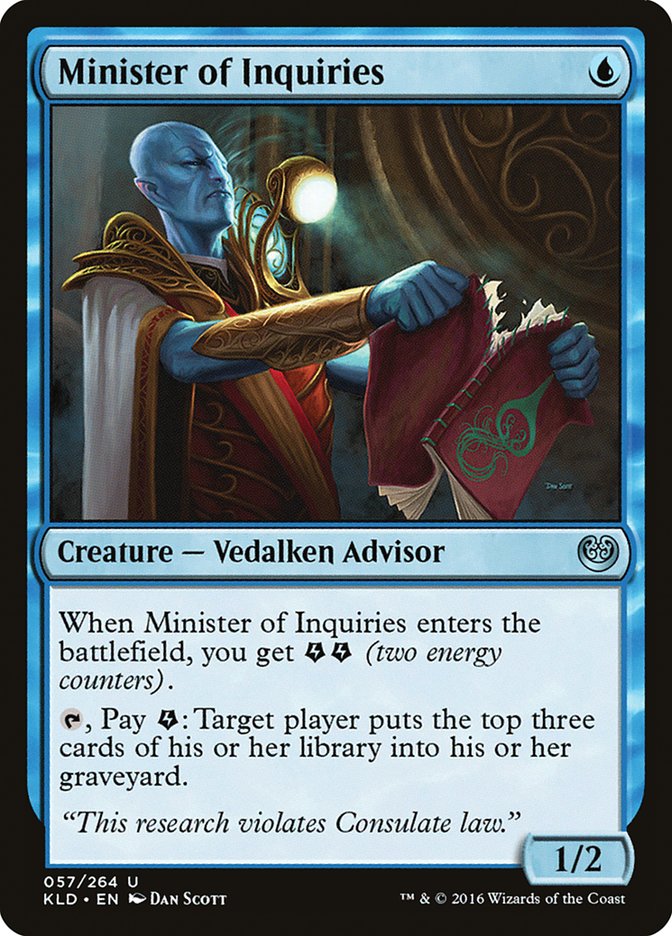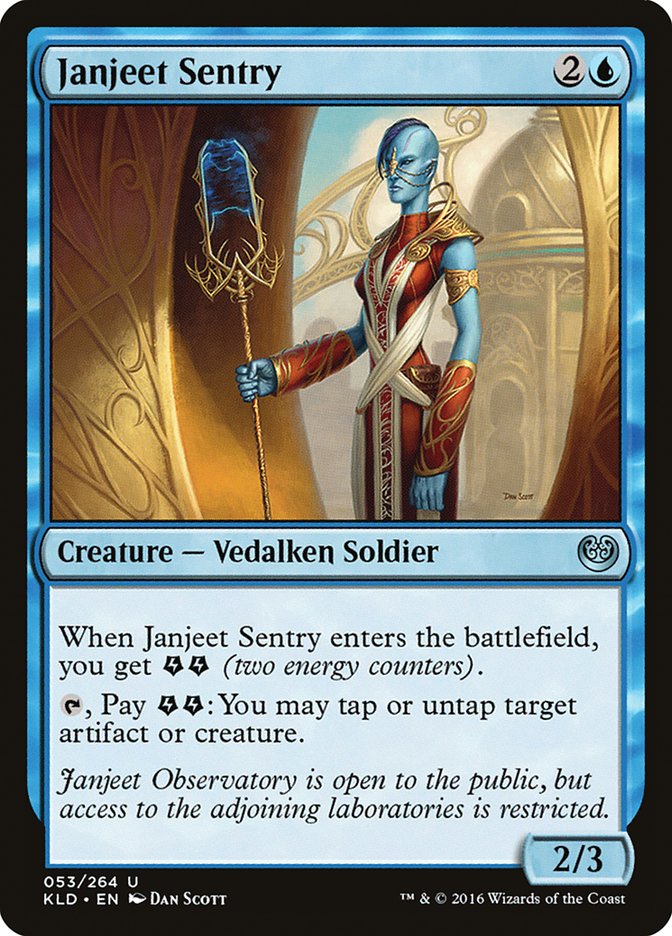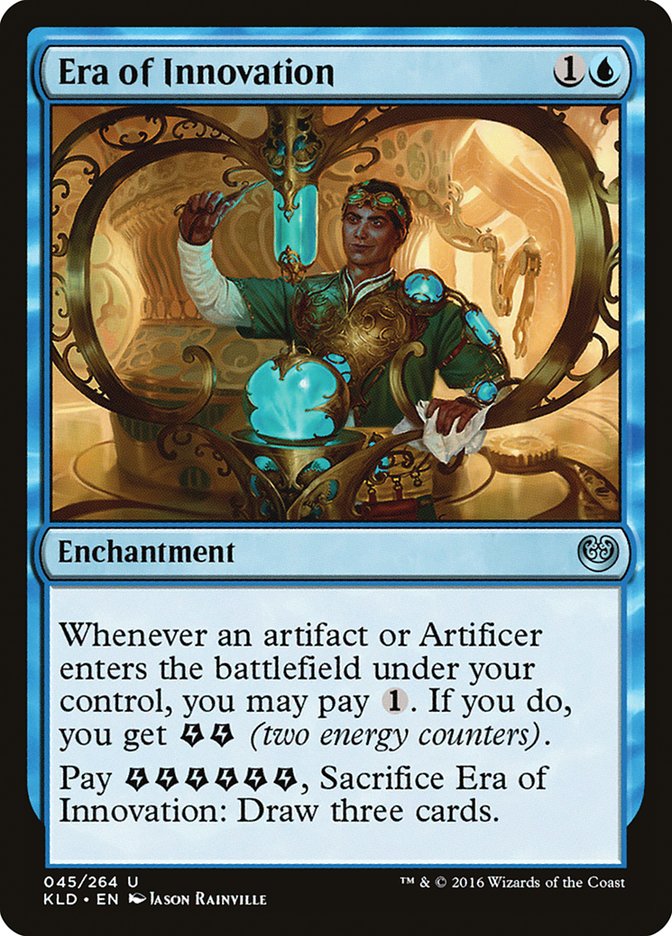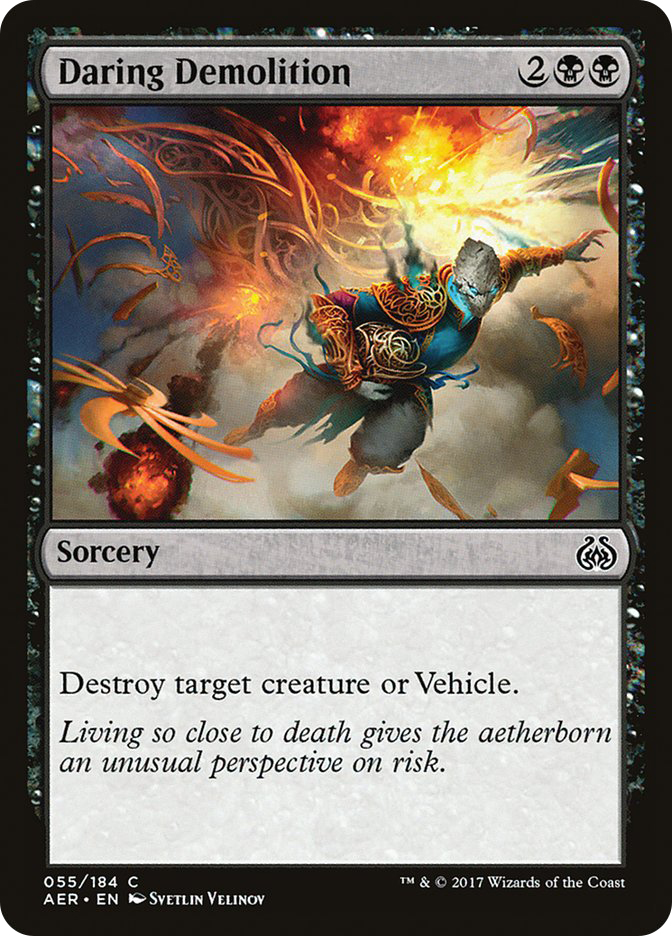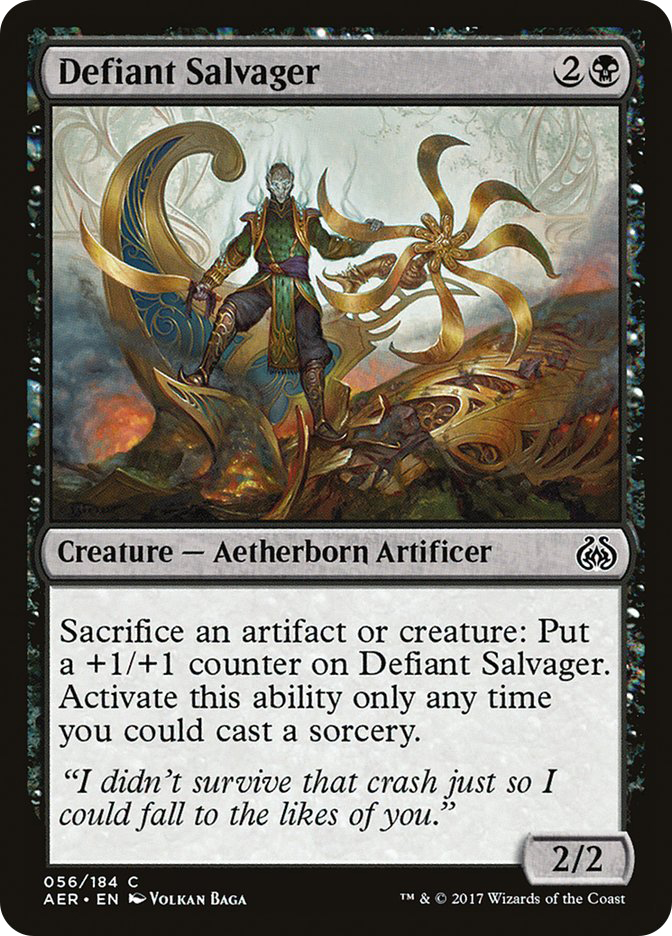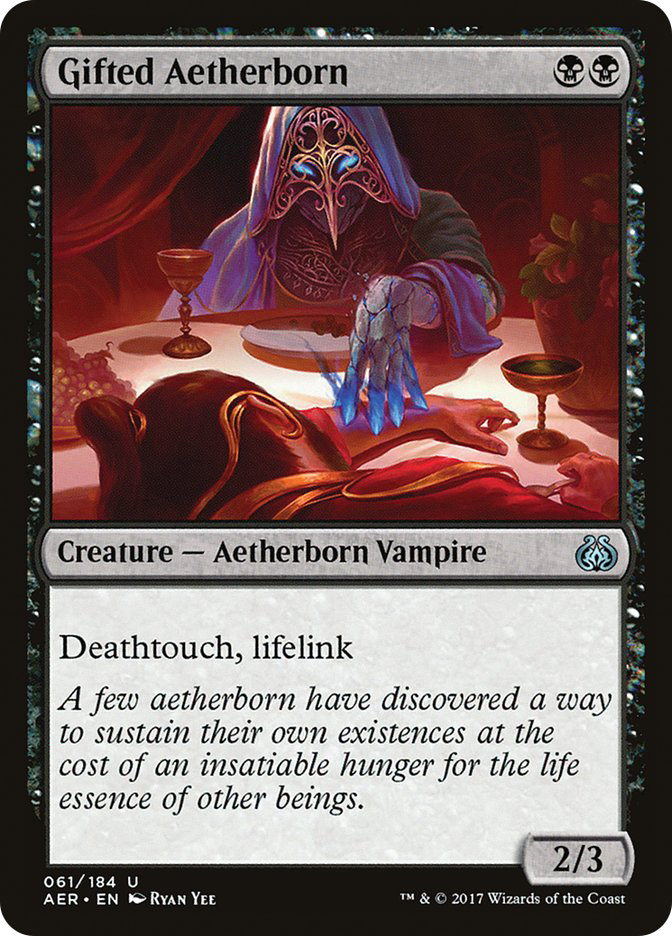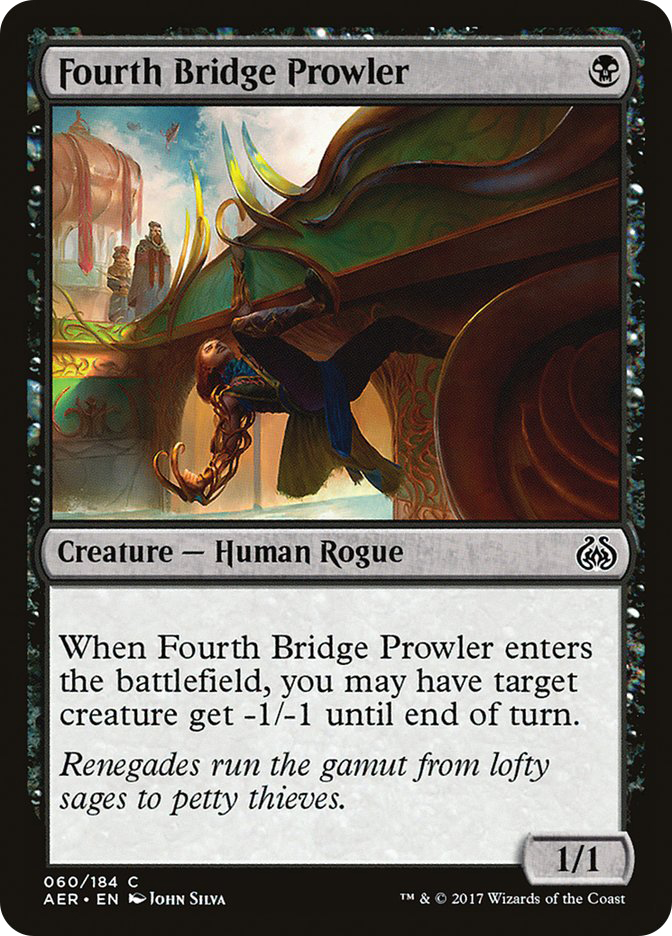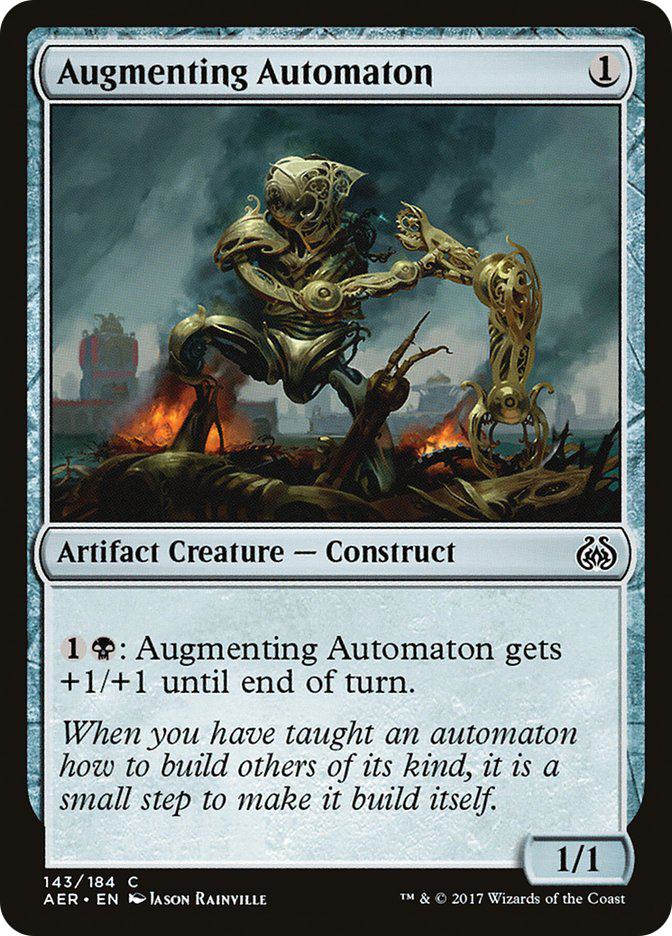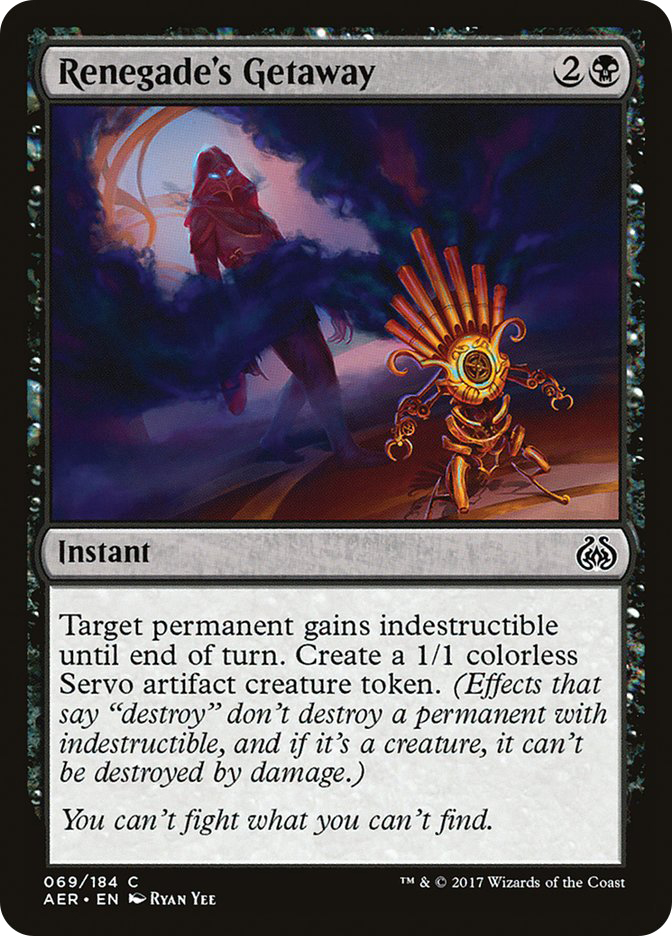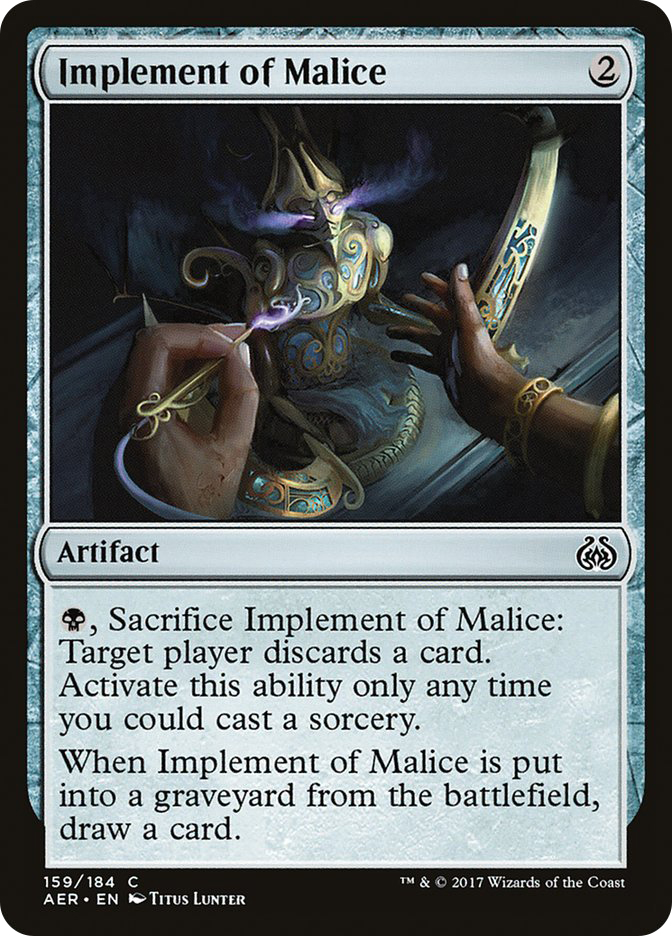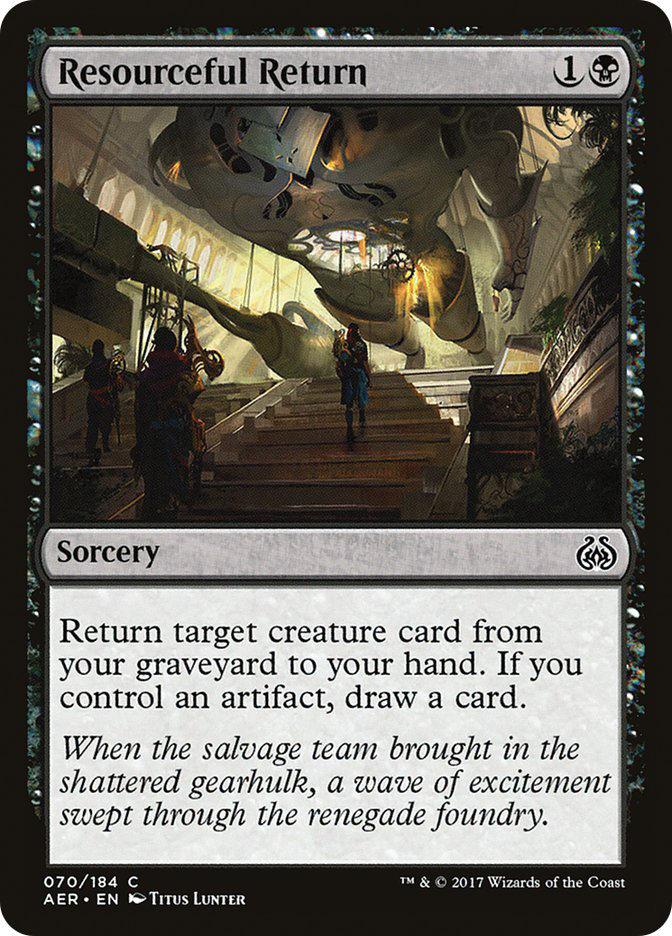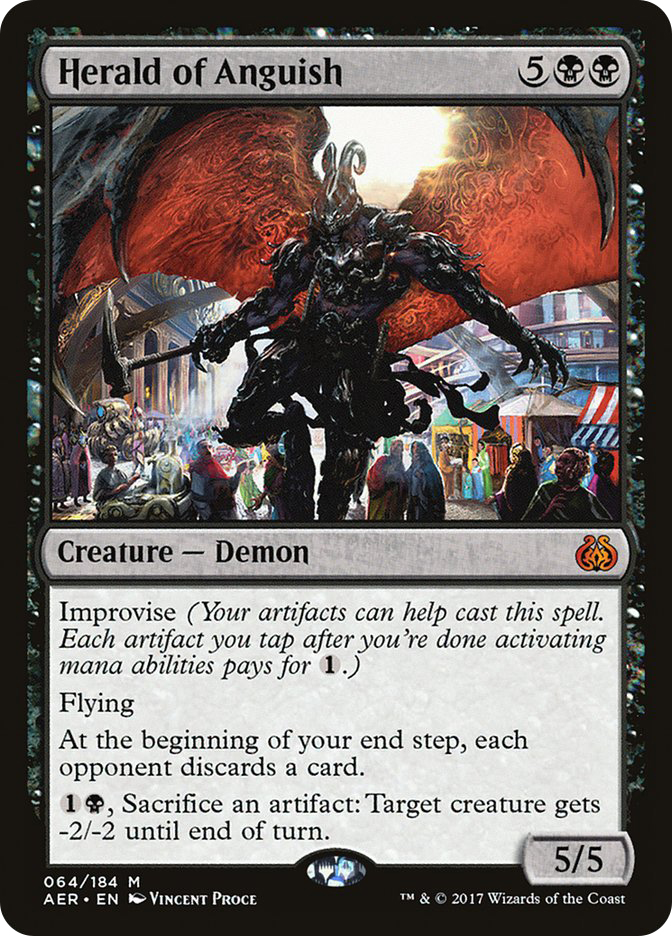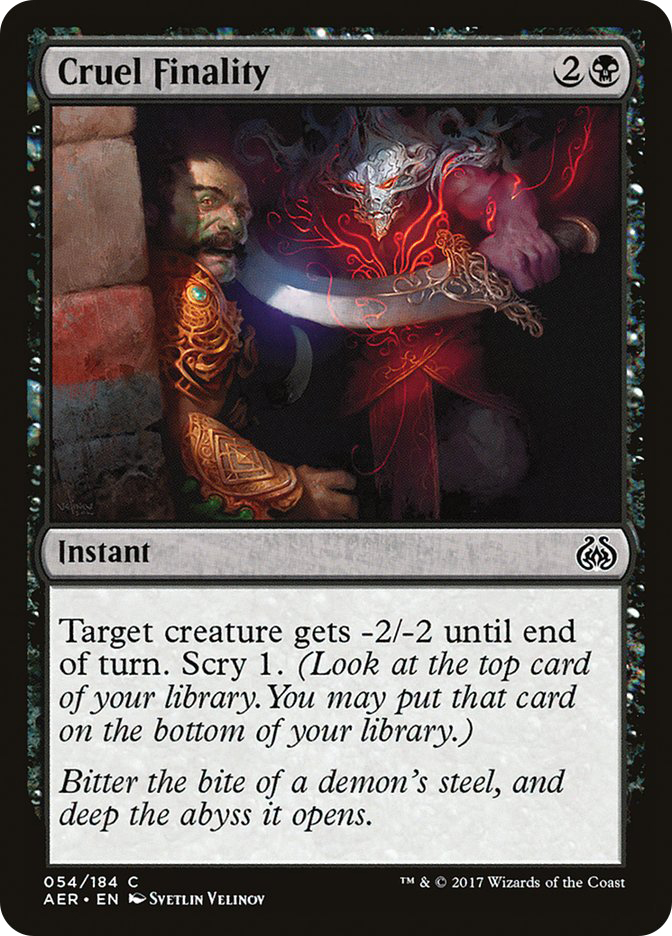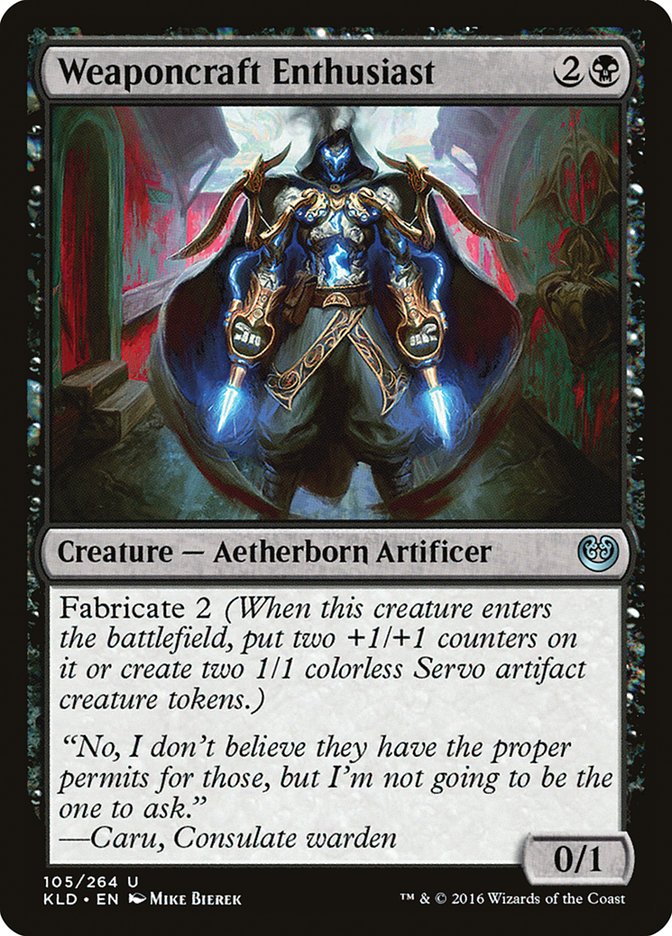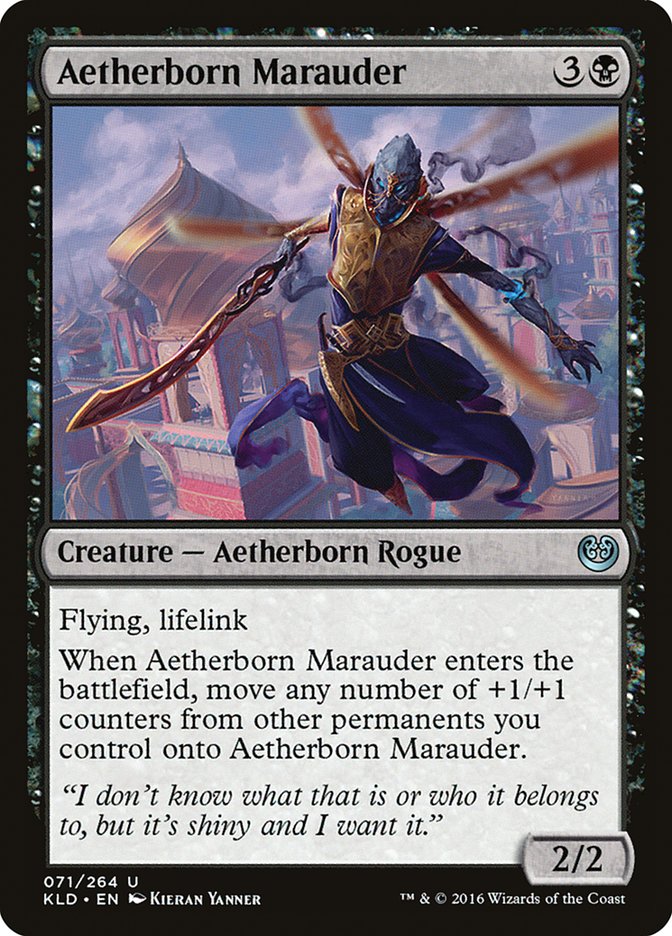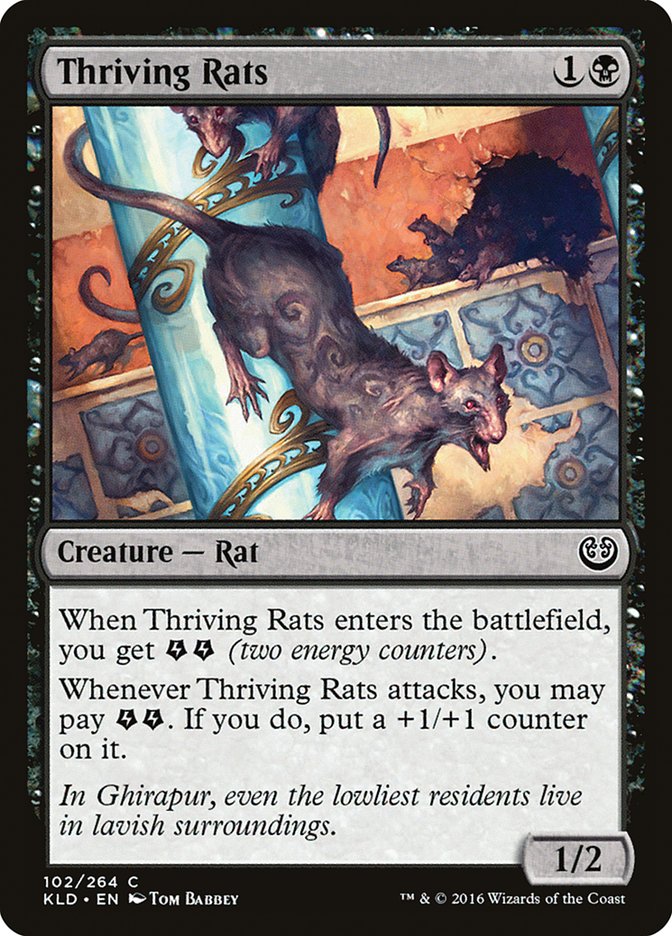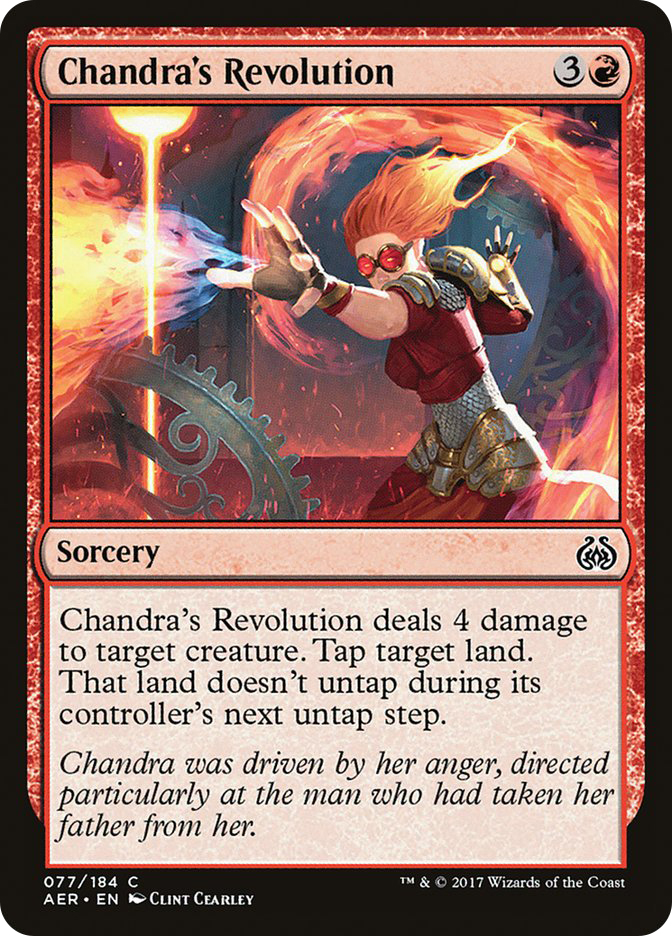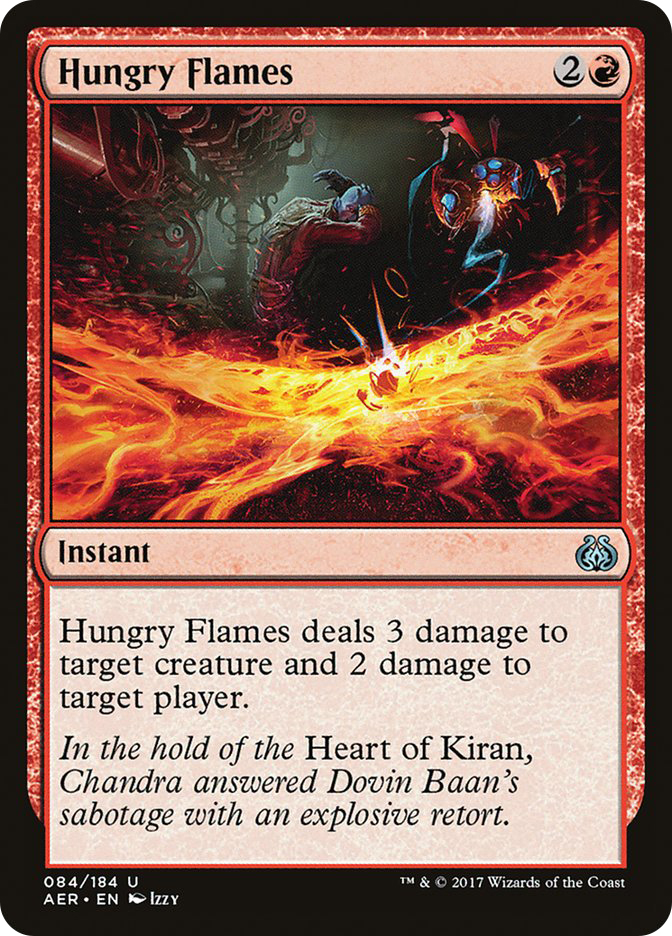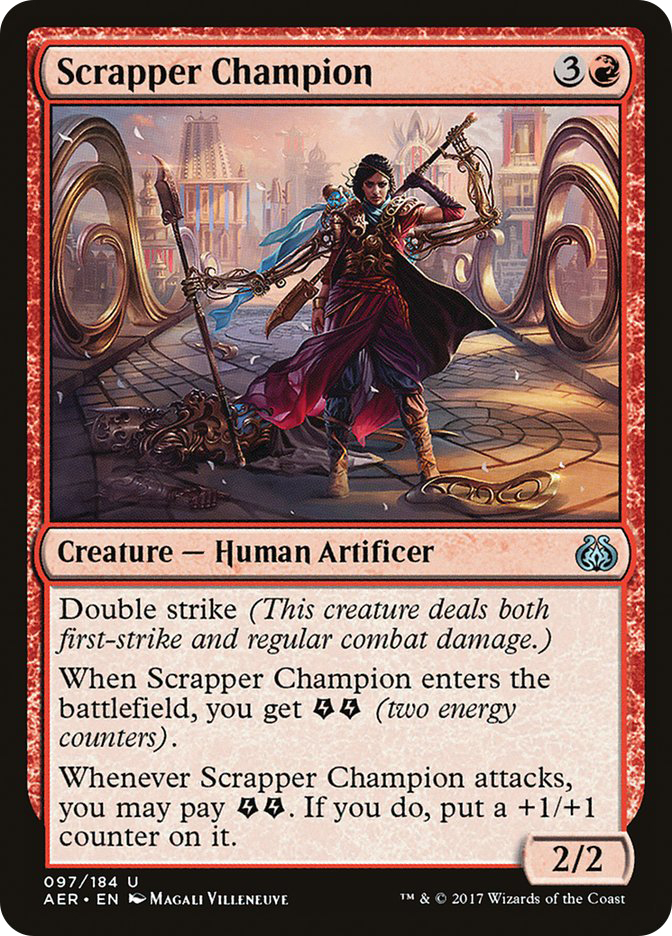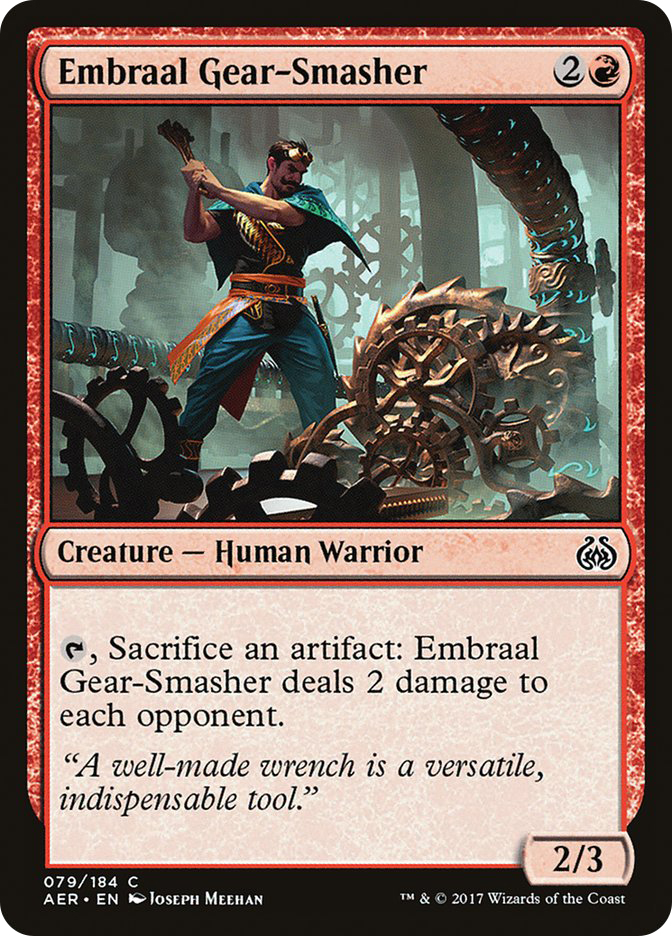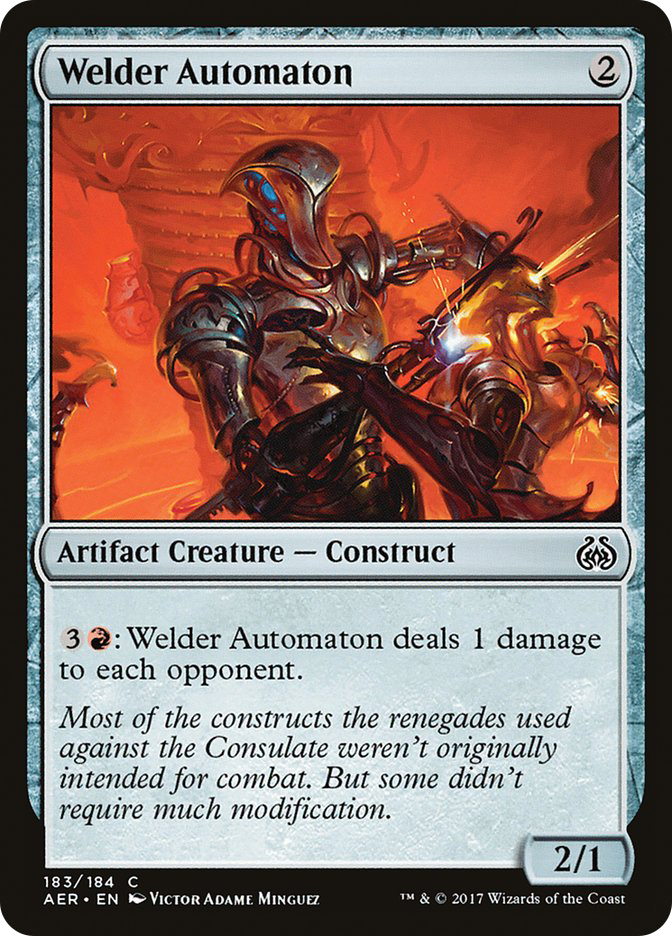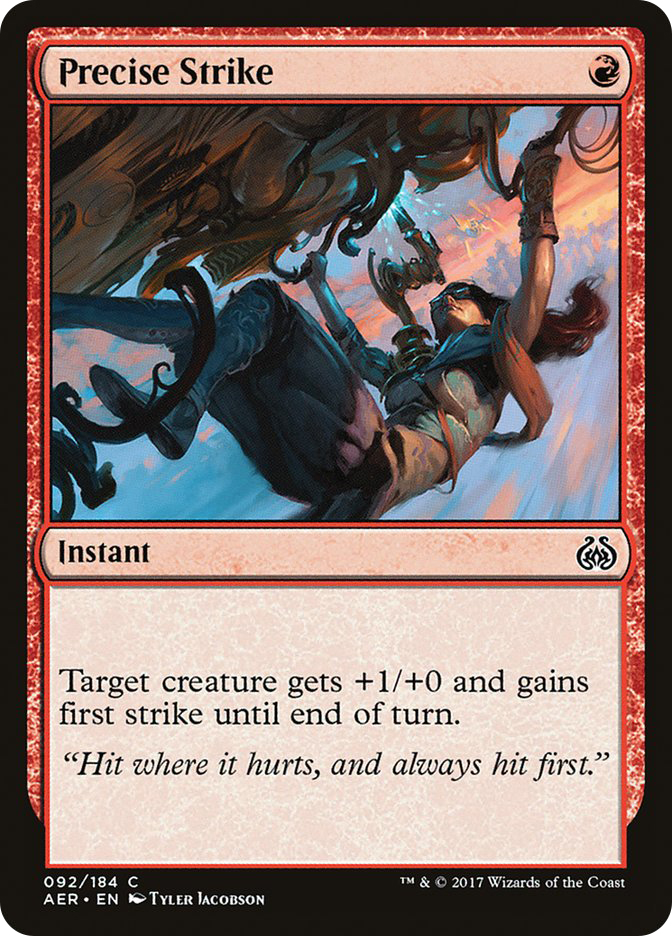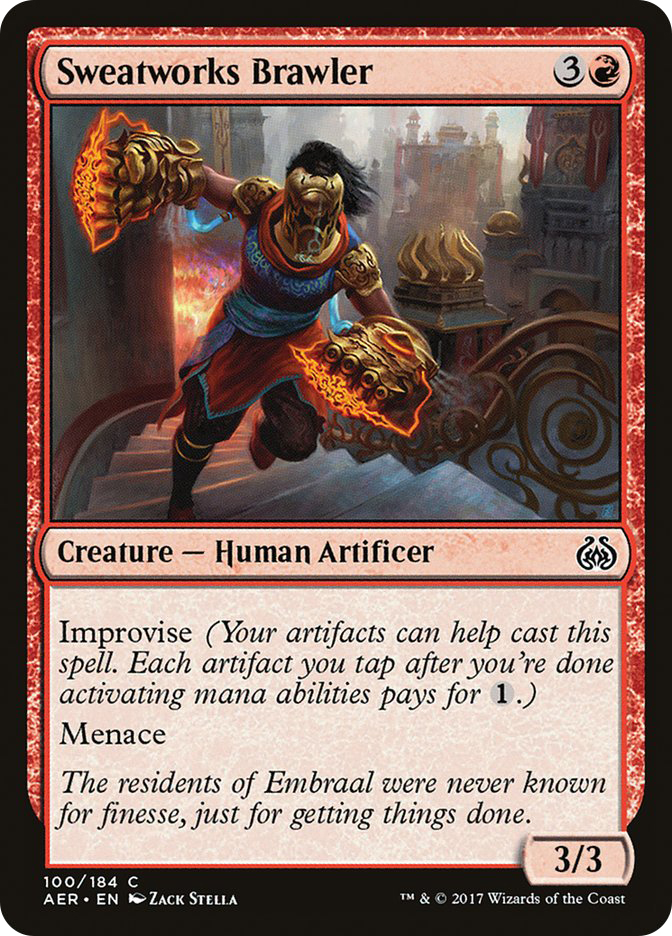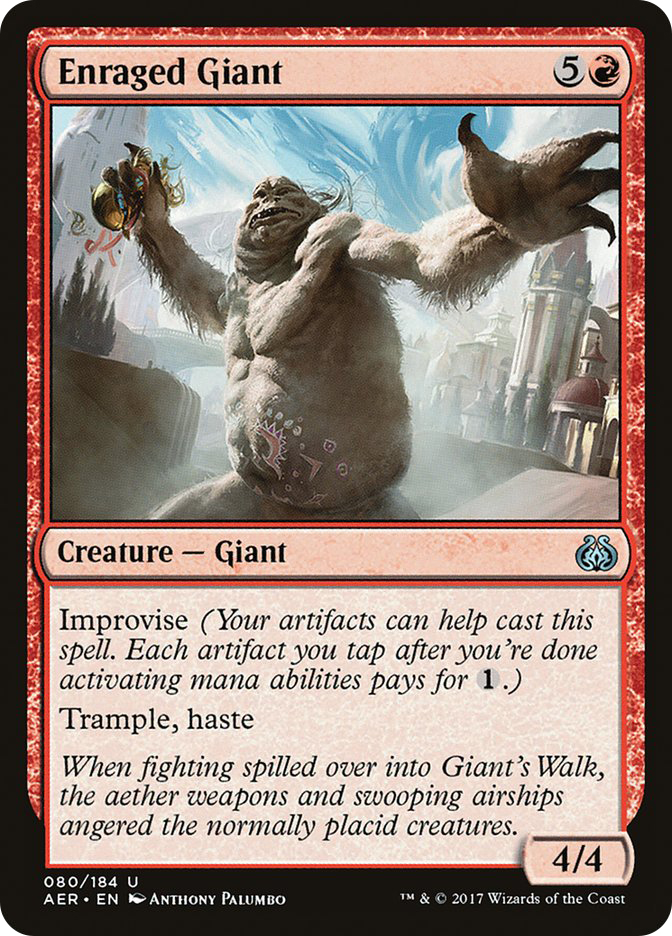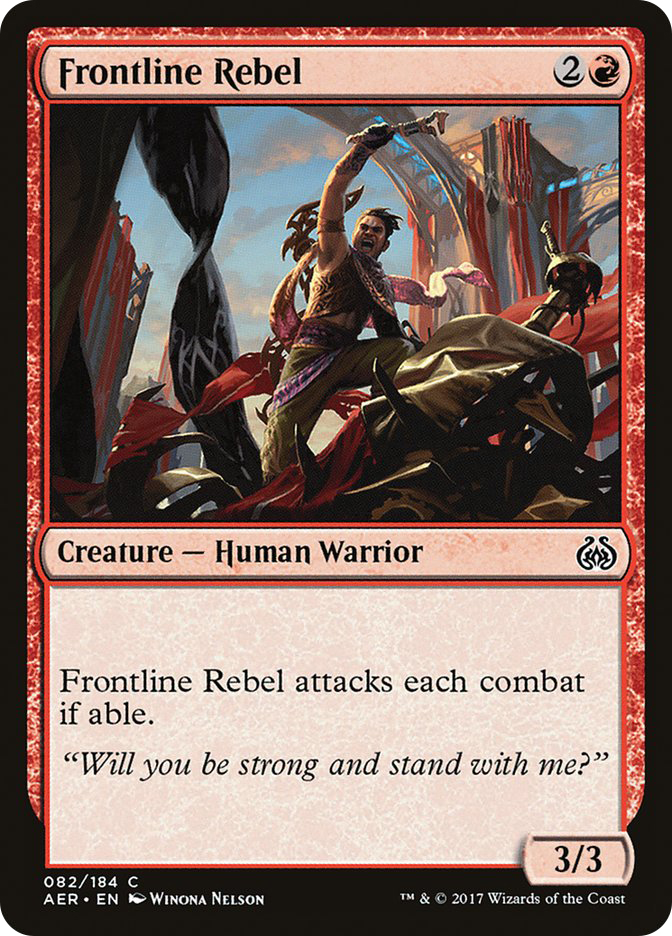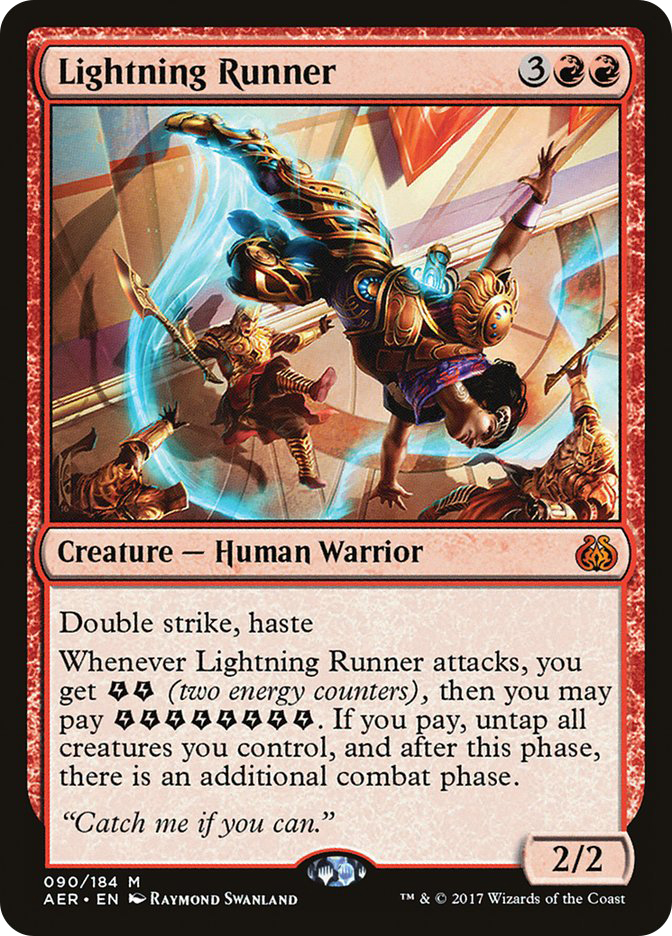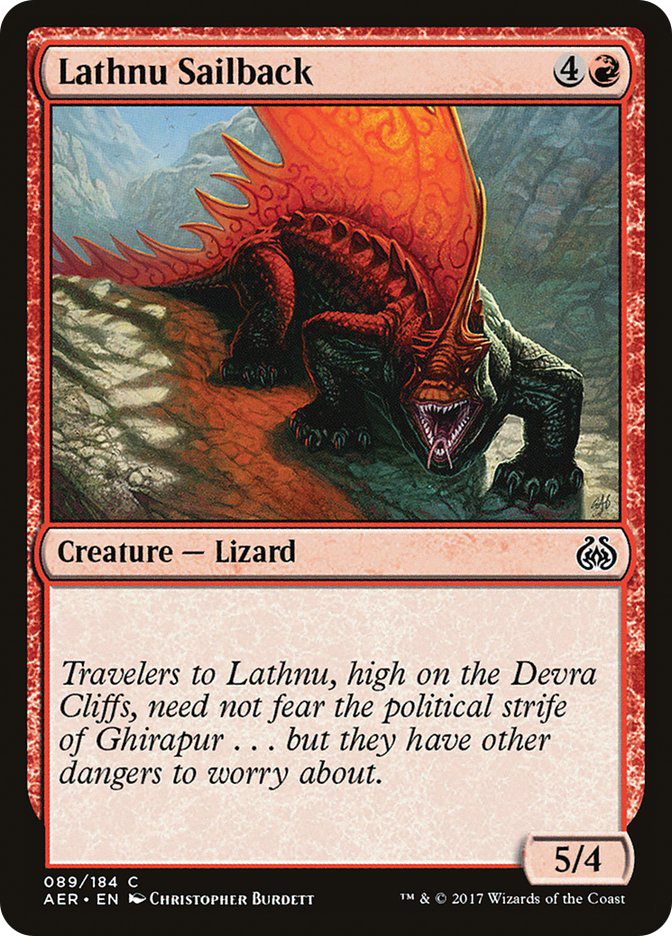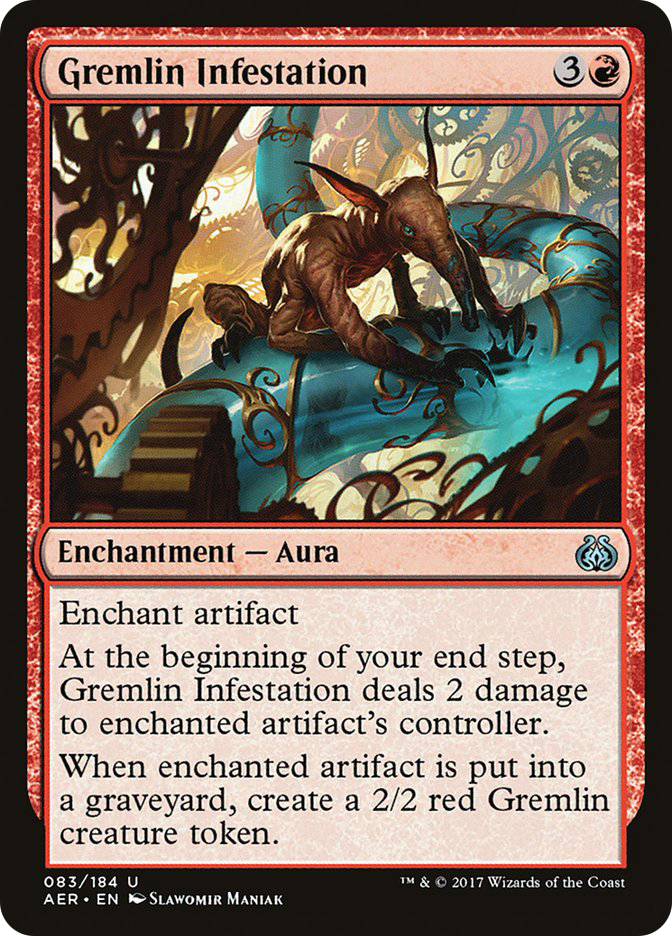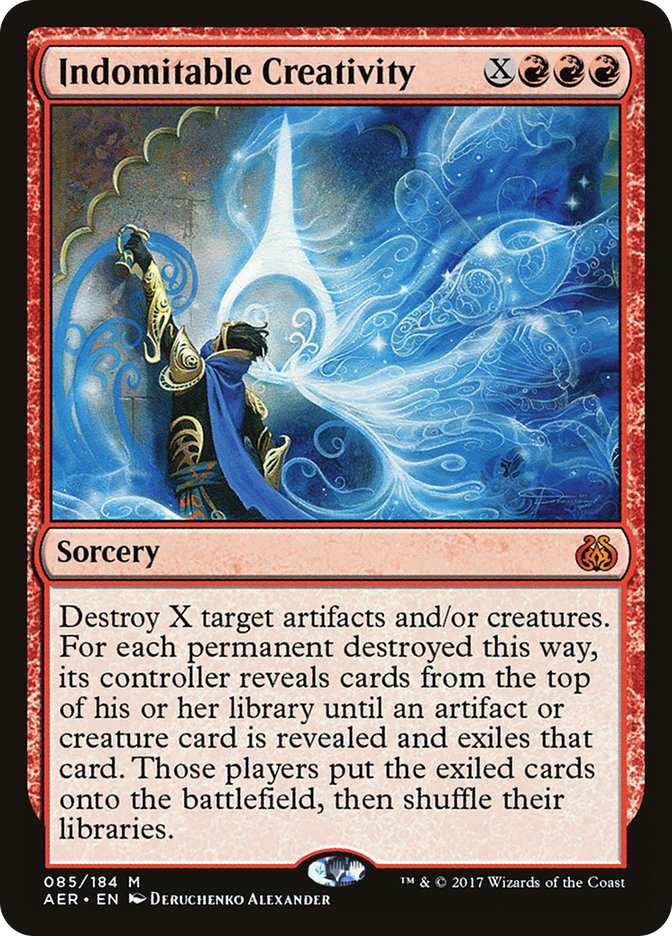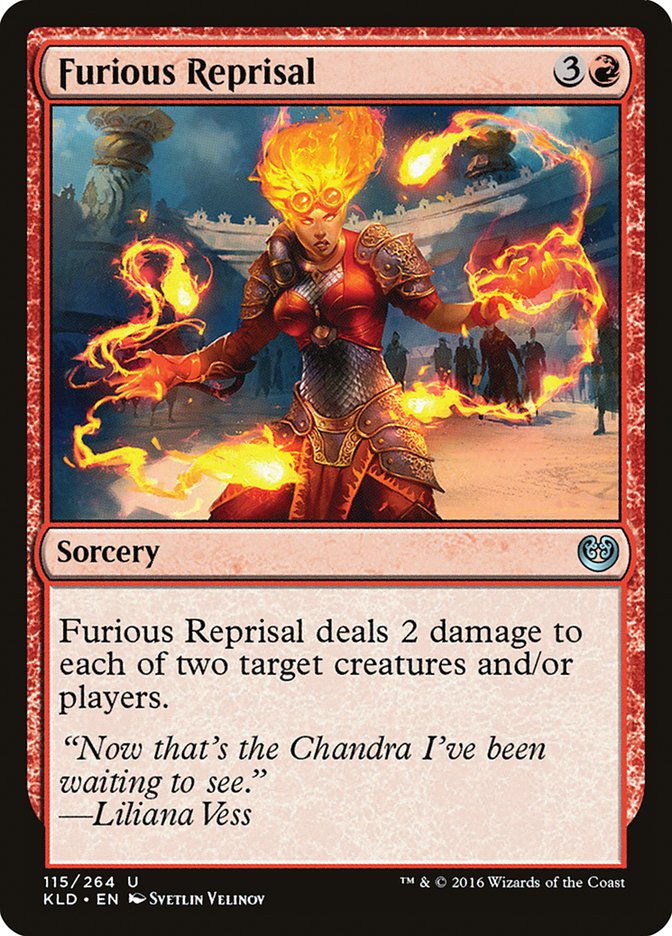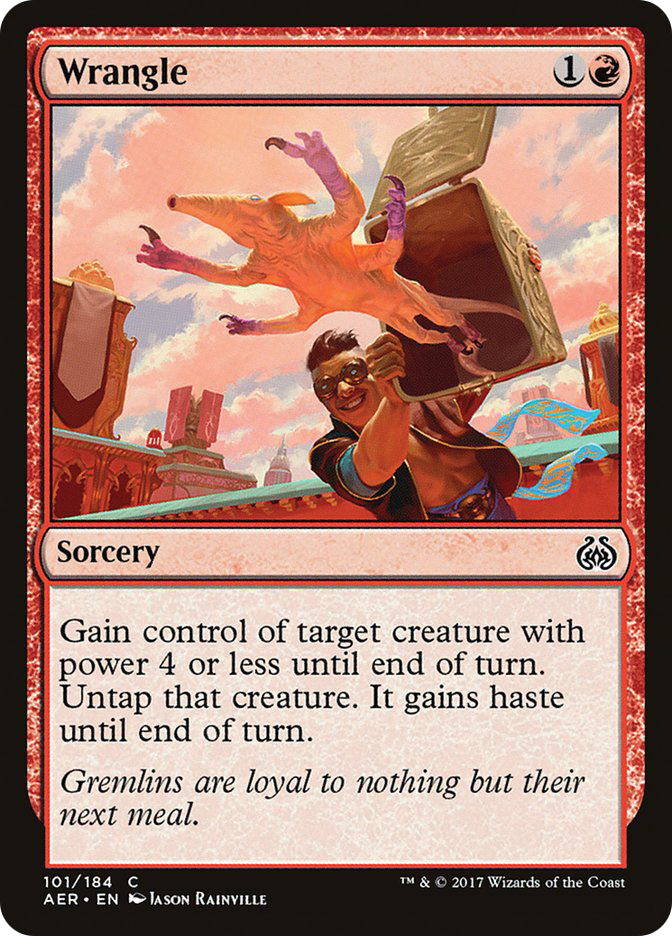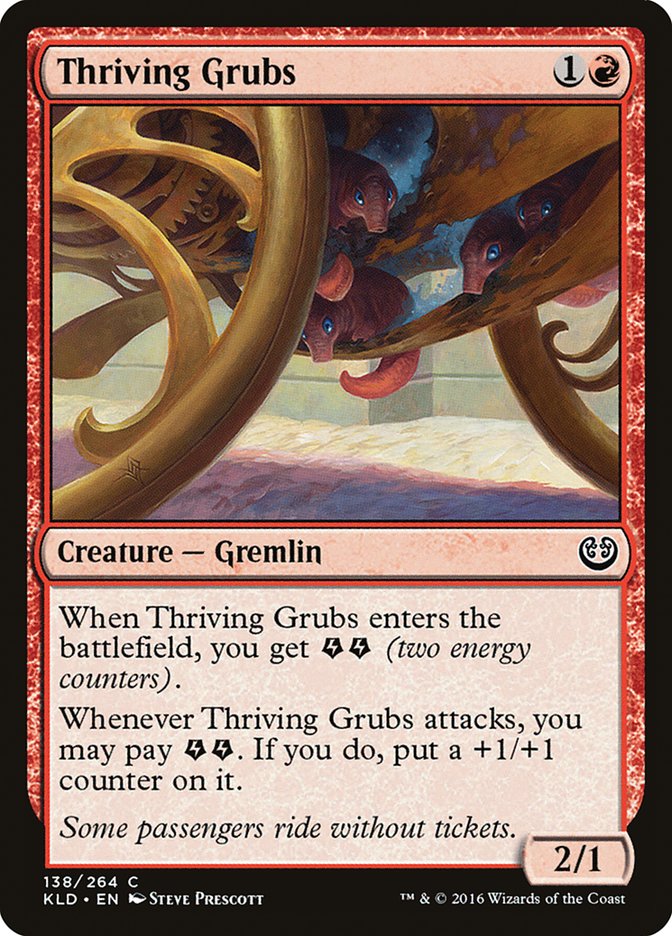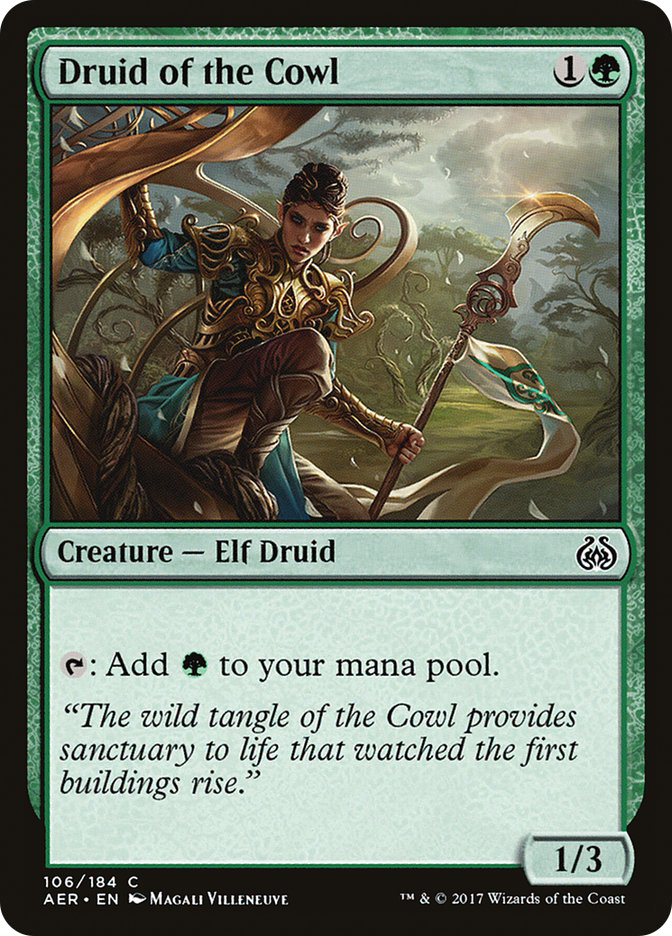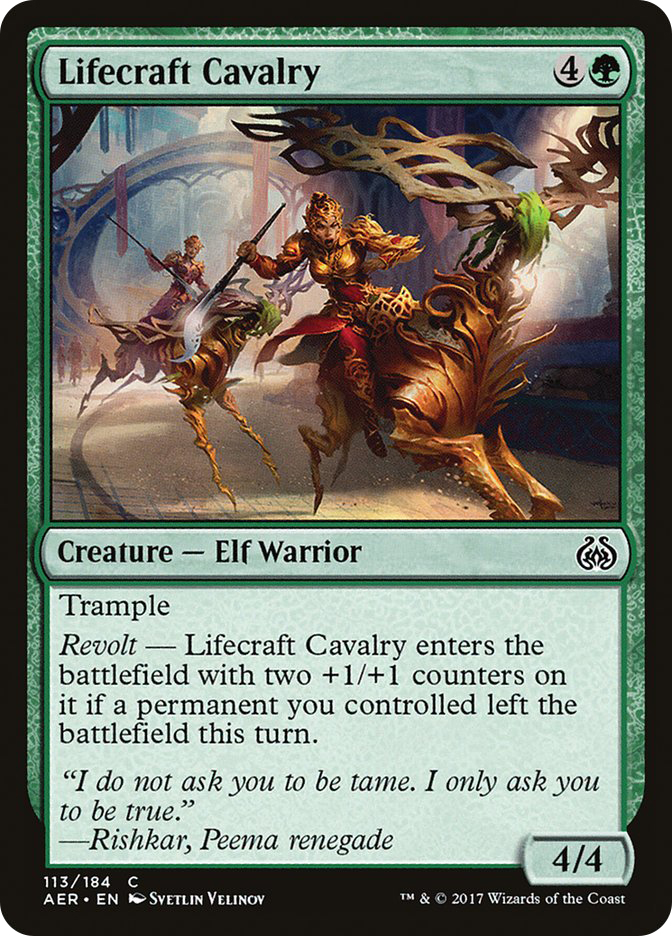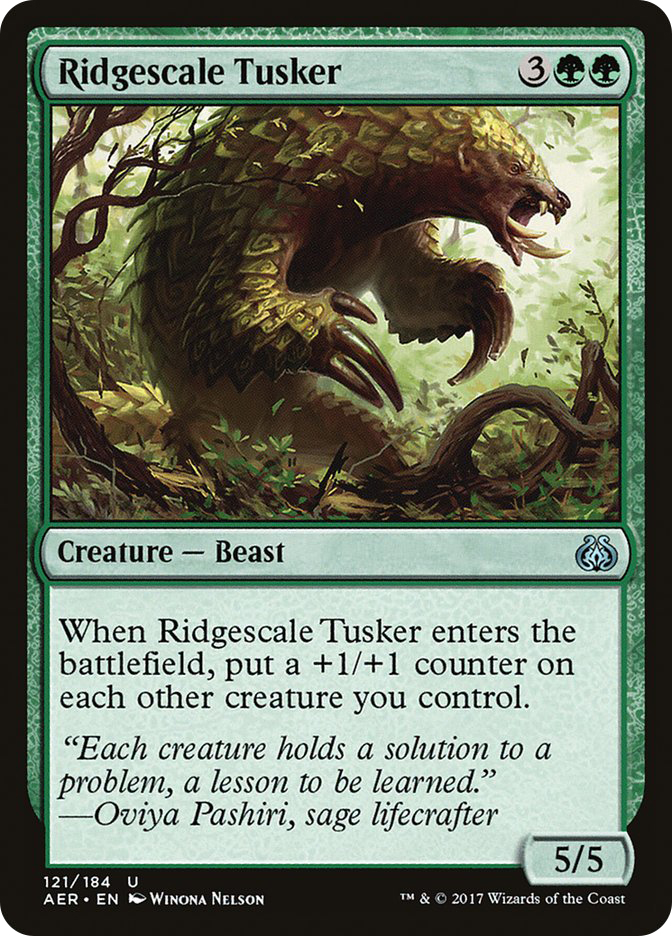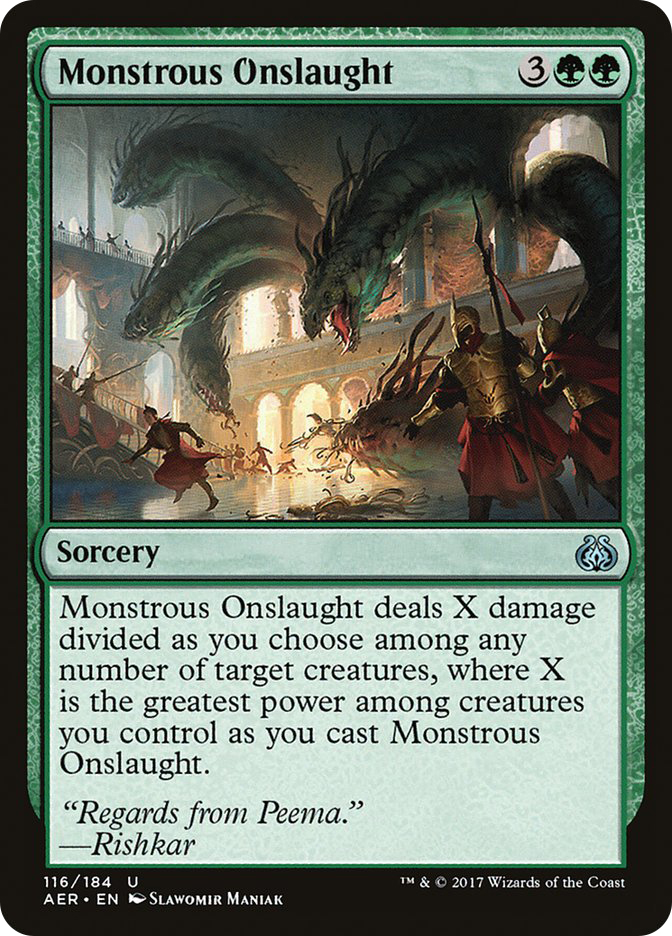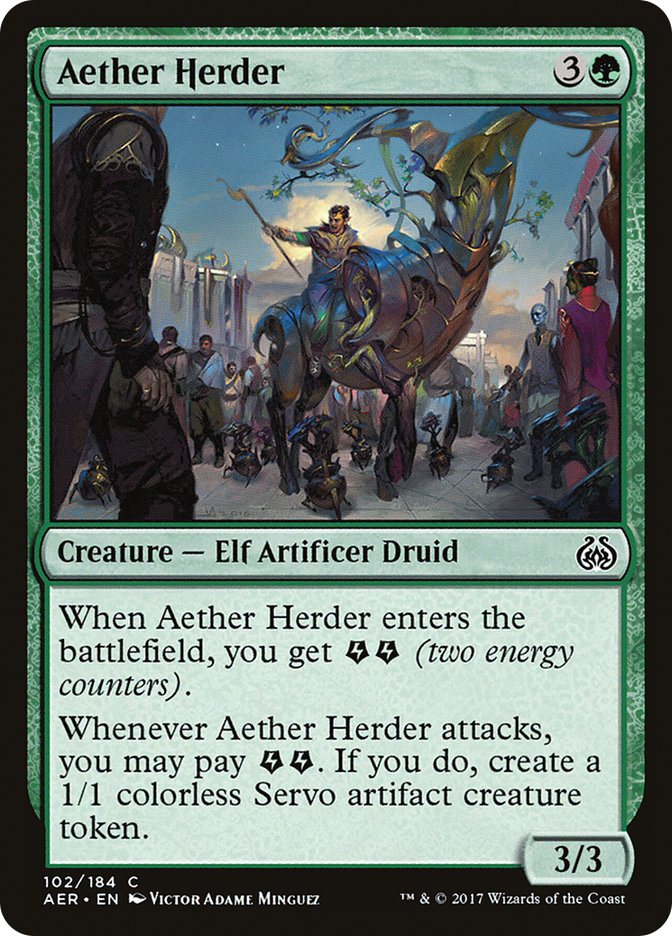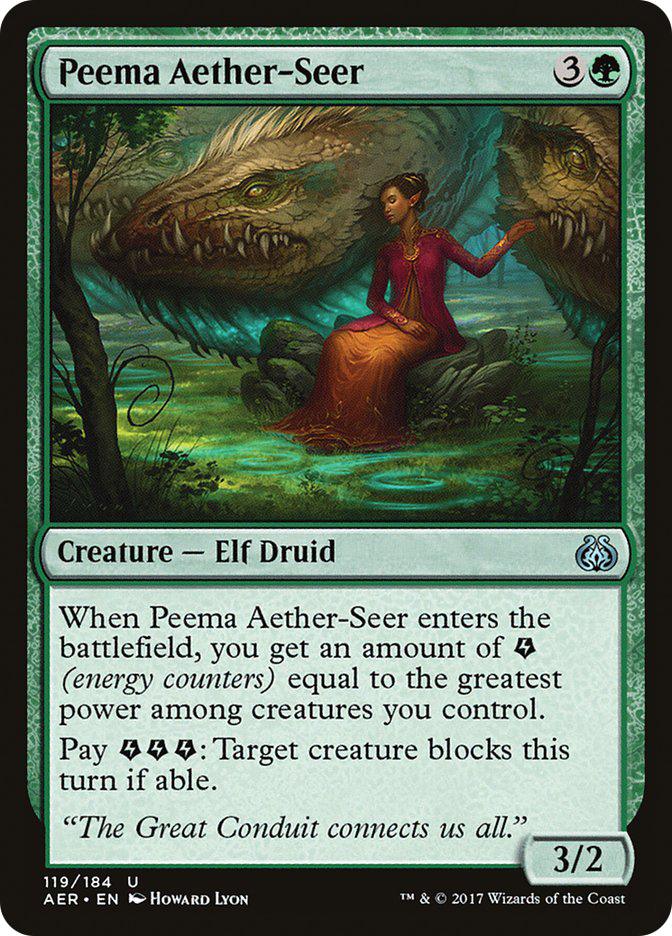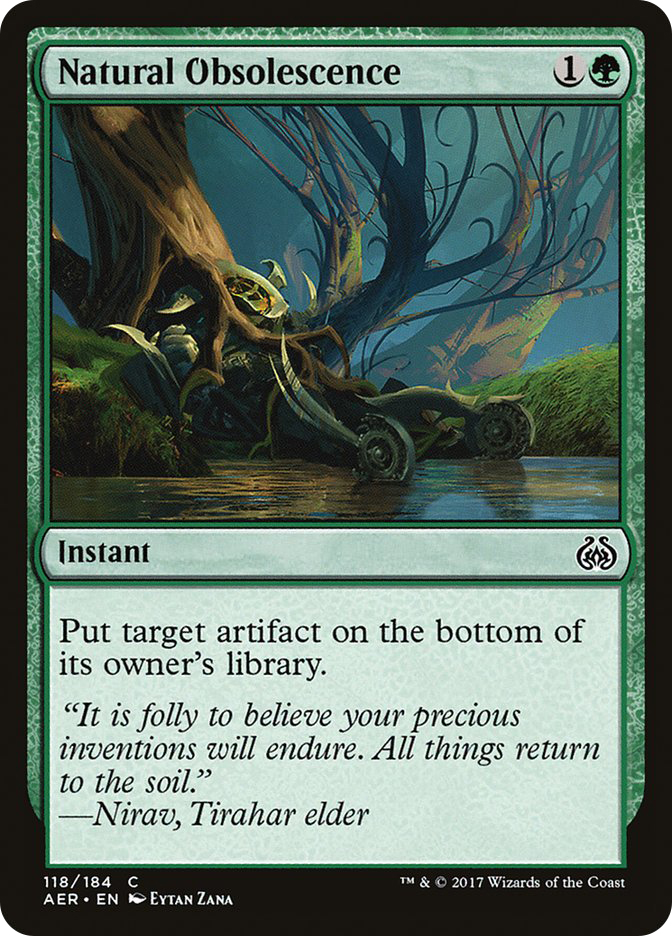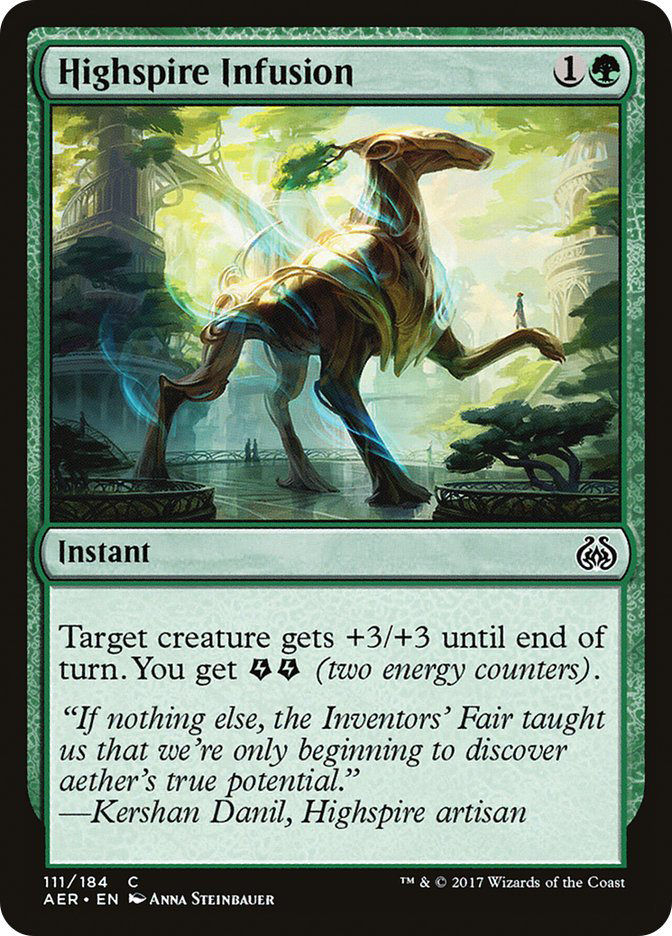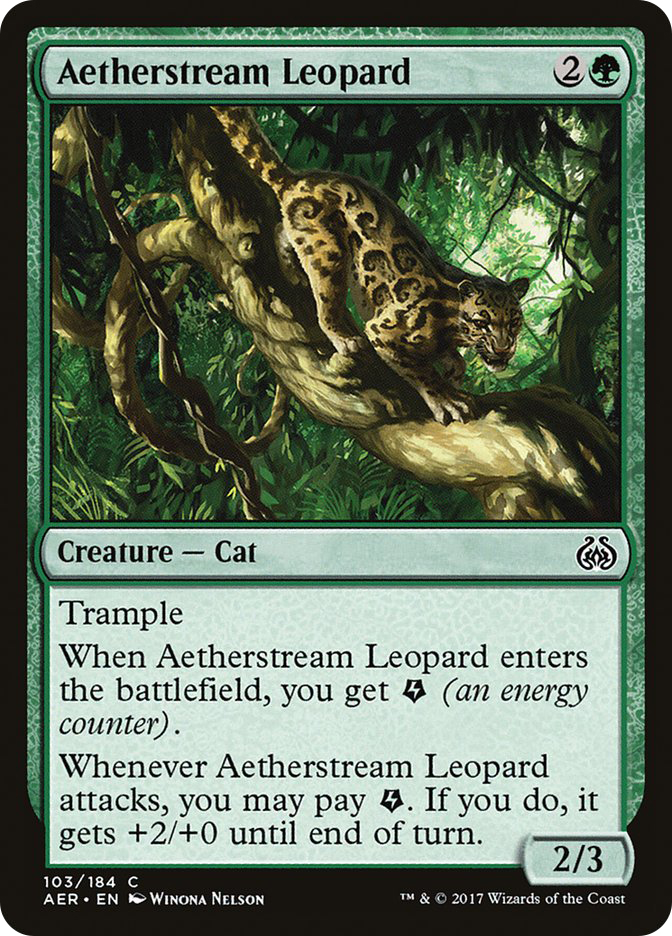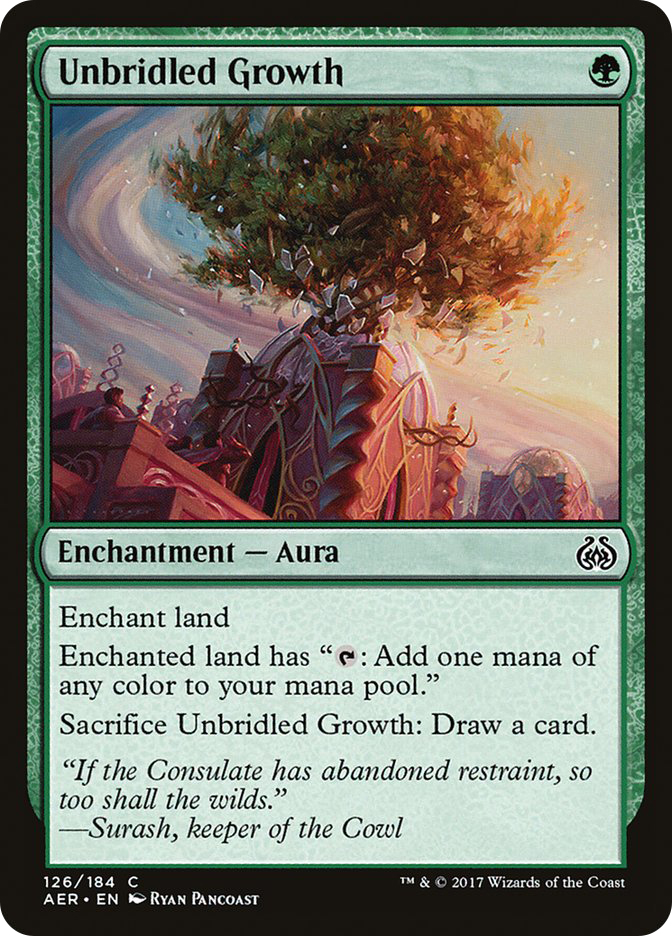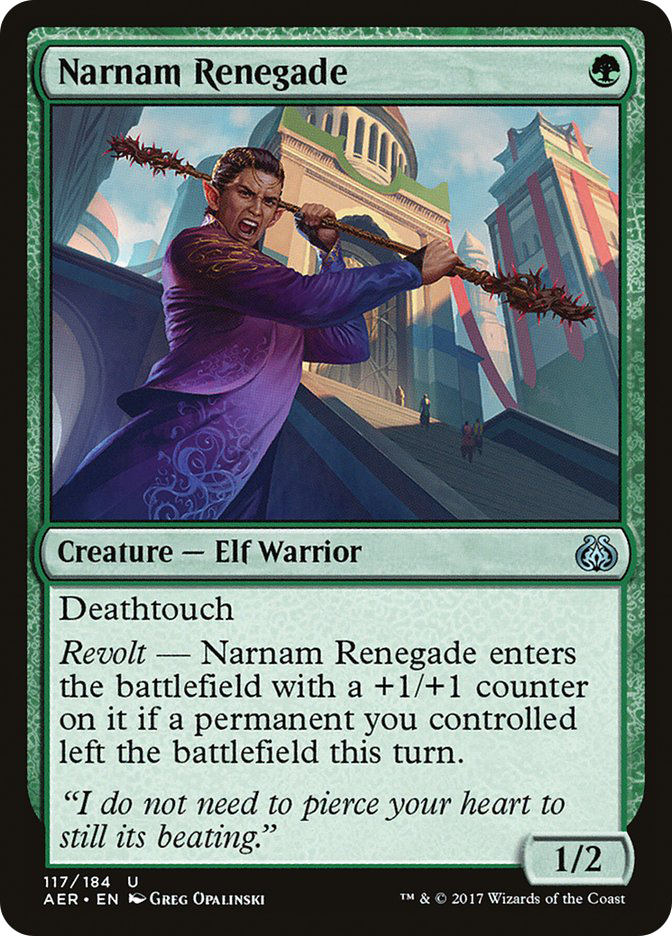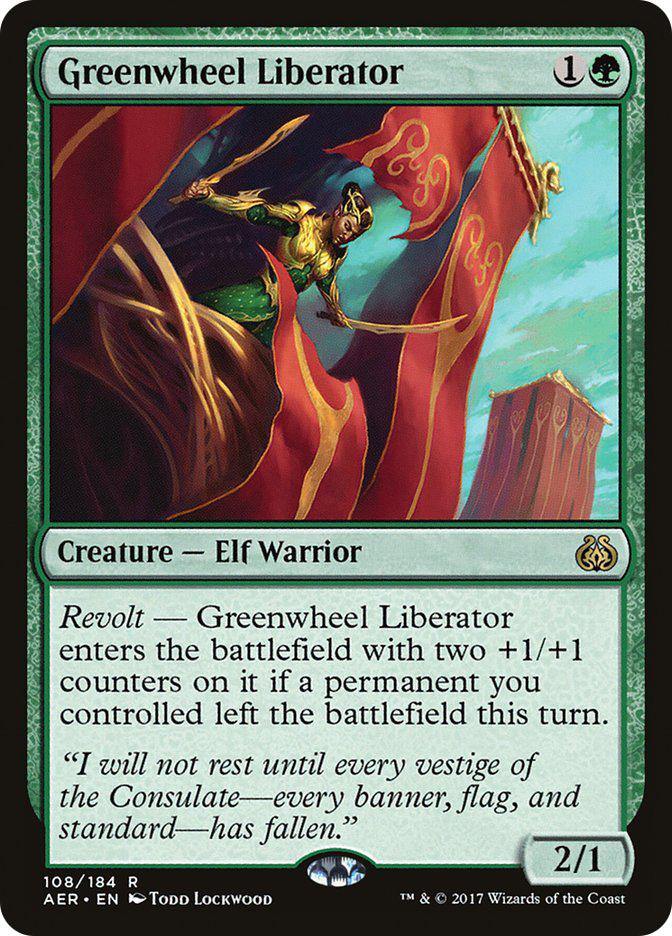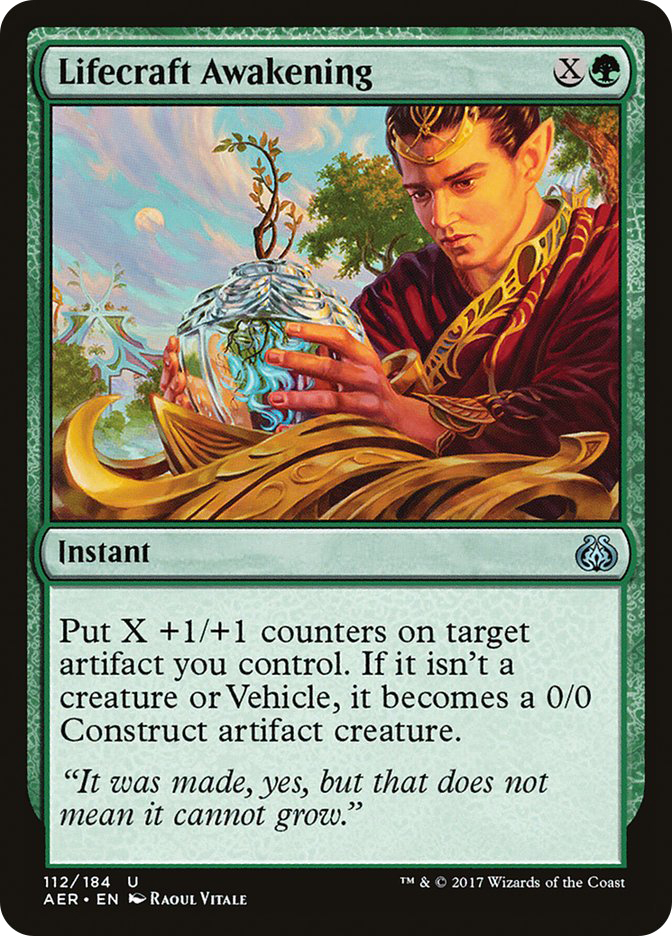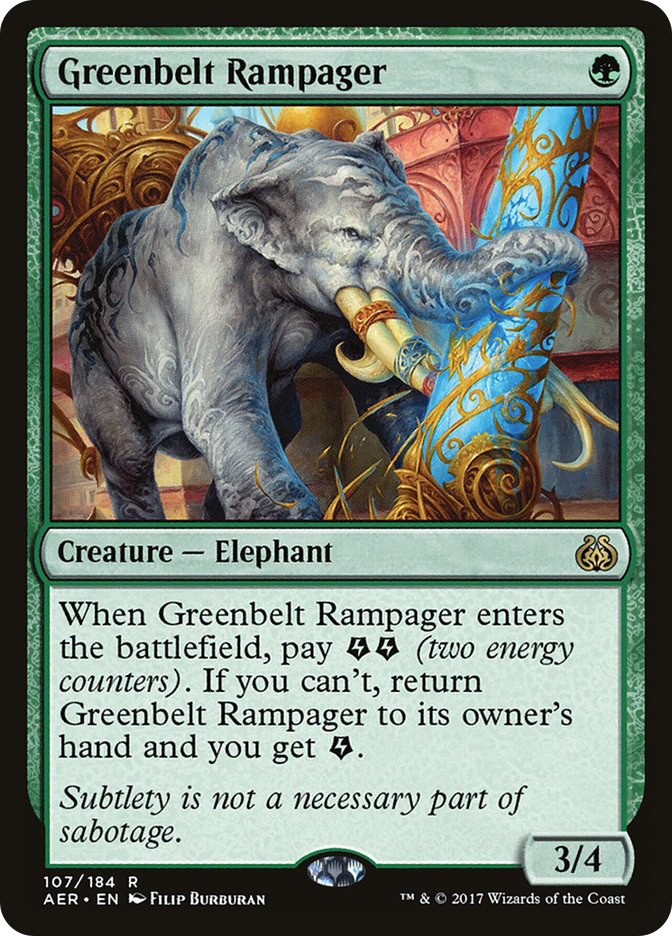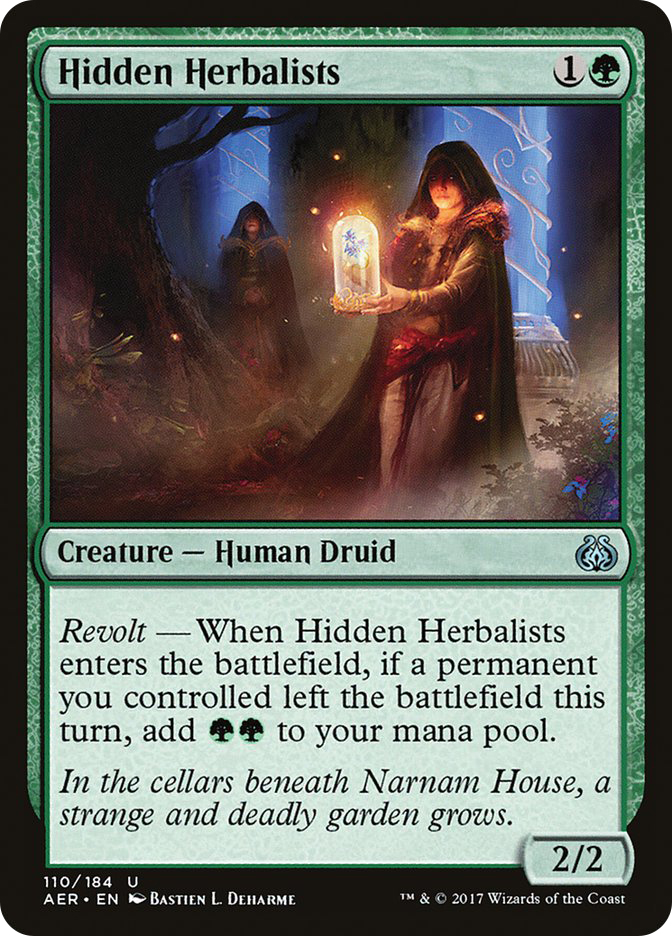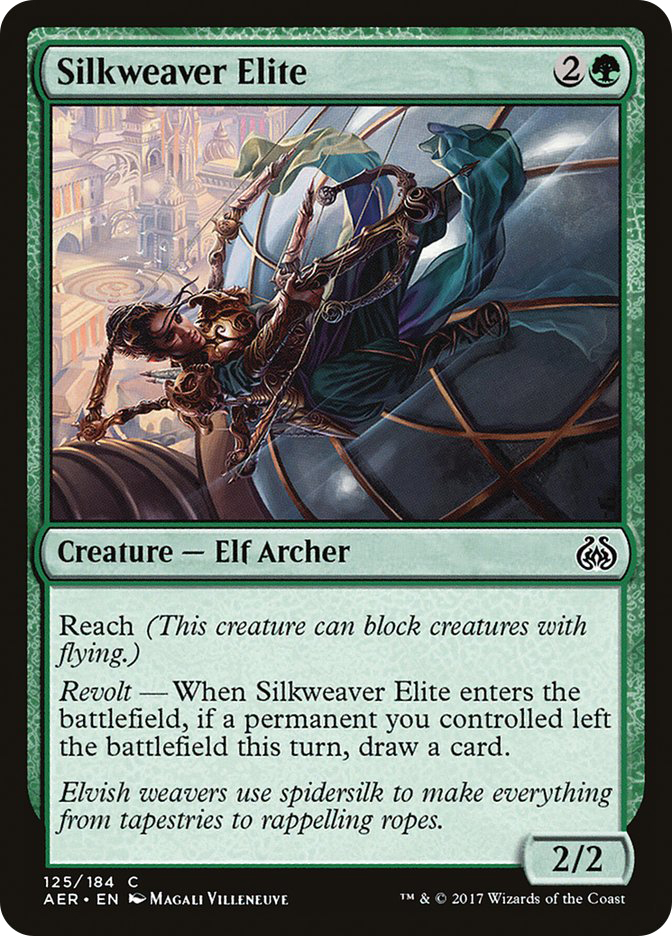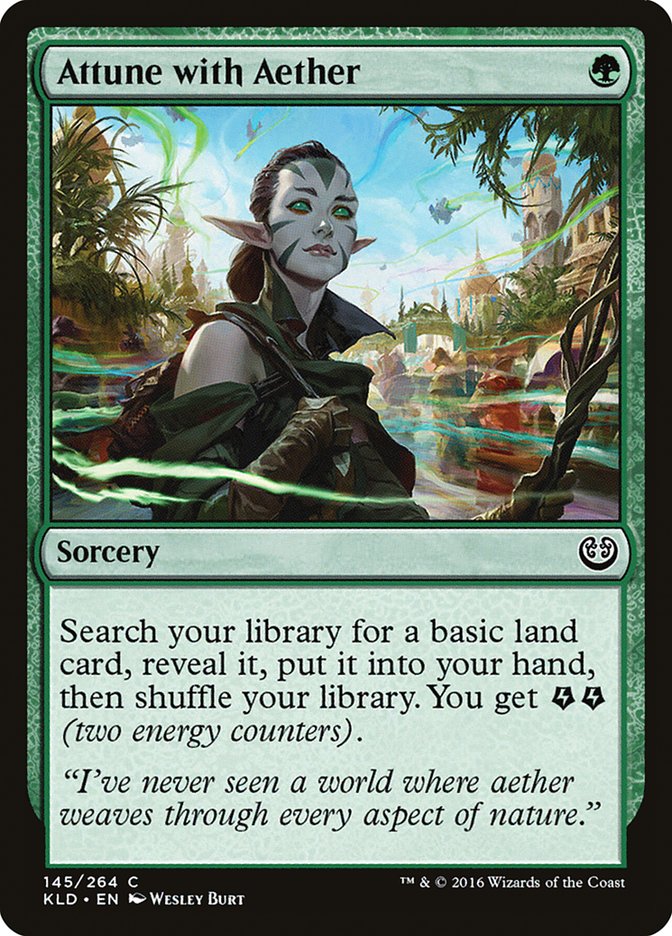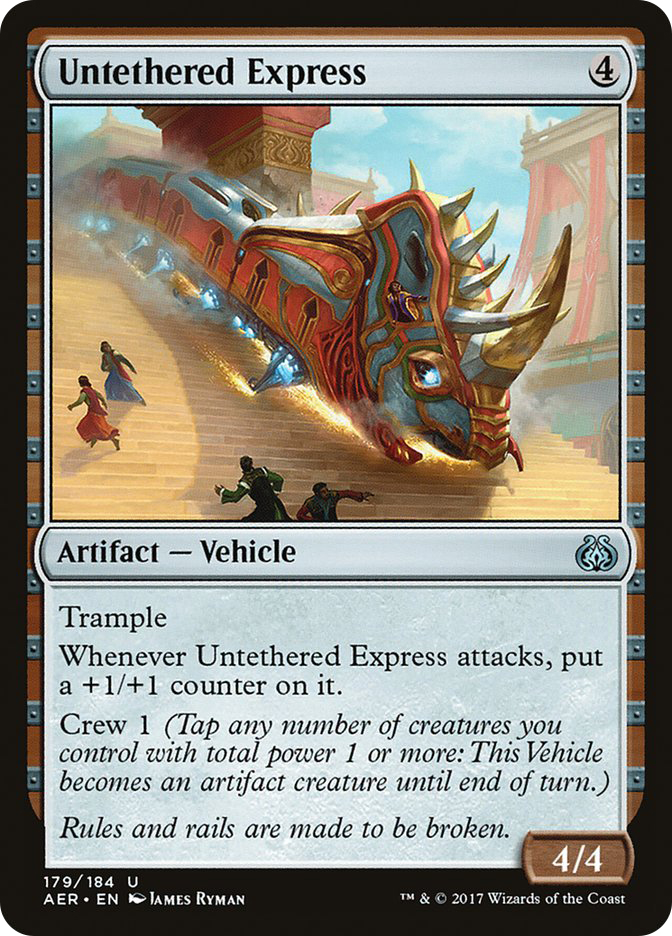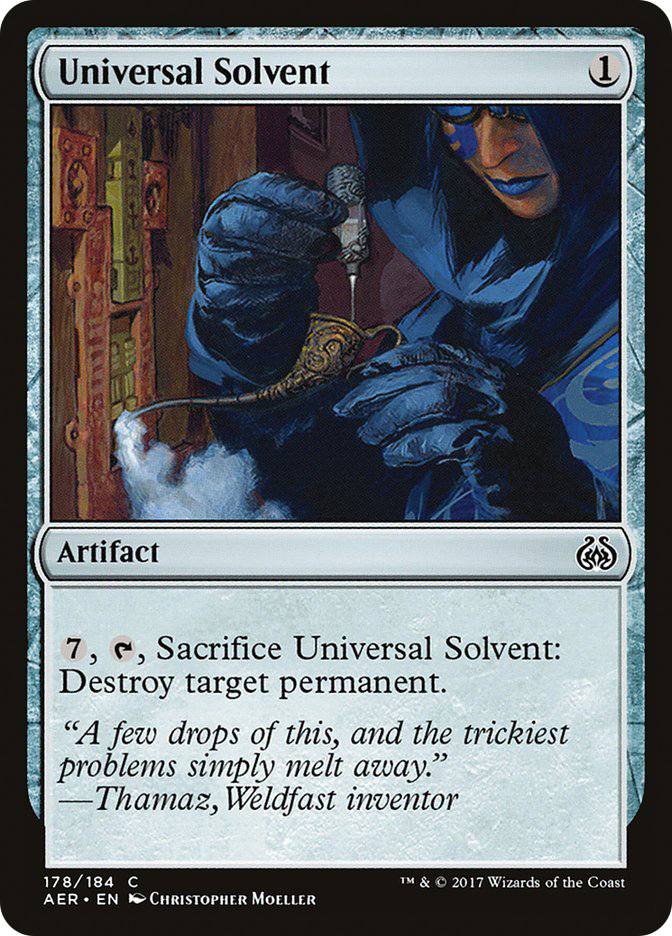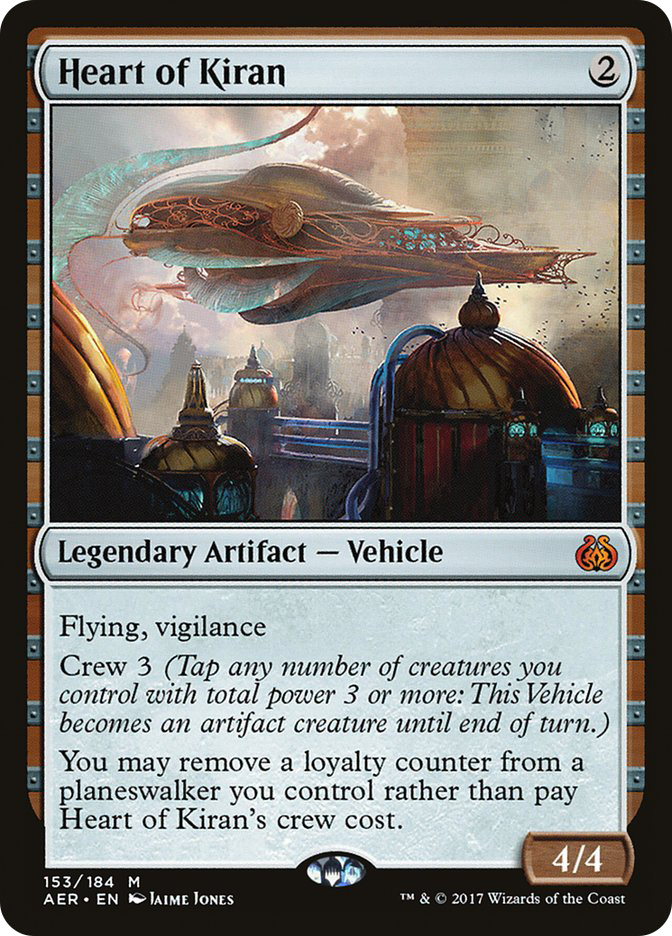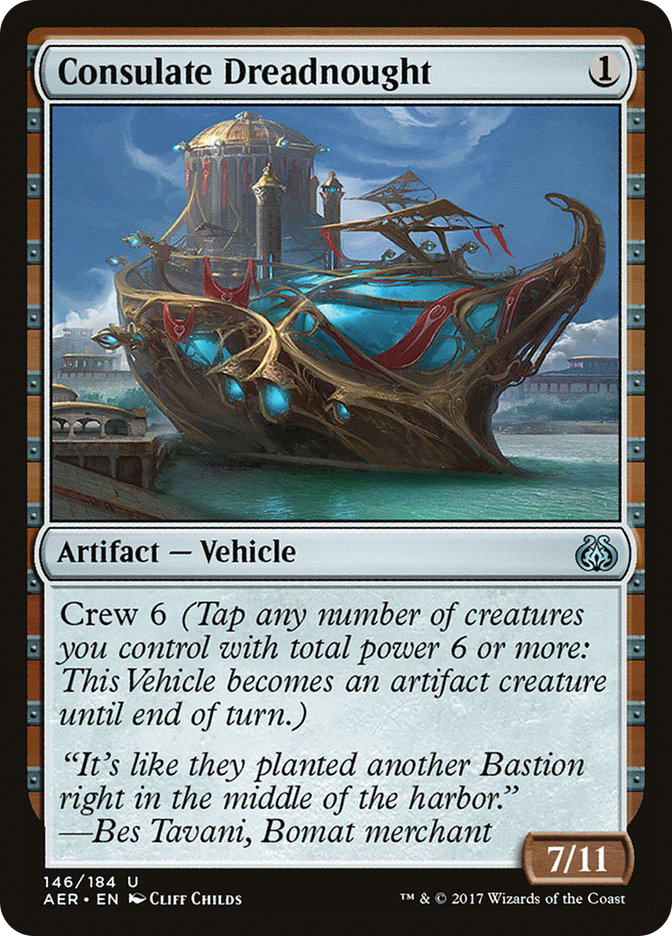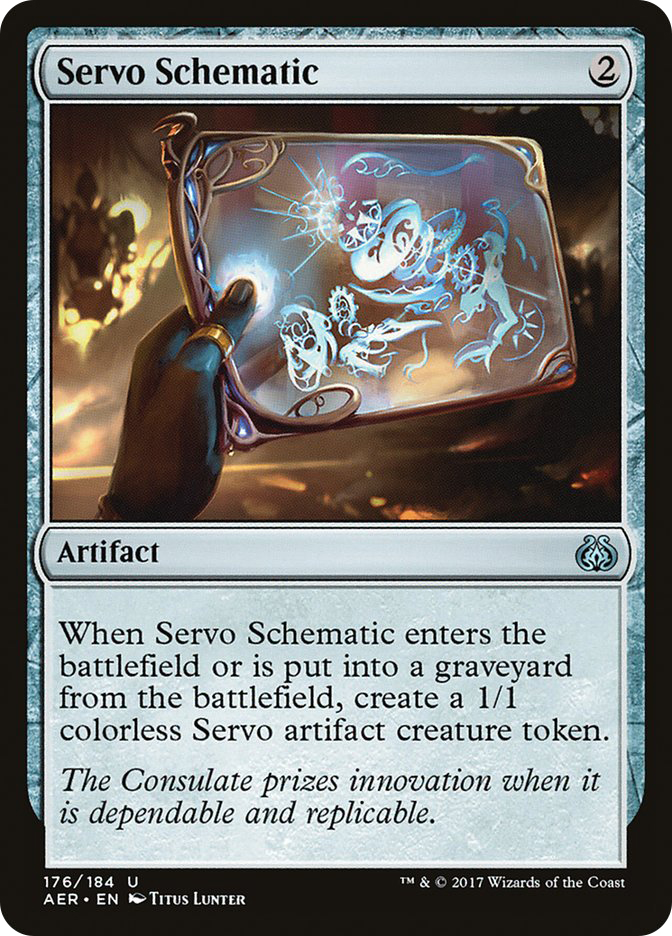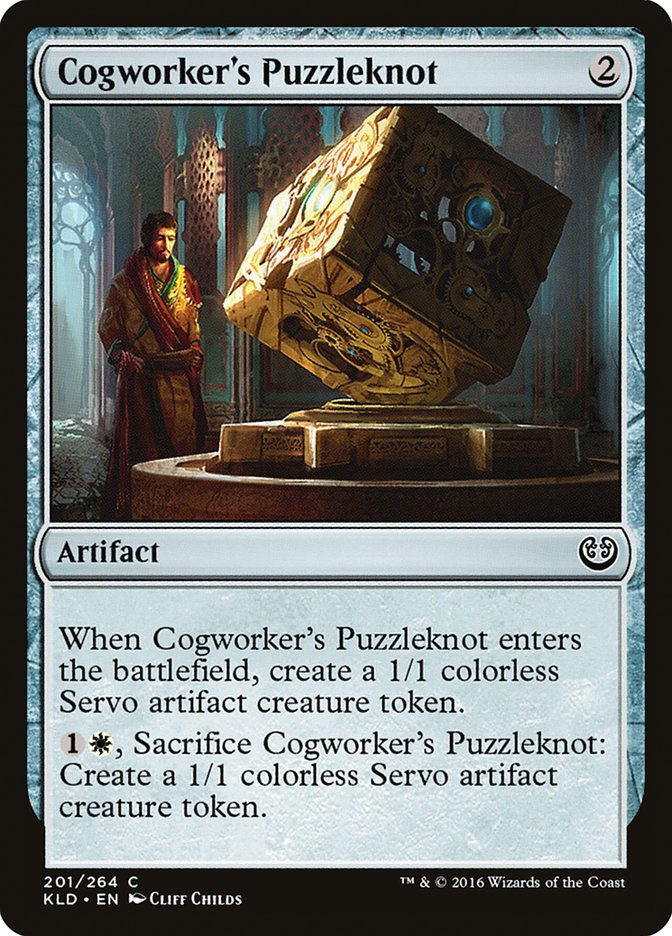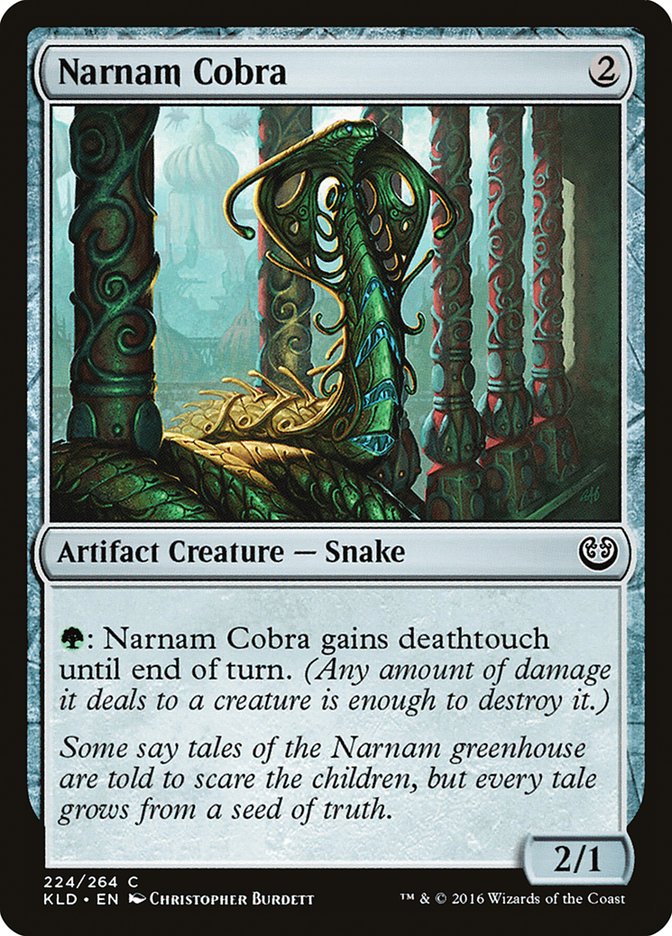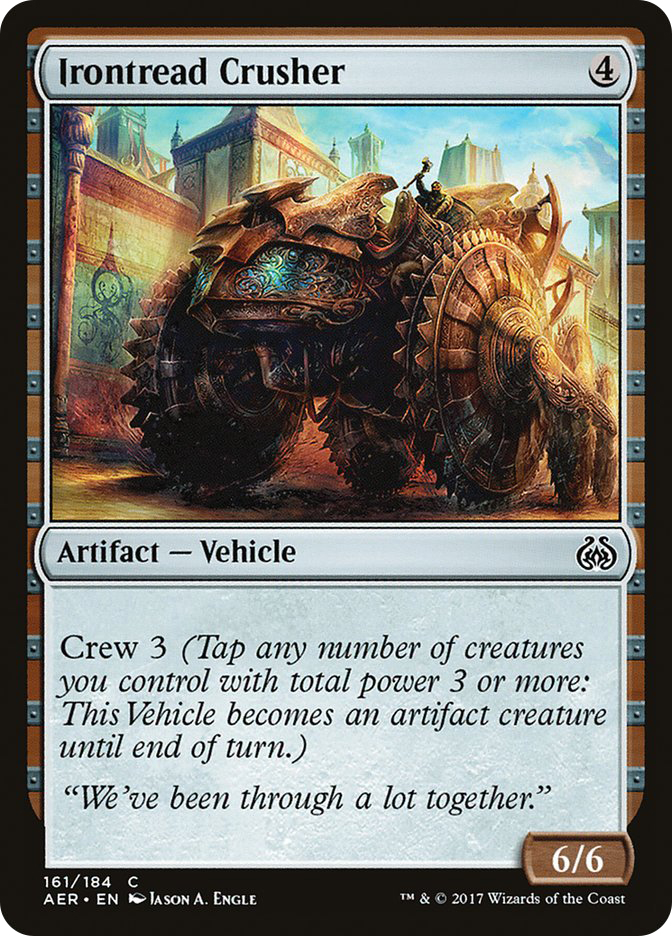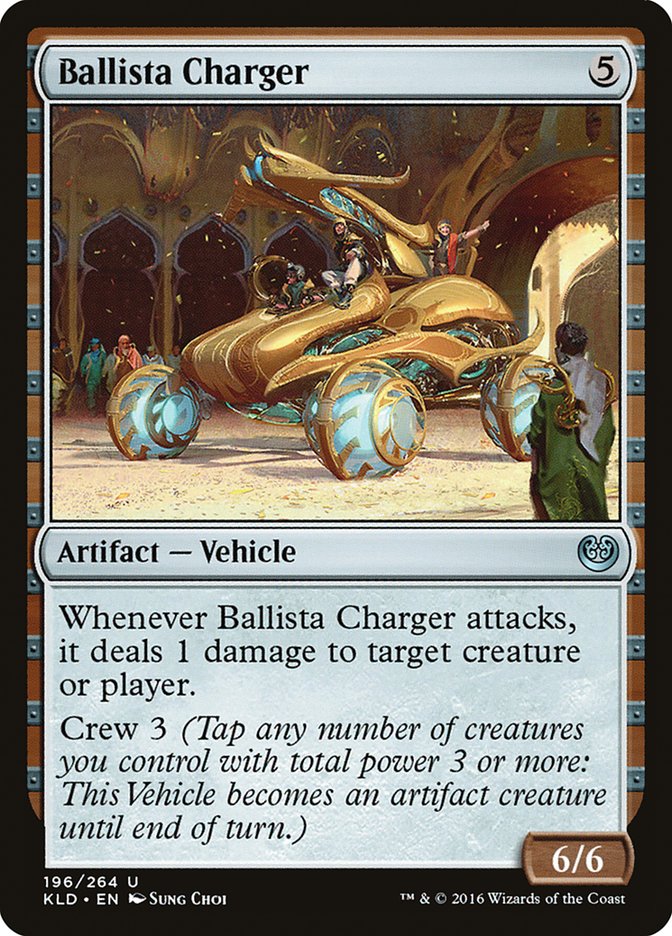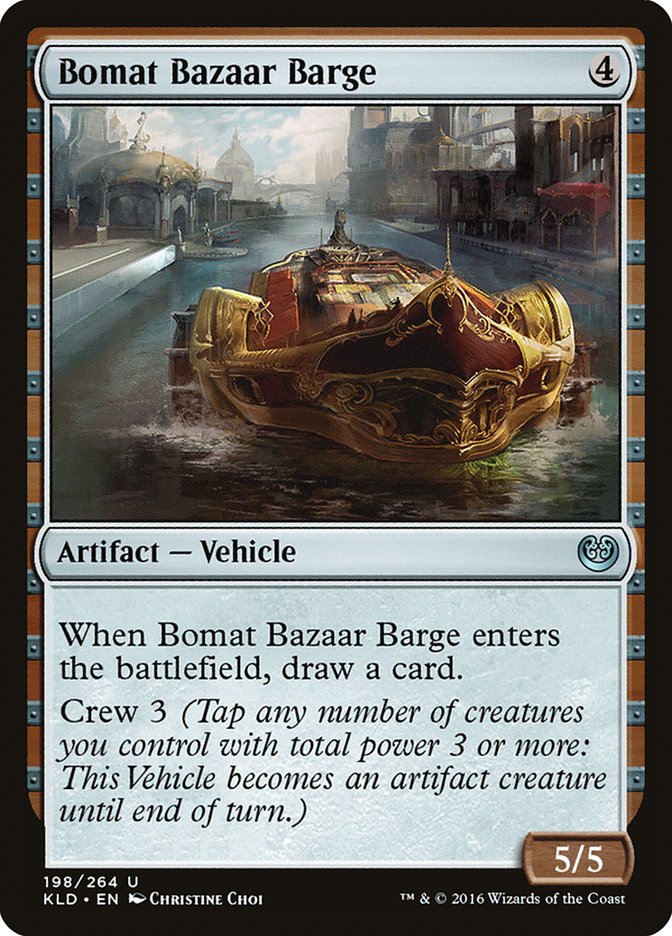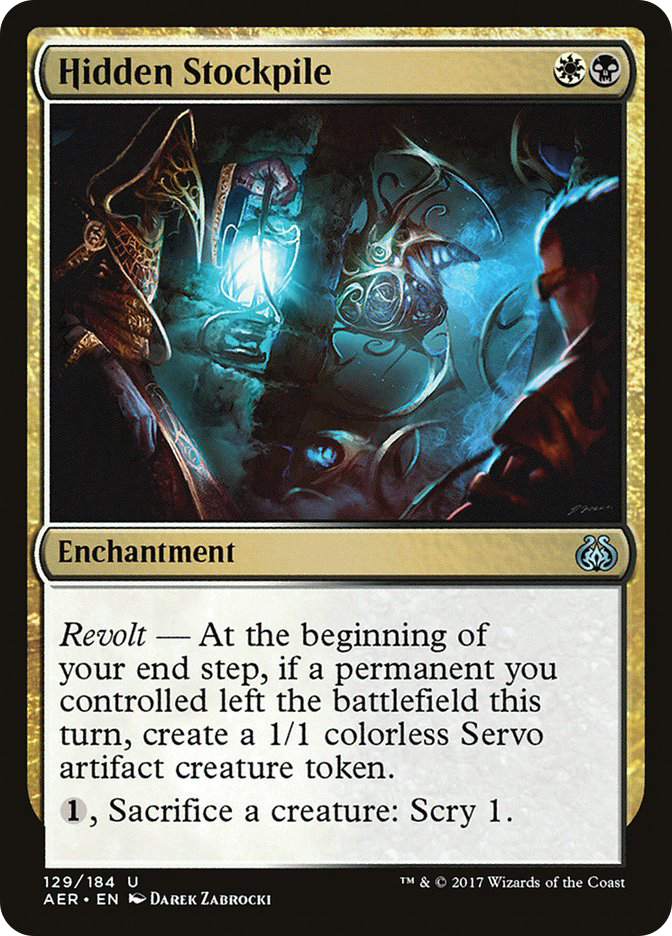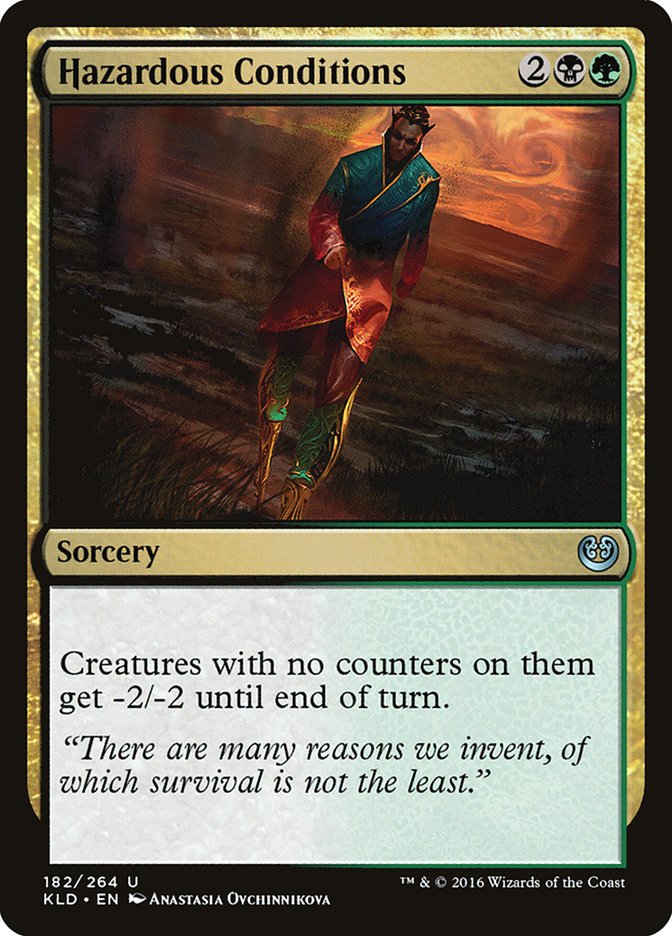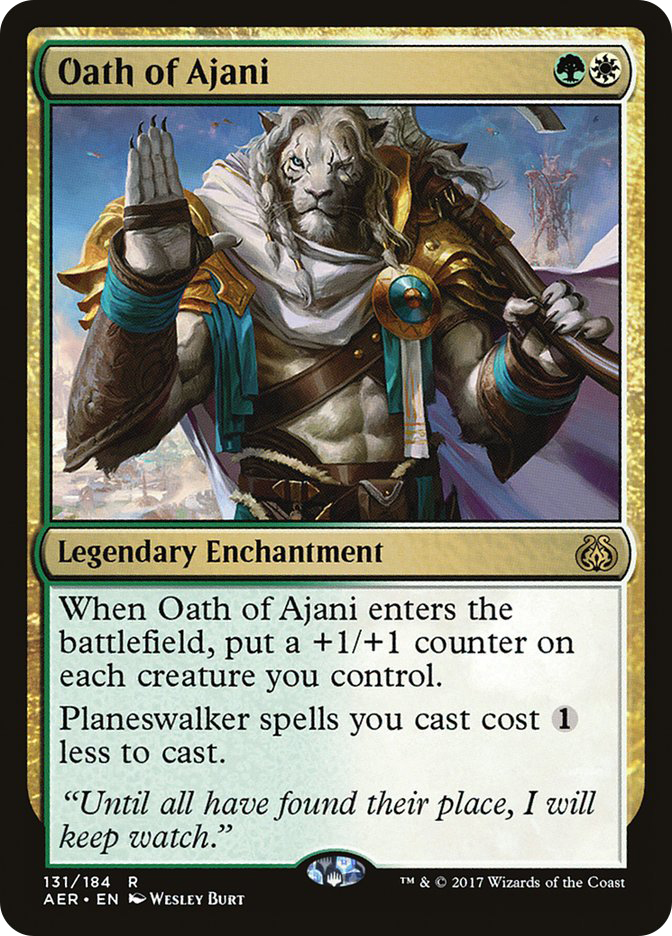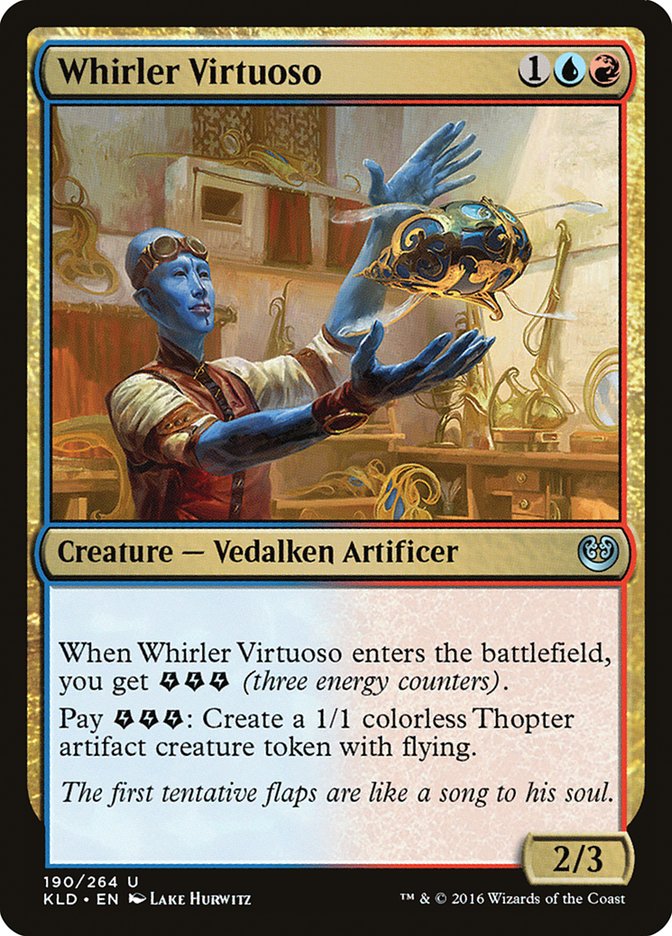Today’s goal: answer a few key questions about Aether Revolt Limited.
How the do mechanics affect the format?
How does creature sizing affect the format?
What cards do I want to be first-picking?
Are there any holes or oversaturated slots in a color?
How does the color play to the set’s themes?
How do the rares line up for the color?
What are the cards I think will be under- and overvalued?
Mechanics
Repeats first and fast.
Vehicles
The draw of Vehicles is an oversized creature with the drawback “you have to keep playing creatures and they can’t block”. Anything that is a small Vehicle is going to be situational. The medium scenario is approximately Boar Umbra: you get one big threat that shrinks back when it dies.
Crew 1 or Crew 2 is basically non-specific. Crew 3 requires some deck construction thought to meet. Crew 4 or more is “tap two creatures” range and only for use when you need a huge threat to crush Walls. You need fourteen creatures minimum for one Vehicle; generally with multiples you want sixteen.
Energy
Energy is all about understanding sources and sinks. Sources are things the energy isn’t good to spend on that tend to trade off and leave the resource behind, while sinks are things that will win you the game if you spend extra energy on them. To make this unwritten distinction more complicated, these things aren’t mutually exclusive: Thriving Grubs sometimes trades as a 2/1 and sometimes becomes a crazy 4/3 or 5/4.
Most sinks in Kaladesh were good without help. The key was avoiding playing and picking sources like Hightide Hermit if you didn’t have payoffs.
In Aether Revolt, as in Kaladesh, every color utilizes some energy, but green and blue are the only colors with multiple commons. The change is a significant drop-off in red, which narrows the linear Energy archetype a bit. The second blue common also isn’t very good, which is another strike against the archetype.
Revolt
New mechanic Revolt bears a number of similarities to morbid, a mechanic from the original Innistrad. There were two types of morbid abilities: one-shot effects linked to a spell resolving or activation/triggers conditioned on it. The key in both cases was the cost:iIf your effect cost a significant amount of mana, you were looking to enable it in combat or via very specific sacrifice effects. If it was free, something like Altar’s Reap or, in Revolt’s case, Acrobatic Maneuver would do the trick.
Aether Revolt has been designed with a lot of low-cost ways to activate Revolt, so you can build to proactively enable it. The key is actually evaluating if your payoff is worth the effort. Spending a card and time just to get a Servo off Countless Gears Renegade in the mid-game is not good value, but a Vengeful Rebel probably is. Don’t just do things if the value isn’t there to support them.
Blockers with low power and high toughness are now a bit more important in some matchups. Highspire Artisan prevents Revolt from activating by not trading where a random Weldfast Monitor might.
Waiting to cast your removal until their turn is also more likely to punish you. Don’t give them Revolt if you can just Shock their three-drop on your main phase.
Improvise
We’ve seen most of Improvise before with convoke. The only difference is that you aren’t getting possible fixing for the heavily colored spells, but that only matters with Whir of Invention.
The secondary difference between the two mechanics is that many of the Improvise enablers are do-nothing durdle cards, while everything you tap to convoke has power and toughness. Even your mediocre creatures do something, while if you “curve out” with Implements to cast a Fen Hauler, you have done exactly one relevant thing. Artifact creatures will be at a big premium as a result of this.
White
Common
Converted mana cost 2
3
4
5
Removal
Tricks
Other
Uncommon
2
3
4
5
Removal
Other
Rare
Great
Good
Okay
Unknown
Top Commons
I was unnecessarily harsh on Revoke Privileges last time. It wasn’t a great first pick, but it was still one of the best commons. Unconditional removal is still removal, even if there are a ton of ways to get around it. Oddly, Caught in the Brights might be better despite Revolt enablers, as fewer of those are Flickers than in the last set and there are fewer Renegade Freighters killing you.
The creatures in Aether Revolt are generally smaller than those in Kaladesh and somewhat flat in size. You won’t be dying as quickly, so a 3/3 flier is a path to victory. On top of that, Dawnfeather Eagle’s trigger likely wins a lot of sizing fights with everything so packed together.
Top Uncommons
Thopter Arrest is the solid removal everyone is looking for. It kills Vehicles, prevents the thing it targets from crewing, and dodges Flickers.
Arborback Stomper was great. Airdrop Aeronauts has flying, which is just better than trample, and even if you don’t get the five life, you still get a 4/3 flier, which is awesome.
Curve and Sizing
White has a surplus of two-drops with no real standout. Worry about your end-game a little more as your curve should sort itself out.
White is all-in on fliers. Your random ground creatures are not actually winning you a game; the biggest is a Herald of the Fair with no abilities.
General sizing note: there aren’t a lot of three-power creatures in the set. That means anything at five toughness takes a lot to block down and that 3/2s will trade down more than they trade up.
Spells
White’s spells are specifically good at enabling Revolt in high-utility ways. I’m really impressed with Conviction breaking up the format’s sizing by putting things at five or more toughness and being low-commitment for an Aura. Alley Evasion on the other hand wins on flexbility, and if you have any of the high-impact uncommon Revolt cards, the card becomes a real winner.
Mechanics
Oddly for being a Revolt color, I’m not sure I would proactively spend a card’s worth of effort to activate Revolt on most of the white spells with it. The exception is Deadeye Harpooner, which is basically unbeatable if you Acrobatic Maneuver it and is pretty easy to turn into No Mercy.
While I mentioned white’s core mechanic as Revolt, it also has many good Improvise enablers. Implement of Improvement is notable as a one-drop, and Aegis Automoton is one of the few cheap artifact creatures in the set.
Rares
Okay, I take back what I said about not building around Revolt in white. Most of the white rares aren’t huge bombs, but the ones that are involve the Revolt mechanic. I don’t think you have to build too hard around them and you will still have your third Kaladesh pack to work with for enablers, but I might be a little more aggressive in picking up Convictions in Pack 1 in case of getting paid off here.
Sleepers and Most Improved
It’s no Armored Ascension, but Aerial Modification still makes a giant flier in a format of marginal creatures. Five is a lot for Spectral Flight, but you work with what you get.
I was going to write a whole section about how easy it is to shift a couple of cards and have a mostly normal deck with Sram, Senior Edificer that grinds out a little extra value over time at almost no investment. Then I realized Conviction plus Sram is just a way to churn cards. This card is awesome. It’s just complete garbage that he is wearing Inventor’s Goggles but isn’t an Artificer to immediately pick them up!
Now that we are back into normal creature world and all those creatures are small, the generically bulky, low-synergy creatures from Kaladesh are good. I have no idea how anyone beats a 3/4, let alone a 3/5. Similarly Impeccable Timing kills things now instead of looking mediocre in the face of all the Kaladesh nonsense.
Traps and Biggest Losers
I’ve said this probably four times already, but don’t jump through a hoop just to get a Servo out of Countless Gears Renegade. It’s a bear that occasionally gets you somewhere, not a build around. Don’t do the thing just because the card tells you to do the thing.
The cycle of Expertises is going to be overrated in Limited. In general the bonus mana isn’t that important. I’m thinking of past examples like Deconstruct and Flesh to Dust, where sometimes the mana let you make good plays but mostly the base effect was important. Sram’s Expertise is a fine effect, but for the most part the value in Limited is in the first part and not the second.
There are two packs less of fabricate, and importantly two packs less of the “fabricate 2” uncommons. There isn’t an Inspired Charge deck anymore and as a trick it has never been impressive.
The artifact creatures in Aether Revolt aren’t built to brawl, and the creatures are generally worse. Instead of a great tempo play where you keep a 3/2 that is attacking for real damage or break up a double block on Riparian Tiger, Built to Last is stopping your random 2/2 from trading for a different irrelevant 2/2.
Summary
White has a lot of filler. Just taking some cards and ending up white seems like a great way to 1-2 with a deck of creatures that can’t win games. If you are drafting white, find some driving reason to be in the color, whether that is fliers, rares, late-game loops, or off-color synergies.
Blue
Common
2
3
4
5
6
Removal
Tricks
Take Into Custody
Other
Uncommon
2
3
5
6
Tricks
Other
Rare
Great
Good
Okay
Top Commons
Aether Swooper is contextually the best of the cycle. It’s in the color that needs a creature of its cost the most and needs the artifact the most and is most likely to reuse the attack trigger. Think Mist Intruder in Battle for Zendikar where it is a crucial enabler to the color’s core synergies.
I remember Stormcaller of Keranos being pretty good as a multicolored uncommon. Watchful Automaton is a similar effect at common that instead of haste has the ability “taps to Improvise.” Given time, this card will win the game.
Top Uncommons
With lots of small creatures likely trading, I would be completely fine playing Reverse Engineer at cost in Aether Revolt Limited. It just has a cost reduction bonus tacked on for no reason.
Note that there are a decent number of other mana sinks in the format and Tezzeret’s Ambition in Kaladesh, so Reverse Engineer is a bit lower-priority than it might be, but it still is powerful.
A 2/1 flying creature for two is above rate in this format, and Skyship Plunderer lets you run away with a game where you get +1/+1 counters rolling on a creature. I have no idea how you ever lose if you get it into Slith mode by getting a counter on it via Implement of Ferocity, and again this is all build-around upside on a good creature.
Curve and Sizing
Blue has one two-drop and Aether Swooper isn’t the best at brawling. You really have to cover your curve with your secondary color or Pack 3 artifact creatures.
Spells
Blue’s spells in Aether Revolt look like a lot of nonsense at first glance. They don’t really do anything. At least Failed Inspection was an impactful trade and Malfunction takes care of something before it hit you. Even compare Take Into Custody with Select for Inspection and you will see what I mean. One of these spells costs your opponent mana and gives card selection; the other hopes you kill them in the next two attacks.
Mechanics
The Improvise payoffs in blue are very timing-centric. They don’t have a huge premium attached to them, but also don’t go way over the top of “normal” creatures the way Siege Wurm or Feral Incarnation did in Magic 2015 Draft. That means your deck maximizing them is going to be trying to aggressively cast them, which in turn means aggressively taking them and cheap artifacts to get pretty linear. The lack of low drops also points to this, as you are supposed to be taking durdle artifacts and artifact creatures in that slot instead.
Rares
Again, we have another somewhat flat spread of rares. One giant flier, one Sea God’s Revenge with bonus spell, and then some solid to okay options. The only theme is that the solid rares are artifact payoffs that range from very good if supported to terrible with no help. Being non-artifact-heavy in blue is going to have potential costs.
Sleepers and Most Improved
Don’t think this is just the generic high flier of the set. Hinterland Drake is solid body that plays offense and defense well. When Wind Drake is bad in a format the problem is always that it is undersized for the cost. Not only have creatures shrunk since Kaladesh, but Hinterland Drake is bigger than a 2/2. There aren’t even that many random artifact creatures running around to punish the ability.
As we have learned in Standard, Negate tags Vehicles in Kaladesh. It’s fighting for spell space with artifacts still, but this utility likely keeps it in the sometimes 23rd card position rather than pushing it into the solidly unplayable realm of similar cards in Kaladesh.
With a drop in creature size, the filler bodies get better. Curio Vendor is specifically a winner of Aether Revolt skimping on two-drops in blue.
Traps and Biggest Losers
Dispersal Technician is not Man-o’-War. Maybe on a good day it has a Vehicle to hit, but usually it’s going to be closer to an expensive Aviary Mechanic. Either way it’s not affecting the combat situation that turn, making it a clunky and narrow card.
I remember Ghostly Flicker and it was always near-impossible to find a use for the second Flicker relative to Cloudshift. Illusionist’s Stratagem suffers from the same issue, especially since it can’t target artifacts. The cantrip means it will be a 23rd card some of the time, but never something I’m excited about.
The losers of Kaladesh are the energy cards. The mechanic appears to be taking a back seat to Improvise pushing the artifact half of blue, and as a result you won’t be regularly amassing or spending energy the way you did in the Attune with Aether decks. Era of Innovation also loses Whirler Virtuosos for the combo potential.
Summary
If you draft blue, go heavy on your artifact synergies and don’t look back. There isn’t a ton of exciting stuff past that.
Black
Common
1
2
3
4
7
Removal
Tricks
Other
Uncommon
2
3
4
5
6
Removal
Other
Rare
Great
Good
Bad
Top Commons
Killing stuff is still good. This isn’t “Oblivion Strike in Oath of the Gatewatch” levels of good as end-games are a bit more durdly and less Eldrazi, but it will do.
Defiant Salvager is an engine with Implements, an enabler for Revolt, a combo piece with Wrangle, and a win condition all in one. I would not be surprised if this ends up being the best black common on synergy alone.
Top Uncommons
Vengeful Rebel is easily the best Revolt card in Aether Revolt. The baseline Wasteland Strangler effect is insane and looping it with any kind of bounce or Flicker is a direct plan for winning.
There’s a lot of contention for the slot of second-best black uncommon, but Gifted Aetherborn is the easy out. There’s all the obvious trading up and lifelink being awesome stuff, but being 2/3 in this format means it will often take a double block to kill it in combat, resulting in a two-for-one with deathtouch.
Curve and Sizing
It’s kinda weird that two black creature slots are spent on one-drops. If these end up on the wrong side of playable, the color could find itself short on creatures.
Spells
There’s a lot of incidental value built into black’s spells. This points towards you not being especially attached to any theme with black, but just doing the typical “do good stuff, trade, end up ahead” game the color always plays towards.
Mechanics
Black is oddly split between Revolt and Improvise, but there’s less tension than you would think at first glance. There’s overlap in the Implements and in Servo tokens being good death fodder, and because you aren’t necessarily heavy on Improvise, you can cast your big spell and then use those resources to enable Revolt.
Rares
Black seems to have really good rares a lot these days, and Aether Revolt is no exception. They aren’t necessarily Noxious Gearhulk level, but most of these are going to be better than the commons in the pack. If a rare is missing early on and black starts drying up, it’s a good indication you shouldn’t be in the color.
Sleepers and Most Improved
Many people will dismiss Cruel Finality as the next iteration of Die Young, which was pretty mediocre, but being an instant makes a huge difference. There’s a hidden combat trick mode on Cruel Finality that lets it “trade up” in ways Die Young rarely did.
Cemetery Recruitment was a card I played more often than not in Eldritch Moon Limited, and Resourceful Return seems easier to get the extra card off. Once you are actually using it a cantrip plus a Raise Dead is actually more value than Divination as you are usually just looking for spells and one of the “draws” with Resourceful Return is always a spell compared to two potential lands with Divination.
Two artifacts and a throwaway body for three mana? And it crushes your opponent if looped with Aegis Automoton? Weaponcraft Enthusiast was good, but it’s going to be absurd.
Traps and Biggest Losers
It seems hard to get the full card off Fourth Bridge Prowler’s enters-the-battlefield ability, and picking off a random Servo and leaving a 1/1 is less value than it looks like. Even if you finish off something that blocked, I’m not sure you are getting that much. This will be a fine sideboard card, mostly against black and red, but I’m unsure you can get Forge Devil levels of value out of it.
I think if Renegade’s Getaway were just a creature with the ability as an enters-the-battlefield effect, people would never play it, but as a trick, they might be tricked into thinking it is good. You get so little out of the card for so much mana.
There’s not a lot of energy or +1/+1 counter nonsense going on in Aether Revolt. Black already wasn’t the best energy color, and now those cards are basically standalone.
Summary
Black is a pretty flexible color. It has many cards that are just good, some synergies to build around, and good support for Revolt and Improvise.
Red
Common
2
3
4
5
Removal
Tricks
Other
Uncommon
2
3
4
6
Removal
Tricks
Other
Rare
Great
Good
Okay
Unsure
Top Commons
Shock kills tons of three-cost creatures in this format. That is absurd and hearkens back to Shock being a slam dunk killing morphs in Onslaught.
And Chandra’s Revolution kills basically anything else at a reasonable rate for the effect. You even feel less bad about spending it early, as it can force a bad turn out of your opponent.
Top Uncommons
Ooh, more good removal.
I’m not sure how many times you will have the energy to pay for Scrapper Champion, but I’m not sure how many you need. A 3/3 double strike is pretty great and a 4/4 is basically unbeatable. And I haven’t even mentioned the two-card uncommon combo with Invigorated Rampage.
Curve and Sizing
Red oddly has no two-toughness commons. That means that its early curve is going to be vulnerable to specific removal like Chandra’s Pyrohelix and Fourth Bridge Prowler. It also means that combat tricks are going to be really good, as 3/3 is a size that can start forcing double blocks.
Worth noting: some of your Welder Automatons will get picked off by other drafters, as a 2/1 for two artifact creature isn’t terrible as a blue card. Your deck’s curve is not as good as it looks at first glance as a result.
Spells
Red’s spells are just nice. I don’t want to waste slots on supporting Revolt or Improvise; I just want my red decks to play their good removal and tricks and bash people.
Mechanics
Red is an Improvise color, but its Improvise cards are reasonable on their own. The blue and black Improvise cards are ones I want to cost reduce by at least one, but the red ones I’m fine just playing. It doesn’t mean I won’t make red Improvise decks, but instead that they will be less common as those cards will be harder to pick up.
Red actually has good Revolt enablers. Implement of Combustion costing a single mana is a big part of this. I’m actually excited to enable Countless Gears Renegade via Embraal Gear-Smasher because at that point all I want is more bricks to throw at them.
Rares
Red’s rares are fine but not exceptional, but I want to note again that there haven’t been any absolutely unreal bombs in this set. Add this to the commons and uncommons generally being middling power, and it implies small synergy boosts are going to be a big deal.
Sleepers and Most Improved
I remember Fire Elemental being disrespected in past formats with smaller creatures. Lathnu Sailback isn’t over the five-toughness barrier, so it will likely die in double blocks, but I’m not going to complain at the rate for a 5/4.
Stab Wound. Lust for War. Both of these cards were great in their Limited formats as Phantom Warriors that made your opponent kill their own creature to answer. Gremlin Infestation will suffer a bit as Revolt makes this format a little more hostile to enchanting their permanents, but it’s still strong.
Normally Polymorph effects aren’t good, but Indomitable Creativity feels like it might be the kind of spell you can fire off to clear their one big creature and upgrade two Servo tokens into real creatures and be happy with. I’ll have to see this cast a few times before I judge it but the potential is there.
Furious Reprisal was previously merely good, as the full two-for-one was a bit harder to realize, but it’s going to be easier now.
Traps and Biggest Losers
Please, please do not try to play Wrangle without assembling the sacrifice combo with it. Hijack was horrible in Kaladesh Limited for a number of reasons. Wrangle is the same but it can’t take big things.
Similarly do not try to play Invigorated Rampage without being hyper-aggressive or having double strike combos. Combat tricks that don’t save your creature are pretty bad, even if they scale to two things trading up.
Yet again the energy cards lose out. Thriving Grubs is especially a loser as the 3/2 body matters less, the second trigger for a big upgrade is less likely, and if it trades off as a 2/1, there’s a lot less to spend the energy on.
Summary
Similar to black, red is mostly a bit of enabling on top of normal Magic. Except red attacks.
Green
Common
2
3
4
5
Removal
Tricks
Other
Uncommon
1
2
3
4
5
Removal
Tricks
Rare
Good
Okay
Top Commons
Hey, all you two-power creatures. I’m just going to block you forever and ramp into bigger green creatures. Sound good?
All of my previous comments about sizing have been “3/5 is huge” or “2/3 is bigger than normal.” What about a 6/6 with trample?
Top Uncommons
I have no idea how anyone ever beats Ridgescale Tusker. Let’s just make a 5/5 for five that also breaks the tight sizing of the format and goes crazy if I’m looping it in stalls.
Similar to black, there are a number of contenders for this next slot, so I’m just going with the obvious removal spell. Note that unlike typical fight-style spells, Monstrous Onslaught locks in on cast due to how dividing damage works, so there are no blowout possibilities with instant removal.
Curve and Sizing
Prior to hitting monster status at five mana, green doesn’t actually have that much of a sizing edge. Your one big monster dying is a big issue that you need a plan for.
Spells
Part of that plan might just be having better spells than your opponent. Green gets a bunch of good combat tricks and answers where most of the other colors don’t have access to both of those.
Mechanics
Green gets the one good energy common outside of the Servo-making cycle.
Green is a Revolt-only color, but unlike red playing well with the off-color Revolt due to enablers existing, green likely plays poorly with Improvise as you want to play normal green creatures and spells over enabler artifacts. Secondary to this, I expect G/U to go from a naturally good archetype to one that leans heavily on Pack 3 payoffs.
Rares
Green is in a very typical place for rares. Lots of good above-the-curve cards, but nothing really insane. Fortunately for it, that appears to line up with every other color in the set, so it isn’t losing any ground here.
Sleepers and Most Improved
This reads like an expensive combat trick, but it staying around is huge. Feral Invocation was pretty good, and this only scales up from there. Not only that, but it has a bailout mode to make a creature out of a filler card.
This looks like a weird energy card. It’s just a three-mana 3/4.
Three mana for a 3/4 is now off the charts instead of merely a bit bigger than normal, as is four mana for a 4/4. There isn’t a huge difference in pick quality, but the play quality upgrade is there. These cards go from merely good to outright dominant.
Traps and Biggest Losers
I’m not opposed to playing a Bear, but green is not about flooding the battlefield. Hidden Herbalists is just a filler card and not a payoff.
Point me to the fliers Silkweaver Elite actually blocks. There aren’t a lot of them. This is a conditional cantrip Grey Ogre.
Ignore the whole “energy is worse” thing. The green fixer in Aether Revolt is Unbridled Growth, which puts you down a card if you want it casting spells. The easy splash or full three-color decks Attune with Aether supported are no longer there making it light filler.
Summary
Green is the one color that seems actively non-linear. Your cards are good without help and there are a lot of them. The draw is not splicing these cards into synergy strategies.
Artifact
Common
3
4
5
Removal
Other
Uncommon
0
1
2
3
4
7
Removal
Rare
Great
Good
Okay
Bad
Top Commons
I think fixing is generally underrated these days in sets where card power is lower. Evolving Wilds was a card that should have gone in the first few picks in Dragons of Tarkir. Renegade Map is doubly synergistic in this set on top of playing that role.
Top Uncommons
Hahahahaha, you thought Renegade Freighter was good? Hahahahahahahahahahahaha…
Curve and Sizing
There are no two-drop artifact creatures in Aether Revolt. Your curve there needs to be filled completely by on-color cards. If you want a crappy four- or five-drop, they have you covered, so the on-color options there are much worse. Looking at you, blue cards.
Spells
There aren’t a lot of durdly noncreature artifacts in this set beyond the color-aligned Implements, meaning it is harder than it looks to Improvise early. No one is ever passing a Prophetic Prism pack three, especially as it lets you splash Implement activations.
Mechanics
See above. Cheap artifacts are in short supply for Improvise.
Rares
Again, we see no totally unbeatable bombs. Heart of Kiran might be the best of the bunch and it’s still just a conditional Serra Angel.
Sleepers and Most Improved
I’m not starting off with Ornithopter in the playables stack, but Consulate Dreadnought sure is. It’s an early Improvise enabler, which is hard to get, and pays off big later in the game.
Two artifacts in one card for Improvise. Servo Schematic is the easiest way to turn three 4/4s in Aether Revolt. Cogworker’s Puzzleknot is probably even better as it turns on Revolt.
Two-cost artifact creatures will go quickly, even if they aren’t the best cards or even “on color.”
Traps and Biggest Losers
The common Vehicles in Aether Revolt aren’t that good. Mobile Garrison at 3/4 gets double blocked easily and doesn’t add a lot of power for its activation cost, while the third power for Irontread Crusher is hard to find in one body outside of red.
Three-power creatures are at a premium, so Vehicles that need them to drive are moving into the Aradara Express range of playability.
Summary
Cheap artifacts are hard to get. Puzzleknots are at a premium.
Multicolored
Uncommon
2
3
4
5
Other
Rare
Great
Good
Okay
Sleepers and Most Improved
The worst-case scenario of Hidden Stockpile appears to be scrying every turn to cycle your Servo token. The best case is a constant stream of free 1/1s. Both of these are okay.
Creatures are smaller and fewer of them have random Fabricate counters on them. Hazardous Conditions is going to be the kind of card you sideboard out in certain matches instead of one you just sideboard in for a specific matchup
Traps and Biggest Losers
Oath of Ajani has one ability in Limited. It isn’t bad, but similar effects in the past have been fine but not game-breaking. It’s better than Lead by Example from Oath of the Gatewatch, but not by much.
Sadly, Whirler Virtuoso will have to live with being a really good creature and not a first-pickable combo piece with two packs less of Era of Innovation.
Summary
All of the multicolored cards are way better than the single-colored cards in Aether Revolt. I will be taking them highly with the hope of getting paid off for doing so.
Things to Remember at the Prerelease
Aether Revolt is a slower, smaller draft format than Kaladesh. Blocking is only incidentally punished via Revolt and not directly punished by growing energy triggers, oversized creatures with one-mana tricks, and three packs of Renegade Freighter.
The rares in Aether Revolt won’t bail out a bad deck.
Energy and +1/+1 counters took a big hit. Artifacts got much better and will be in short supply.
There is a pretty big rift in mechanics between certain colors. It will take some work to find the right deck for pairs like G/U, and I’m not sure it can be done in every case. There may be some clear-cut “stay-aways.”


